
ISSN: 20372183 9/2023 SETTEMBRE 6,50€
THE VOICE OF ITALIAN PACKAGING
Chi può dare alle proprie etichette il potere della sostenibilità?
Voi.
Il Potere dell’Imballaggio Sostenibile. I consumatori di oggi sono sempre più attenti all’ambiente: ecco perché ci impegniamo a realizzare soluzioni innovative per etichette che siano favorevoli per l’ambiente e per i profitti. Per Sun Chemical, aiutarvi a raggiungere i vostri obiettivi di sostenibilità è naturale

Richiedete la vostra copia della Guida di Sun Chemical all’Imballaggio Sostenibile su sunchemical.com/poweroflabelpackaging.
working for you.

IL BUON SENSO DELLA CONVENIENZA
Busso alla vostra porta, cari lettori. Si può entrare?
Io non ho preferenze: un operatore di linea, un titolare d’impresa, un addetto alla progettazione meccatronica o un esperto di marketing, a me basta essere ascoltato da voi senza superbia e senza diffidenza.
Sono persona curiosa e nulla mi piace tanto quanto visitare una fabbrica, uno stabilimento di un costruttore o di un utilizzatore, in cui l’imballaggio la fa da padrone: indugiare nel reparto produttivo, nel magazzino, negli uffici, nella mensa e nei bagni ricercando così, attraverso la dotazione e la disposizione di mezzi e attrezzature, l’organizzazione degli spazi, i colori e i profumi che caratterizzano l’ambiente di lavoro… l’anima dei padroni di casa e delle persone che la vivono.
Le prime impressioni possono ingannare. Eppure, più vivo, più osservo, più mi persuado che vi è realmente analogia fra “l’abitazione e l’abitante”.
Il buon gusto, poi, ha tante facce quante sono le personalità. È vero che da qualche anno, il buon gusto va affinandosi e introducendosi anche nei remoti cantucci di provincia, relegando in cantina la varia chincaglieria, prova inintelligibile della storia dell’azienda: i quadri di Napoleone a cavallo, i divanetti in finta pelle con impunture, le macchine smembrate e abbandonate in produzione o nei piazzali… Ma non è men vero che abbonda ancora il “falso” buon gusto e che il “vero” manca più di quanto si creda.

Ma più di esso, difetta spesso un elemento essenziale di bellezza e di benessere, che potremmo chiamare il criterio della convenienza
Di questi tempi dilaga uno stile a cui non so dare nome, ma che ricorda nell’artificio ambiguo i sogni di uno squilibrato.
Qualcuno mi dirà subito che si sente che ho i capelli bianchi… Eppure io non sono insensibile al grido di libertà, che spezza anche vetuste catene d’arte. Ma dopo aver visitato alcuni luoghi del fare, che danno l’impressione d’un incubo voluttuoso ed esasperato, mi domando: «Quanto tempo si possono sopportare degli artefatti simili?».
La scelta di come progettare un’azienda è, insomma, una delle cose più ardue per chi è in attività, sia che appartenga a quella condizione in cui abbonda più il buon gusto che il denaro, sia che una nuova ricchezza non ancora educata consigli di valersi del sicuro gusto altrui.
Non disperiamo. C’è nei nostri imprenditori, nella nostra classe dirigente, un’intuizione così pronta, un senso così vigile di osservazione e di assimilazione, che ove ridicolo esista, non tarderà a cedere il posto all’educazione che smorza la canzonatura e impone rispetto.
Ora, quanto impiegheranno i nuovi ricchi ad acquisire se non altro quella livellatrice apparenza che li metterà al pari dei veri signori? Non molto, se porranno in cima ai loro pensieri un’intelligente moderazione e quel buon senso della convenienza che io vado
 lodando.
Stefano Lavorini
lodando.
Stefano Lavorini
English text on https://packmedia.net/opinions/lavorini-goodsense-convenience-september-2023 9/2023 [ ACCELERATION ] 9/23 • 1 www.italiaimballaggio.it
Avvertenza. Testo redatto parafrasando il libro “Dalla Cucina al Salotto”, nuova edizione riveduta e ampliata da Lidia Morelli, S. Lattes & C. Editori, Torino-Genova, 1927.
Max Marra was born in Paola, in Calabria. A multidisciplinary artist, he concentrates his research on the integration and linguistic contamination of drawing, painting and sculpture, bringing extensive and consolidated experimentation to his analysis.


As of today, he has made over 60 personal exhibitions, participating in national and international events; he has exhibited in private galleries and important public institutions. His multi-material
Max Marra è nato a Paola, in Calabria. Artista multidisciplinare, indirizza la propria ricerca verso l’integrazione e la contaminazione linguistica di disegno, pittura, scultura, offrendo all’analisi una corposa attività di sperimentazione lunga e consolidata.
A oggi ha realizzato oltre 60 personali, partecipando a rassegne nazionali e internazionali; ha esposto in gallerie private e importanti istituzioni pubbliche. È presente con opere polimateriche e disegni in collezioni private e istituzioni museali, nazionali e internazionali.
Da molti anni collabora con ItaliaImballaggio, coordinando gli artisti che, di mese in mese, “vestono” la rivista con le opere in copertina.
LA PAROLA ALL’AUTORE. «Il mio lavoro è un cammino creativo, che punta a ripercorrere le leggi etiche dell’uomo grazie a un’espressione artistica drammaturgica, che si dispiega in una gestualità
figurale fortemente espressiva. È un racconto visivo, in cui ciascuna opera è un singolo fotogramma che rimanda a un’interiorità in fermento… Un tassello compositivo che non rinuncia a una tonalità etica primaria, capace di generare un ritorno costante alla coscienza etica ed estetica del mondo.
Ogni opera è luogo di narrazione e racconto, in un continuo gioco di rimandi, di possibilità, di ricapitolazioni di un viaggio che - di opera in opera, di segno in segno - arriva alle radici dell’universo immaginativo, nel luogo più vicino alla pienezza dello spirito. Figure umane singole o intrecciate, che non annunciano una fine ma altre direzioni: grovigli di esistenze contemporanee, mappe di vita, spazi dell’anima. In questa dimensione creativa, l’opera diventa elemento metareligioso, in cui si conciliano valori estetici e valori umani e in cui, incessantemente, si profilano racconti creativi proiettati oltre il confine dell’ovvietà». (Max Marra)
works and drawings are exhibited in private collections and national and international museums. He has collaborated with ItaliaImballaggio for many years, coordinating the artists who “dress” the journal month after month.

OVER TO THE AUTHOR. My work is a creative journey, which aims to retrace the ethical laws of man through a dramatic artistic expression which unfolds in a highly expressive figural gesture.
It’s a visual story, in which each work is a single frame that refers to an inner life in turmoil… a compositional piece that without renouncing a primary ethical tone, is able to generate a constant return to the ethical and aesthetic conscience of the world. Every piece of work is a place for narration and storytelling, in a continuous game of references, possibilities and recapitulation of a journey which, from work to work, from gesture to gesture, arrives at the root of the imaginative universe,
in the place closest to the fullness of the spirit. Single or entwined human figures, announcing not an end, but new directions: tangles of contemporary existences, maps of life, spaces of the soul. In this creative dimension, the work becomes a meta-religious element, in which aesthetic and human values are reconciled and in which creative stories are incessantly projected beyond the confines of the obvious.
(Max Marra)
Max Marra
Humana res, 2006
Inchiostri su carta cotone cm. 40 x 30
www.italiaimballaggio.it 2 • 9/23 [ BEHIND THE COVER ]
Cosmos d’Oriente, 2018, T.M. su carta da pacco, 130 x 160 cm
Cosmos d’Oriente, 2018, T.M. su carta da pacco, 120 x 140 cm
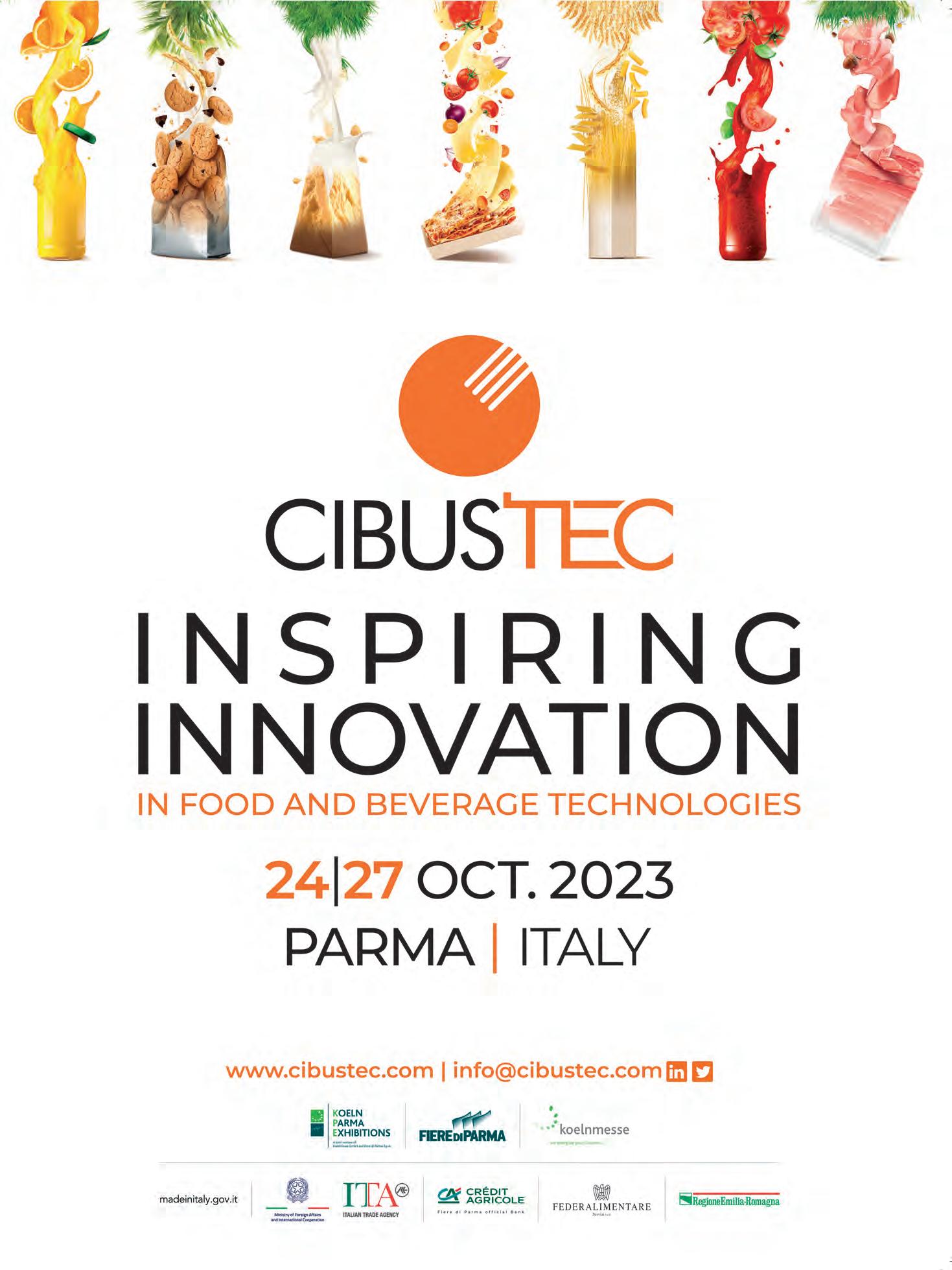
NOP (No-Plastic Program) means we promote eco-friendly plastic substitutes for the packages manufactured on IMA machines. rough the research and testing of alternative processes and materials together with our partners we foster plastic-free and sustainable, compostable, biodegradable or recyclable packaging solutions.
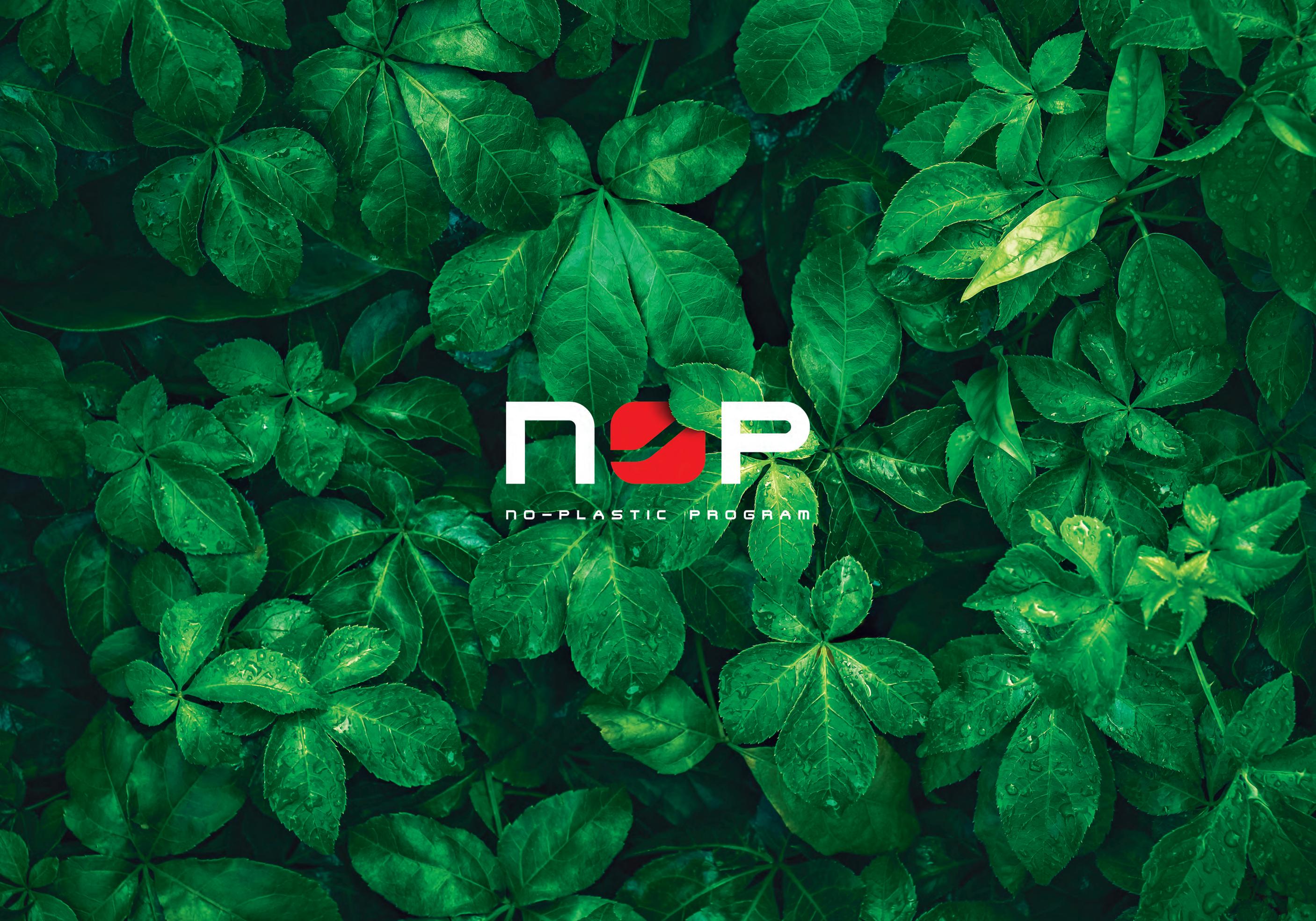
According to these objectives, IMA established OPENLab: the Group’s network of technological laboratories and testing area, dedicated to the research on sustainable materials, technologies and production optimization processes.
Discover more about IMA NOP on ima.it/imazero and IMA OPENLab on ima.it/open-lab
digitale
For the Gen Z, cosmetics becomes digital
29 Lusso in trasformazione tra innovazione dei brand e digitale (AltaGamma)
Luxury is changing, with brand innovation and digital
MIUM PACKAGING
FACTS & FIGURES ]
CONTENTS
UPDATES ON PRINTING, LUXURY AND MORE...
uca Baraldi, Milena Bernardi ine automatiche: stabilito un nuovo primato (Ucima, Mecs) utomatic machines: a new record is set
rativa: elemento chiave egli investimenti (Couchbase) rating efficiency: a key element in
rbara Iascone llaggi di carta & cartone aper and cardboard packaging
arton Group, Europoligrafico , ologna Fiere Cosmoprof)
Federazione Carta Grafica, codesign dall’UE, Messe Frankfurt Italia)
alla Direttiva Macchine al Regolamento Macchine (TÜV Italia) rom the Machinery Directive to the Machinery Regulation
MATERIALS & MACHINERY
opharma ’AI nel rossetto (Marchesini Group, Sea Vision)
resente e futuro del riempimento asettico (IMA Life) resent and future of aseptic filling ultimarket ecnologie specializzate r il riempimento liquidi (ACMA) pecialised technologies for liquid filling ews (Seven Fluss) monomateriali? Saldabili a ultrasuoni (Herrmann Ultraschall) ono-materials? Sealable with ultrasonic ontrollo senza difetti di etichette mballaggi flessibili (Prati) rol of labels and flexible packaging without defects
AUTOMATION & CONTROLS
58 Gamma Hygienic Design più ampia con gli attuatori axenia value (WITTENSTEIN) axenia value actuators extend Hygienic Design line
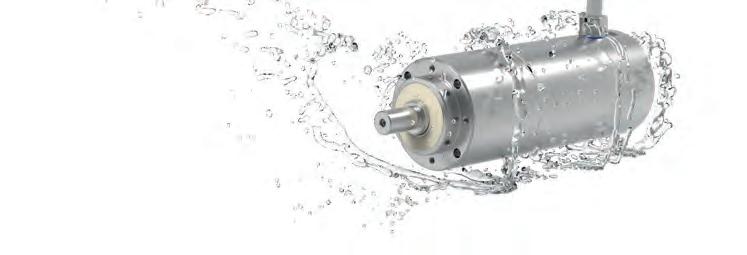
[ INDUSTRY & MANAGEMENT ]
44 News (Goglio Spa, Mega Embalagens, GS1 Italy)
[ ENVIRONMENT & LEGISLATION ]
46 Viene dalla natura, torna alla natura (Ecofoam, Dimontonate) Coming from nature, returning to nature

47 Rimodulati i contributi ambientali per carta, legno e vetro (Conai) Environmental contributions reformulated for paper, wood and glass
59 Eventi e fiere rendono speciale la stagione estiva dell’automazione
Events and trade fair make the summer automation season special Tecnopolimeri ad alte prestazioni per ogni tipo di movimento (igus) High-performance techno-polymers for any type of movement

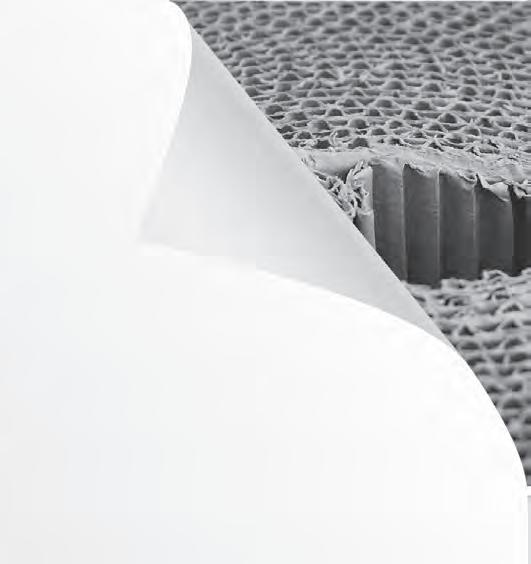
60 L’imaging che guarda al futuro (Image S)
Imaging that looks to the future
50 anni di Renishaw 50 years of Renishaw
61 Sistemi efficienti per la movimentazione (Gruppo Mondial)
Efficient handling systems
Un successo l’AGV di Robox
The Robox AGV is a success
Sensoristica sempre più avanzata (wenglor sensoric)
Increasingly advanced sensors
64 Advertisers & Company index
Sommario SETTEMBRE 2023
9/23 • 5 www.italiaimballaggio.it
Direttore responsabile Stefano Lavorini
Condirettore Luciana Guidotti
Redazione Milena Bernardi, M. Costanza Candi
Pubblicità traffico@packmedia.net
Hanno collaborato Luca Baraldi, Maurizio Cacciamani, Barbara Iascone, Cristina Rossi
Traduzioni GEAR.it S.r.l.
Coordinamento artisti Max Marra & Gianni Valentino
Progetto grafico Studio Grafico Page, Novate Milanese (MI) e impaginazione Vincenzo De Rosa, R. Rossi
Fotolito e Stampa Ancora S.r.l. via B. Crespi 30, 20159, Milano
Numero 9-2023 Settembre 2023 anno 29
Pubblicazione iscritta al n. 555 del Registro di Cancelleria del Tribunale di Milano in data 22/10/94
Iscrizione nel Registro degli Operatori
della Comunicazione n. 9673 Una copia: € 6,50 - Arretrati: € 13 00
Periodicità mensile
Abbonamento Italia per un anno:
Kairos Media Group Srl
Via Fossa Buracchione 84
41126 Modena
Redazione/sede operativa: Via Benigno Crespi 30/2, 20159 Milano, Italia
T. +39 0269007733
redazione@packmedia.net
Sales team (Italia)


Daniela Binario - d.binario@packmedia.net
Massimo Chiereghin - m.chiereghin@packmedia.net

Silvia Lepore - s.lepore@packmedia.net
Bruno G Nazzani - b.nazzani@dativo.it
Nicola Saracino - n.saracino@packmedia.net
Elisa Verzelloni - e.verzelloni@packmedia.net sales@packmedia.net
con la collaborazione di
UCIMA
Unione Costruttori Italiani Macchine Automatiche per il Confezionamento e l’Imballaggio
Ai sensi del Regolamento Europeo sulla Protezione dei Dati proma-pack srl a socio unico - Kairos Media Group srl - MECS srl) saranno improntati ai principi di liceità, correttezza, trasparenza, limitazione delle finalità e della conservazione, minimizzazione dei dati, esattezza, in tegrità e riservatezza, nonché al principio di responsabilizzazione di cui all’art. 2016/679), potrete rivolgervi ai Titolari del trattamento, nelle società del gruppo UCIMA (U.C.I.M.A - proma-pack srl a socio unico - Kairos Media Group srl - MECS srl) scrivendo alla email del gruppo privacy@ucima.it.
Colophon
La
Get your free badge on luxepackmonaco.com GET READY FOR THE MUST-ATTEND LUXURY PACKAGING TRADE SHOW
24.–27.10.2023
STAND K 014
PADIGLIONE 02

E’ FACILE. SERVE FARE
SOLO LA COSA GIUSTA.
Conoscete il vostro potenziale di risparmio nell'applicazione di adesivo?

Il nostro rapporto di ispezione in 8 punti fornisce dati preziosi per prendere decisioni intelligenti.
Vieni a trovarci; richiedi il tuo biglietto omaggio ora: robatech.it/cibustec-2023

Le buone idee
Dalla Ricerca allo Scaffale
Vetrina mensile di soluzioni di imballaggio per comunicare, proteggere e distribuire i prodotti di uso comune.
Arriva da Contital la proposta di una vaschetta richiudibile e dal design curato, ideale per il food delivery di alta gamma.
SOSTENIBILITÀ E LUSSO NEI CONTENITORI ECLIPSE
Sostenibilità, design innovativo e funzionalità: sono solo alcune delle caratteristiche che un packaging deve avere per poter essere proposto al mercato. Negli ultimi anni, però, il diffondersi di nuove tecnologie e la trasformazione delle abitudini di consumo hanno portato buyer e consumatori a richiedere prodotti differenti: non più semplici contenitori, ma imballaggi creativi ed esclusivi, in grado di attirare e interessare il compratore. Analizzando le nuove tendenze di consumo, Contital, ha lanciato la linea
From Contital comes a beautifully designed resealable tray ideal for gourmet food delivery.

THE ECLIPSE CONTAINERS COMBINE SUSTAINABILITY WITH LUXURY
To be marketable, packaging must embody features such as sustainability, innovative design and functionality. However, the proliferation of new technologies and shifting consumer habits in recent years have led buyers and consumers to
LA COLLEZIONE DI CARTE ECOLOGICHE PER PACKAGING DI PREGIO
Favini, cartiera nota per le sue carte ecologiche, presenta la collezione “Paper from our Echosystem”, frutto dell’impegno nella ricerca e sviluppo per l’economia circolare. Il concetto di sostenibilità è centrale per Favini, che si propone di creare materiali adatti a packaging e stampati di alto valore estetico e allo stesso tempo rispettosi dell’ambiente.
Le carte contrassegnate dal logo Paper from our Echosystem possiedono credenziali ecologiche che le rendono altamente sostenibili. Sono realizzate con materie prime innovative, come fibra riciclata, scarti tessili, del cuoio o agro-industriali e fibre alternative come il bambù. Inoltre, le emissioni sono state neutralizzate. Le carte vengono prodotte con energia rinnovabile, sono certificate FSC™, riciclabili e biodegradabili. La gamma Paper from our Echosystem comprende sei tipi di carte: Alga Carta, con alghe; Crush, con scarti agro-industriali; Remake, con sottoprodotti della lavorazione del cuoio; Refit, realizzata con residui dell’industria tessile; Shiro Echo, 100% riciclata; e Tree Free, contenente bambù e cotone.
Eclipse. Si tratta di vaschette in alluminio laccato nero e oro che possono essere richiuse con specifici coperchi in materiale riciclabile, ideali per esaltare sia il servizio di food delivery che di takeaway. I contenitori, adatti sia al forno tradizionale che al forno a microonde, sono idonei al contatto con tutti i tipi di alimenti, anche acidi e salati, garantendo un packaging perfetto per contenere qualsiasi preparazione culinaria. Extra-rigidi e sostenibili al 100%, i contenitori Eclipse si presentano come la soluzione ideale per l’alta ristorazione che non vuole rinunciare a offrire piatti gourmet anche nel servizio d’asporto.
demand different products. No longer satisfied with basic containers, they now want packaging that is both innovative and exclusive, capable of capturing their attention and interest. After analysing the latest consumer trends, Contital has introduced the Eclipse line, featuring elegant black and gold lacquered aluminium containers that can be closed with recyclable lids, providing an ideal solution to enhance both food delivery and takeaway
services. These containers are suitable for use in both traditional and microwave ovens and are safe for use with all types of food, including acidic and salty dishes, ensuring perfect packaging for any gourmet meal. Extra-rigid and 100% sustainable, the Eclipse containers are the ideal choice for the high-end catering industry, ensuring that gourmet meals can be presented with excellence, even in takeaway scenarios.
Il termine “Echosystem” è un gioco di parole: la prima voce (ecosistema) rappresenta un insieme di sostanze in un equilibrio dinamico, proprio come i prodotti della gamma. Echo (eco sonoro) rimanda all’interesse di Favini verso l’economia circolare e quindi nel riutilizzo di materie di scarto, che sarebbero altrimenti destinate alla discarica.
THE COLLECTION OF ECOLOGICAL PAPERS FOR LUXURY PACKAGING
Favini, the paper mill known for its ecological papers, presents the “Paper from our Echosystem” collection, the fruit of research and development for the circular economy. The
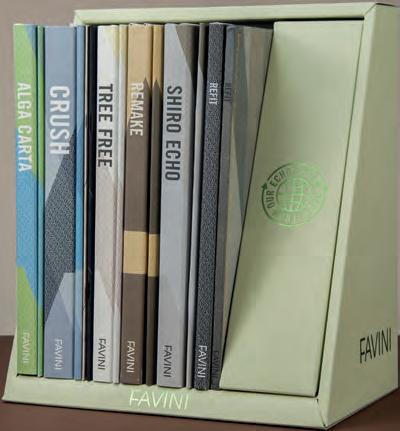
sustainability concept is central for Favini, which aims to create materials suitable for packaging and printed matter which is of high aesthetic value and at the same time environmentally friendly.
The papers marked with the Paper from our Echosystem logo have ecological credentials that make them highly sustainable. They are made with innovative raw materials, such as recycled fibre, textile, leather or agro-industrial waste and alternative fibres such as bamboo. In addition, emissions have been neutralised. The papers are produced with renewable energy, are FSC™ certified and biodegradable.
The Paper from our Echosystem range includes six types of paper: Alga Carta, with algae; Crush, with agro-industrial waste; Remake, with leather processing by-products; Refit, made with industrial textile waste; Shiro Echo, 100% recycled; and Tree Free, containing bamboo and cotton.
The term “Echosystem” is a play on words: the first (ecosystem) refers the group of substances in a dynamic equilibrium, like the products in the range. Echo (sound echo) refers to Favini’s interest towards the circular economy and, therefore, in the reuse of waste materials that would otherwise end up in a landfill.
8 • 9/23 [ POWERED BY BEST PACKAGING ]
www.italiaimballaggio.it
The good ideas
From Research to the Shelf
Powered by Best Packaging
Istituto Italiano Imballaggio
Monthly showcase of packaging solutions to communicate, protect and distribute commonly used products.
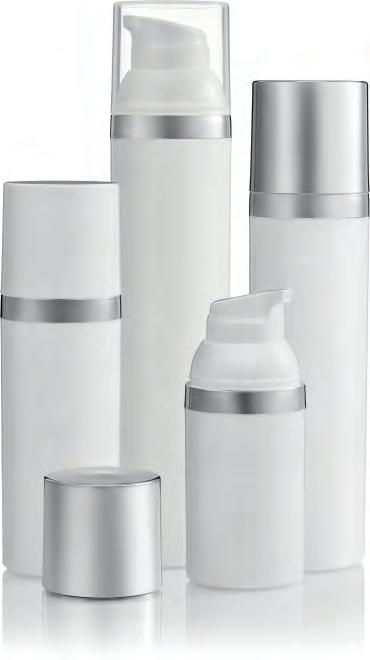
IL VINO DIPINTO. È uscito per i tipi di Ronca Editore, un libro di immagini d’arte singolare, da sfogliare pagina dopo pagina, dove protagonista è “il Vino” raccontato dal pubblicitario/artista Miky Degni in 170 opere, realizzate intingendo il pennello nel vino rosso, appunto. In un’epoca in cui tutto è scandito dagli algoritmi, Miky racconta un percorso concettuale che, dal 2007, l’ha portato a ideare una tecnica personale e innovativa, tornando a usare mani e pennello, per elevare il vino ad arte.
La prefazione del libro è a cura del Professor Stefano Pizzi, docente della cattedra di pittura all’Accademia Di Brera, mentre il testo è raccontato da Marina Martorana (ex giornalista del Corriere della Sera) con date, aneddoti, curiosità anche molto intime che l’artista ha voluto raccontare per mettersi a nudo.
IL VINO DIPINTO (PAINTED WINE). A book with original images published by Ronca Editore, to leaf through page by page, in which “Wine” is the protagonist recounted by the advertiser/artist Miky Degni in 170 works, created dipping the brush in red wine, in fact.

In an epoch in which everything depends on algorithms, Miky narrates a conceptual journey which, since 2007, has led him to develop his own personal ad innovative technique, going back to using hands and brush, elevating wine to art.
The forward to the book is written by Professor Stefano Pizzi, professor of painting at the Brera Academy, while the text is by Marina Martorana (former journalist of the Corriere della Sera newspaper) with dates, anecdotes, and some quite intimate curiosities that the artist has chosen to reveal.
www.italiaimballaggio.it
Design di prestigio e sostenibilità
EMOZIONI PREZIOSE IN STILE LIBERTY
Luxoro ha condotto una sperimentazione sul restyling di alcune linee di prodotti Nashi Argan, immaginando un packaging alto di gamma alternativo che non snaturasse l’essenza e lo spirito del brand.

Nel raccontare questa bella storia di collaborazione, è necessario partire da due dati di fatto. Il primo: i prodotti Nashi Argan sono stati creati per rispondere alle esigenze dei consumatori con semplicità ed efficacia, per regalare a capelli e pelle morbidezza, idratazione e benessere. Il secondo, di carattere più generale: nel mercato della cosmetica è fondamentale esprimere l’essenza del prodotto attraverso un packaging adeguato, che ne rifletta il valore e ne comunichi con chiarezza il prestigio.
Chiamata a dimostrare il rispetto e la validità dei due assunti, Luxoro ha ancora una volta centrato l’obiettivo, attingendo alle proprie competenze in fatto di nobilitazione e coinvolgendo alcuni partner strategici per la fornitura della carta (Fedrigoni Paper), per la stampa del pack in cartone (ISEM Bramucci Srl) e la realizzazione dei flaconi in rPET (Pibiplast).
Nobilitazione come soluzione
La dichiarazione del Team Nashi Argan non lascia dubbi in proposito: «Abbiamo scelto di collaborare con Luxoro, perché rappresenta un punto di riferimento per le soluzioni di nobilitazione: è il partner con il quale poter sperimentare e raggiungere risultati sorprendenti e preziosi».

Dalla sinergia tra il reparto grafico Nashi Argan e le soluzioni di nobilitazione proposte da Luxoro sono dunque nati dei packaging “Limited Edition” non in distribuzione sul mercato, per il Nashi Argan Shampoo 200 ml, il Conditioner 200 ml, l’Instant 150 ml e l’Oil 100ml.
Tutti gli inconfondibili flaconi color ambra sono stati nobilitati con due effetti metallizzati linea LUXOR®, azzurro e oro, che ricoprono parzialmente la superficie.
Il progetto si è completato con la realizzazione cartotecnica di una scatola che riprende le linee e lo stile dei contenitori, per la quale è stata selezionata una carta materica e sensoriale. C’è di più: la sua forma particolare non solo permette di contenere i prodotti, ma di esporli e celebrarli nel migliore dei modi.
Il concept delle grafiche si rifà al Liberty, quindi a un mondo di ispirazione naturalistica dal richiamo esotico, con effetti decorativi suggestivi e di grande eleganza. È infatti caratterizzato da linee sinuose, raffinate, floreali e armoniche, che si sposano perfettamente le une alle altre per la vestizione del prodotto: una lavorazione che conferisce al packaging un grande valore emozionale, coinvolgendo i sensi in un’esperienza di completezza.
10 • 9/23
[ MARKETING & DESIGN ]
Raffinate tecniche di decorazione
Per la nobilitazione del packaging primario dei prodotti Nashi Argan, Luxoro ha utilizzato la decorazione diretta sui vari substrati: un metodo applicativo sofisticato e tecnicamente elaborato, che ha consentito però di eliminare le etichette di carta.
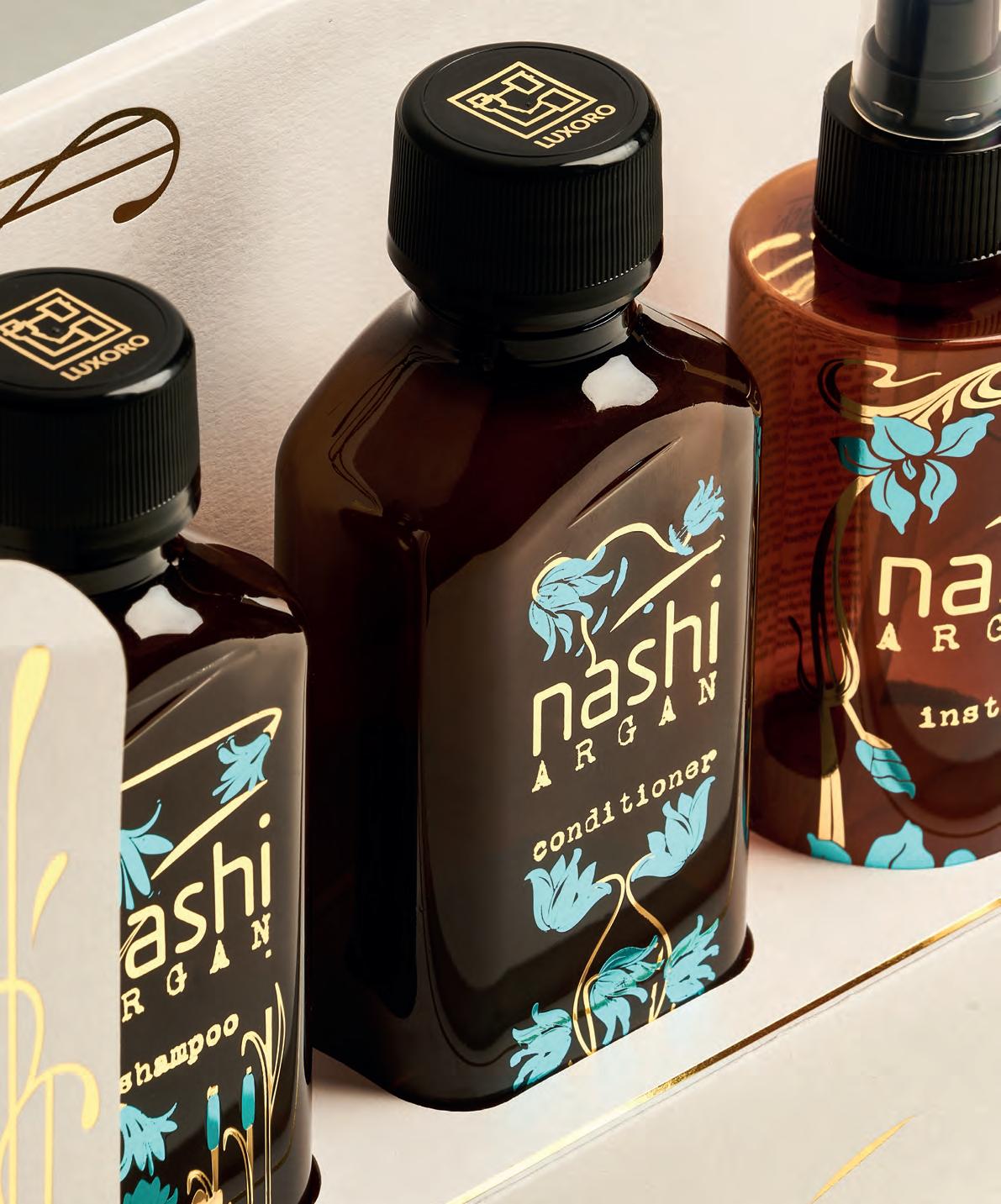
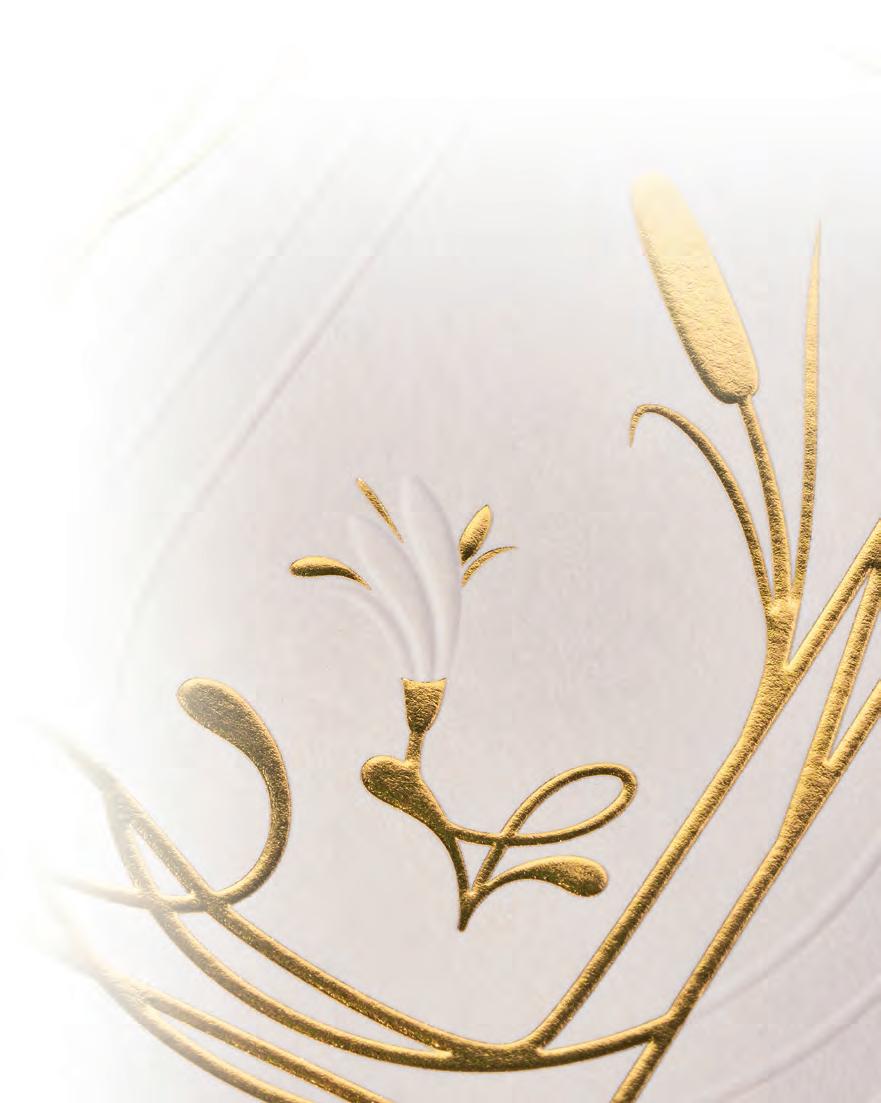
La resa della decorazione sui diversi materiali stampati, vetro e rPET, mantiene allo stesso tempo la sostanza dei colori, la brillantezza e la qualità del risultato finale. Si tratta dunque di soluzioni ineccepibili in termini di qualità e resistenza. La peculiarità del design, poi, contribuisce rendere sempre più riconoscibili i prodotto oltre a richiamare una brand
experience più coinvolgente per i consumatori. Oltre ai flaconi e alle boccette, anche la scatola/ espositore presenta nobilitazioni in oro a caldo, oltre a strutture con rilievi a secco facendola diventare un’opera preziosa, capace di attrarre sia la vista che il tatto.
Da ultimo, la nota green: gli effetti metallizzati utilizzati per le decorazioni non alterano minimamente la riciclabilità del substrato su cui sono stati applicati. In pratica, la stretta collaborazione fra le due realtà ha portato a un risultato eccellente dal punto di vista estetico e grafico, senza tuttavia compromettere la sostenibilità e l’attenzione per l’ambiente.
[ MARKETING & DESIGN ]
9/23 • 11
Prestigious design and sustainability
Precious emotions in Art Nouveau style
Luxoro has carried out experimentation on the restyling of a number of Nashi Argan product lines, imagining an alternative high-end packaging that does not distort the essence and spirit of the brand.
In telling this satisfying story of collaboration, it’s necessary to start from two facts. The first: Nashi Argan products are created to respond to the needs of consumers simply and effectively, to provide softness, hydration and well-being for hair and skin.
The second, of a more general nature: in the cosmetics market it’s fundamental to express the essence of a product through appropriate packaging, which reflects its value and clearly communicates its prestige. Engaged to demonstrate the validity and applicability of the two assumptions, Luxoro has once more hit the target, drawing on its ennobling expertise and involving a number of strategic partners for the supply of the
paper (Fedrigoni Paper), the printing of the cardboard pack (ISEM Bramucci Srl) and the manufacture of the rPET bottles (Pibiplast).
Ennoblement as a solution
The declaration of the Nashi Argan Team leaves no room for doubt: «We have chosen to work with Luxoro because it represents a point of reference for ennobling solutions: it’s a partner with which it’s possible to achieve surprising and valuable results». The synergy between Nashi Argan’s graphics department and the ennobling solutions proposed by Luxoro has led to the “Limited Edition” packaging ideas, not yet on the market, for Nashi Argan Shampoo 200 ml, Conditioner 200 ml, Instant 150 ml and Oil 100 ml.
All the unmistakable amber-coloured bottles have been ennobled with two Luxoro light metallic blue and gold effects, which partially cover the surface.
The design is completed with the paper manufacturing of a box that incorporates the lines and style of the containers, for which a material and sensory paper has been chosen. There’s more: its particular shape not only allows it to contain the products, but displays and celebrates them in the best possible way.
The graphics concept makes reference to Art Nouveau, and therefore to a world of naturalistic inspiration with an exotic appeal, with fascinating decorative effects and great elegance. It is, in fact, characterised by sinuous, elegant, floral and harmonious lines that combine perfectly with each other in the “dressing” of the product: a process that gives the packaging a great emotional value, involving the senses in an experience of completeness.
Refined decoration techniques

For the ennobling of the primary packaging of Nashi Argan products, Luxoro has used direct decoration on
the various substrates: a sophisticated and technically elaborate application method which has, however, permitted the elimination of paper labels. The effect of the decoration on the different printed materials, glass and rPET, maintains, at the same time, the substance of the colours and the brilliance and quality of the final result. They are, therefore, impeccable solutions in terms of quality and resistance. The peculiarity of the design, moreover, contributes to making the product even more recognisable, besides generating a more captivating brand experience for consumers.
Besides the bottles and flasks, also the box/display has hot gold ennoblements, as well as structures with dry reliefs, turning it into a precious item, capable of attracting both sight and touch. Finally, a green touch: the metallic effects used for the decorations do not in any way affect the recyclability of the substrate on which they are applied. In practice, the close collaboration between the two enterprises has led to an excellent result from an aesthetic and graphic point of view without, however, compromising on sustainability and attention towards the environment.

[ MARKETING & DESIGN ]
BERLIN PACKAGING PER 145 VODKA
Una bottiglia tailor made, dal concept creativo e dalle linee moderne: ancora una volta lo Studio One Eleven realizza una soluzione dal design unico e altamente innovativo.
ta come one-stop-shop per marchi di alta gamma di questo settore, combinando elementi di design e innovazione, servizi di industrializzazione e gestione logistica nell’industria del packaging, offrendo prodotti sempre più ecosostenibili, all’avanguardia e dalle massime prestazioni applicative.
Berlin Packaging vuole presentarsi come il miglior partner commerciale del settore e valorizzare l’expertise di Studio One
Eleven - il team interno di professionisti composto da designer, ingegneri ed esperti di marketing - che è in grado di offrire prodotti unici, garantendone la valorizzazione e la personalizzazione, sia per produzioni su larga scala sia per le limited edition o per linee di prodotti premium.
Un esempio di questo tipo di approccio è la bottiglia studiata e realizzata per 145 Vodka, un prodotto che si prefigge di sorprendere, ispirare e deliziare i propri estimatori. Il packaging, di conseguenza, è quindi pensato per essere fuori dagli schemi e rimanere impresso nella mente di chi lo vede: una realizzazione su misura, che ha nella ricerca e nell’innovazione il principale punto di forza.
ORIGINALI E MODERNE, LE BOTTIGLIE 145
VODKA offrono una meravigliosa esperienza tattile e visiva, ma non solo. Garantiscono anche una sorprendente varietà di presentazioni, perché possono essere impilate creando diversi tipi di allestimenti, richiamando l’attenzione di avventori di ristoranti, bar, club o eventi. Il packaging, con la sua forma ottagonale insolita e slanciata, ricorda in qualche modo l’Empire State Building di New York e ha ottenuto un enorme successo a livello internazionale oltre a diversi e importanti riconoscimenti: il RedDot Design Award, premio internazionale dedicato alle eccellenze in product design, communication design e design concepts, nonché l’International DLG Award 2022, concorso organizzato da uno dei più rinomati organismi di controllo degli alimenti presenti in Germania. Da agosto 2023, le bottiglie 145 Vodka sono esposte nei musei Red Dot Design di Essen e di Singapore.
Berlin Packaging, Hybrid Packaging Supplier® di livello mondiale specializzato nella fornitura di packaging di vetro, di plastica e di metallo nonché chiusure, si rivolge a vari mercati (food, beverage, beauty, personal care, industrial e home fragrance). In particolar modo, con un’esperienza di oltre 40 anni nel mercato degli spirits e un modello di business estremamente versatile e agile, l’azienda si presen-
Berlin Packaging for 145 Vodka
Berlin Packaging, the global Hybrid Packaging Supplier ® specialised in the supply of glass, plastic and metal packaging, as well as closures, caters to various markets (food, beverage, beauty, personal care, industrial and home fragrance).
In particular, thanks to its over 40 years’ experience in the spirits market and an extremely versatile and agile business model, the
«Come sempre il nostro obiettivo è di soddisfare il cliente, anche il più esigente, ascoltando le sue necessità e proponendo soluzioni tailor made in grado di differenziarlo dai concorrenti e stupire con un packaging dal design innovativo e altamente personalizzato. In questo caso il nostro Studio One Eleven ha vinto la sfida della creatività, sviluppando il concept del cliente e portando alla produzione in serie un prodotto che non è solo bello da vedere ma anche unico grazie alla possibilità di essere presentato nello spazio in maniera inusuale e con estro» spiega Alessandro Tonoli, CEO di Berlin Packaging Italy.
ORIGINAL AND MODERN, THE 145 VODKA BOTTLES offer an amazing tactile and visual experience, but that’s not all. They also offer a surprising variety of presentations, as they can be stacked creating different types of set-ups, attracting the attention of patrons of restaurants, bars, clubs or events. The packaging, with its unusual and slender octagonal shape, recalls to a certain extent the Empire State Building in New York, and has enjoyed great international success besides obtaining various important recognitions: the RedDot Design Award, the international award dedicated to excellence in product design, communication design and design concepts, as well as the International DLG Award 2022, the competition organized by one of the most renowned food inspection bodies in Germany.
The 145 Vodka bottles will be displayed in the Red Dot Design museums in Essen and in Singapore from August 2023.
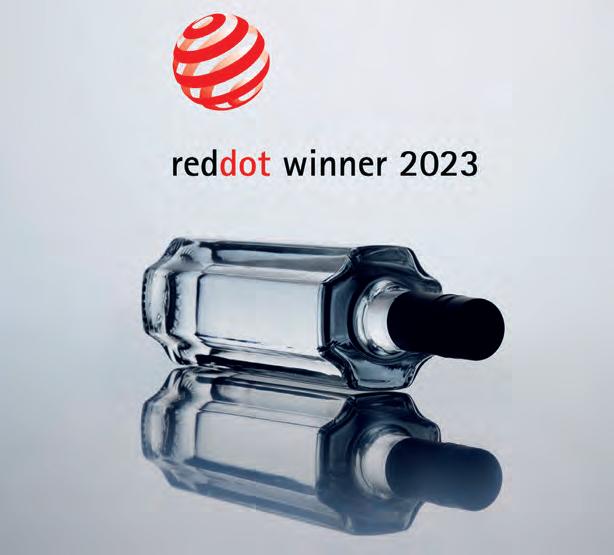
company offers itself as a one-stopshop for high-end brands in the sector, combining elements of design and innovation, industrialization services and logistics management in the packaging industry, offering increasingly eco-sustainable, cutting-edge products with maximum application performance. Berlin Packaging aims to be considered as the best commercial
partner in the sector, exploiting the expertise of Studio One Eleven - the in-house team of professionals composed of designers, engineers and marketing experts - which is able to offer unique products, ensuring their enhancement and personalization both for large-scale productions and for limited editions or premium product lines. One example of this approach is the bottle researched and developed for 145 Vodka, a product which aims to surprise, inspire and delight its admirers. The packaging has therefore been conceived to be “out of the box” and to leave a lasting impression on those who see it: a custom-built product which has its
main strength in research and innovation.
«As always, our aim is to satisfy the customer, also the most demanding, listening to their needs and offering tailor-made solutions which are able to distinguish the product from its competitors and amaze with an innovative and highly personalized design. In this case, our Studio One Eleven has met this creativity challenge, developing the customer concept and taking to series production a product which is not only great-looking but is also unique, with the possibility of being presented in an unusual and stylish way» explains Alessandro Tonoli, CEO of Berlin Packaging Italy.
NEWS [ MARKETING & DESIGN ] 9/23 • 13 www.italiaimballaggio.it
A tailor-made bottle with a creative concept and modern lines: Studio One Eleven has once again developed a solution with a unique and highly innovative design.
PACKAGING EXPERIENCE SINCE 1965
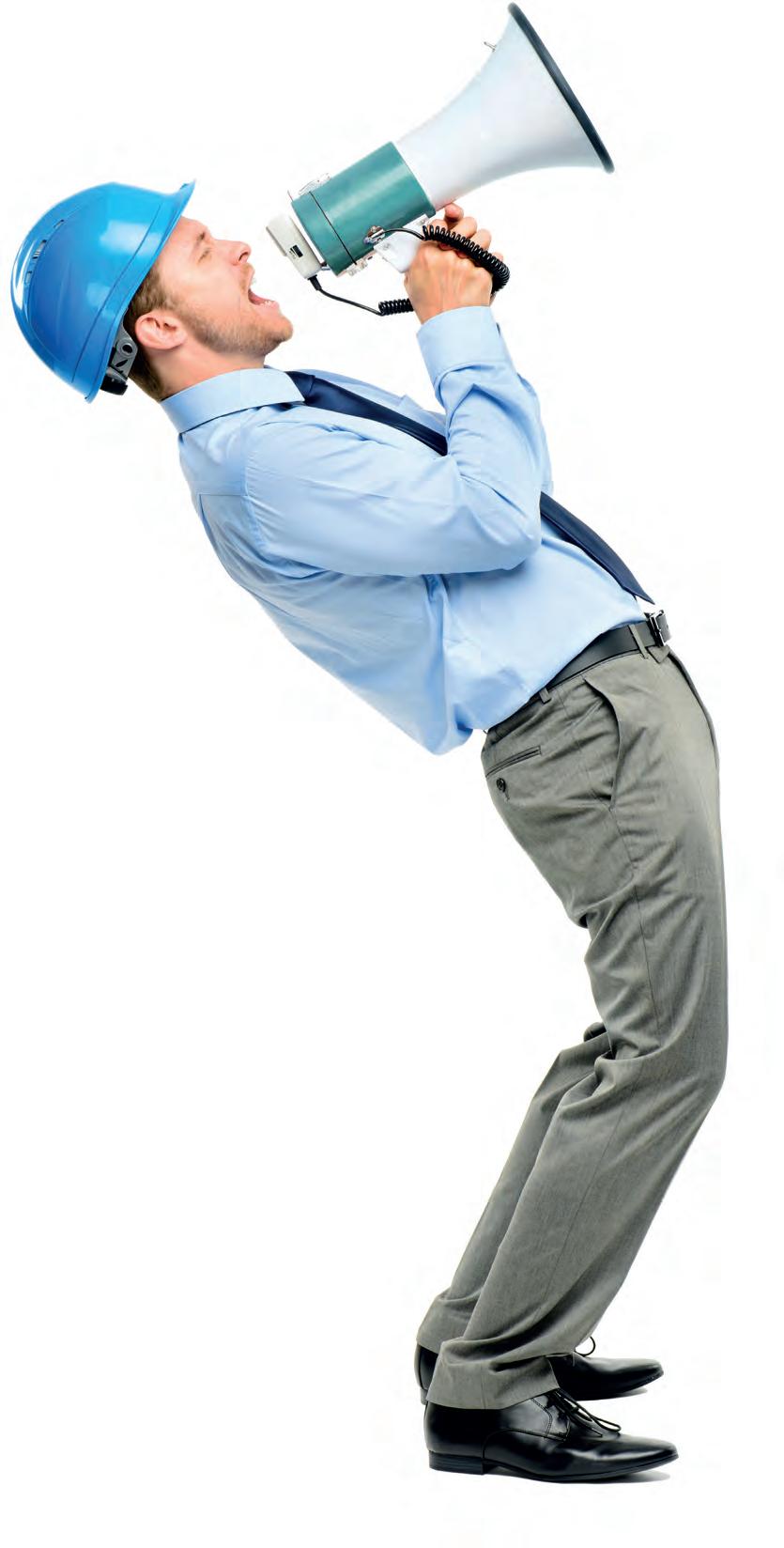
Dal 1965 parti a formato, ricambi, revisioni,

preventive, addestramento operatori. Oltre 20.000 ore/anno di assistenza tecnica.
La
.gbgnudi.it art: lelagilioli79@gmail.com
w w w
manutenzioni
GB Gnudi Bruno SpA - via e. masi 9 40137 bologna (italy) t +39.0514290611 f +39.051392376 www.gbgnudi.it / info@gbgnudi.it
certezza di avere da sempre una INARRESTABILE L'ASSISTENZA DI GB!
VISTI A PACKAGING PREMIÈRE 2023
Quanto è importante la sostenibilità? Quali sono le nobilitazioni più richieste dal mercato? Quali gli investimenti tecnologici indispensabili per continuare a essere competitivi? Abbiamo discusso di questi e altri temi con alcune aziende presenti a Packaging Première, fiera italiana del packaging di lusso, che ci hanno descritto le novità di prodotto e le proprie visioni di mercato.
Il futuro del luxury packaging
Packaging Première & PCD Milan: in programma a Fieramilanocity dal 21 al 23 maggio 2024.
Le due manifestazioni targate Easyfairs sono già proiettate al futuro, forti del successo registrato dall’edizione 2023, che ha visto un’ottima affluenza e un’accurata selezione di espositori, provenienti da tutto il mondo. Packaging Première & PCD Milan si sono riconfermate sinonimo di avanguardia, luogo dove si delineano le tendenze nel packaging deluxe per i settori fashion, beauty, jewelry, fine food, wine & spirits.
A Milano infatti, l’eccellenza è di casa: l’elevato standard qualitativo dei prodotti proposti alla community di operatori del settore e gli approfondimenti offerti attraverso il ricco palinsesto di talk e conferenze, condotti da importanti esperti a livello nazionale e internazionale, rendono la manifestazione unica nel suo genere.
Ne è convinto Pier Paolo Ponchia, Founder e Director di Packaging Première che ha dichiarato: «Il packaging è fondamentale in tutti i settori e in particolar modo in quello luxury e cosmetico: deve essere accattivante, al passo con i tempi, ma soprattutto sostenibile e innovativo. A Packaging Première & PCD Milan la community trova tutto questo, oltre a un ambiente positivo per lo sviluppo del business».
La quinta edizione di Packaging Première (by Easyfairs), tenutasi dal 16 al 18 maggio a Fieramilanocity in concomitanza con la seconda edizione italiana di PCD Milan, ha registrato l’accesso record di oltre 7.850 visitatori - quasi duemila in più rispetto al 2022 - che hanno potuto scoprire le ultime novità di oltre 300 espositori provenienti da Italia, Francia, Germania, Spagna, Regno Unito, Stati Uniti, Bulgaria, Finlandia, Cina e Grecia. Intelligenza artificiale, metaverso, sostenibilità in ambito cosmetico e stampa digitale tra miti e leggende da sfatare sono solo alcuni dei temi trattati nel corso delle 18 conferenze organizzate a latere della manifestazione che delinea il futuro e anticipa le tendenze nel packaging di lusso per i settori moda, cosmesi, gioielleria, fine food e wine&spirits. «Siamo particolarmente orgogliosi di questa edizione, che ha visto un’importante affluenza di visitatori, interessati non solo alle novità e tendenze del settore ma anche a trovare una costante fonte d’ispirazione creativa, confermando il ruolo leader della manifestazione all’interno del mercato italiano», ha dichiarato Pier Paolo Ponchia, fondatore e direttore di Packaging Première.
Economia circolare in fiera. Innovazione e sostenibilità: i temi chiave di questa edizione sono stati applicati anche alle modalità con cui reperire informazioni sugli espositori e i loro prodotti; avvicinando il proprio smart badge a un lettore dedicato era infatti possibile ricevere via e-mail le informazioni richieste. Le indicazioni degli stand solitamente realizzate in forex, materiale plastico costituito da PVC, sono state prodotte in cartone ondulato sostenibile e tutta la carta utilizzata per inviti e cataloghi era certificata FSC. La moquette che rivestiva i corridoi del padiglione
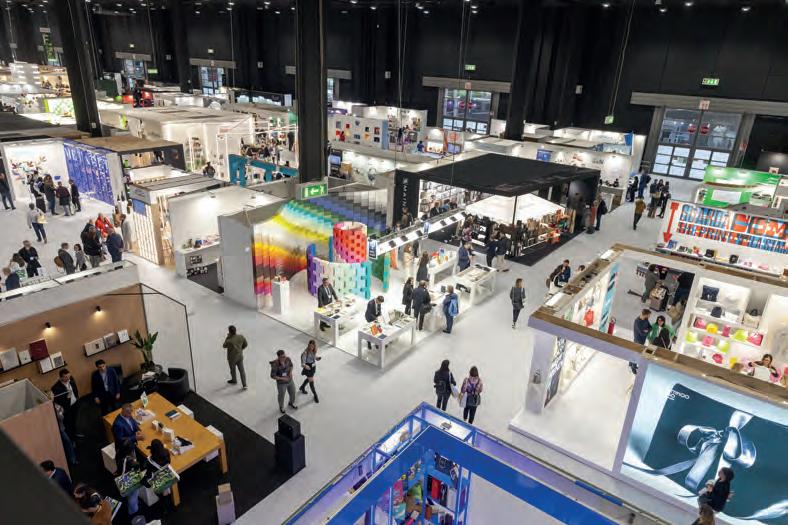
16 • 9/23 www.italiaimballaggio.it [ A PROPOSITO DI... ] PRINTING
Cristina Rossi
zatori - in collaborazione con P&P Promotion, Fontana Grafica, Carlo Gasperini e Oropress - hanno realizzato borracce in edizione limitata, che potevano essere acquistate e riempite nei diversi distributori di acqua gratuita. PRINTING [ A PROPOSITO DI... ]

TESTIMONIANZE DI VALORE
• LA BELLEZZA DELL’IMPERFEZIONE. TELE IN DENIM RICICLATO PER RIVESTIMENTI INNOVATIVI E SOSTENIBILI
«Anche quest’anno la fiera è un’ottima vetrina per le nostre novità», spiega Maria Antonietta Savino, marketing manager di Fontana Grafica, azienda da oltre 40 anni specializzata nella fornitura di materiali da rivestimento di alta qualità - carte, cartoncini, tele, tessuti luxury e materiali di consumo - per il settore delle arti grafiche: stampa, editoria, legatoria, cartotecnica, packaging di lusso, display e piccola pelletteria.

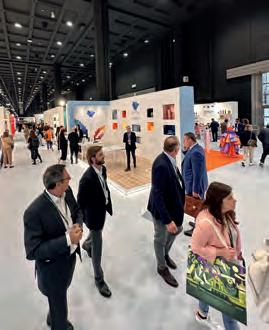
posta da viscosa ecologica e fibre lyocell che ottengono il loro aspetto distintivo da filati di denim jeans riciclati. I fiocchi di denim sparsi senza un ordine preciso su tutto il materiale rendono ogni metro unico e abbracciano la bellezza dell’imperfezione. La combinazione di filati dope-dye, dal ridotto impatto ambientale, crea un effetto multi-tono perfetto per libri, articoli cartotecnici e packaging moderni». Ecojeans non è solo composto da materiali ecologici, ma è anche accoppiato a carta riciclata al 90% e certificata FSC. A produrlo è l’azienda olandese Van Heek Textiles, rappresentata in Italia da Fontana Grafica, ma il denim riciclato viene fornito da un produttore tedesco. Ecojeans è disponibile in un’ampia palette di colori, che include verde, giallo, grigio scuro e bianco. Per il finishing di Ecojeans sono già stati realizzati dei test in offset, in serigrafia, stampa a caldo e anche in digitale e l’esito è stato decisamente positivo.
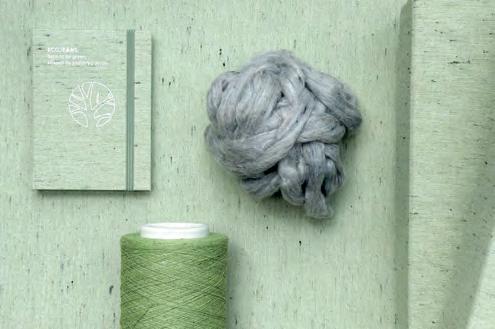
«Il tema centrale quest’anno è la sostenibilità. Uno dei prodotti di cui andiamo sicuramente più orgogliosi è Ecojeans, una nuova tela sostenibile com-
«Parlando di sostenibilità - continua Savino - penso che si dovrebbe prestare attenzione non solo alla riciclabilità, ma anche alla durata dei prodotti. Gli astucci per orologi o gioielli, ad esempio, vengono spesso conservati perché hanno la funzione di proteggere l’oggetto di pregio che contengono. Secondo me, quindi, si potrebbero scegliere dei tessuti prodotti utilizzando materiali riciclati, come ad esempio ecopelli e scamosciati su base in rPET (PET di riciclo)».
• ORIGINALI EFFETTI VISIVI E TATTILI SU ETICHETTE DAVVERO UNICHE
In occasione di Packaging Première, Grafical, azienda fondata nel 1984 a Marano, nel cuore della Valpolicella e specializzata in etichette adesive per il settore del vino, ha realizzato l’edizione speciale di un giornale dal titolo “Press review”, con l’obiettivo di aggiornare i numerosi clienti sulle novità dell’azienda.
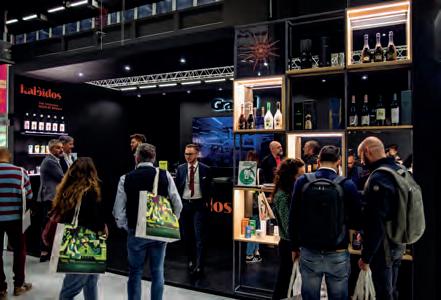
Ad accoglierci allo stand Anna e Sebastiano Lonardi, due giovani e dinamici fratelli che rappresentano la seconda generazione dell’azienda e che ci illustrano le principali novità. Prime fra tutte la nuovissima offset a foglio Heidelberg Speedmaster XL formato 50x70, che ha sostituito una Speedmaster CD74, garantendo prestazioni ancora migliori grazie a un rinnovato sistema di controllo del colore con spettrofotometro in linea e velocità e
capacità di stampa ancor più impressionanti, cui si aggiunge ora una grande attenzione al consumo dei materiali. Il nuovo modello è dotato di un innovativo sistema che permette il recupero della lamina, limitando l’utilizzo del materiale alla sola area nobilitata.
«La possibilità di stampare sulla lamina argento la quadricromia offre un ricco ventaglio di colori», spie-
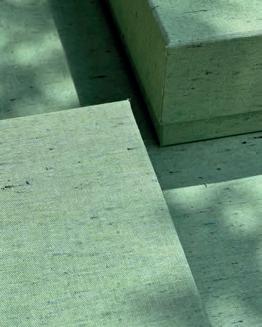
9/23 • 17
al termine dell’evento è stata raccolta e portata in un centro logistico limitrofo alla fiera, pressata in balle e smistata in centri altrettanto vicini per la lavorazione plastica. Infine, per ridurre l’impiego di bottigliette di plastica durante l’evento, gli organizwww.italiaimballaggio.it
ga Sebastiano Lonardi. «Il coldfoil, già presente sulla macchina precedente, è il nostro cavallo di battaglia dal 2008. Lavorando nel mondo del vino abbiamo sempre privilegiato macchine offset perché molto versatili nella gestione dei supporti. Siamo stati pionieri nella stampa digitale installando nel 2008 una delle prime HP Indigo a bobina in Italia e l’anno scorso abbiamo investito per la prima volta in una flexo, una FA-Line di Nilpeter, con una configurazione studiata ad hoc per noi, che assicura lavori di elevata qualità in alte tirature. Oltre ai cinque gruppi flexo sono presenti un gruppo hotfoil per la laminazione a caldo con rilievo e bassorilievo, un gruppo inkjet per la verniciatura ad alto spessore con asciugatura UV Led e il modulo di fustellatura per la sagomatura. L’utilizzo delle carte naturali ci consente di dare valore aggiunto alle etichette e stiamo sperimentando la stampa flexo anche su questi supporti molto richiesti dal mercato wine&spirit, con tirature che superano le 100.000 etichette. Abbiamo visto che la resa della flexo su alcune carte naturali è davvero ottima».
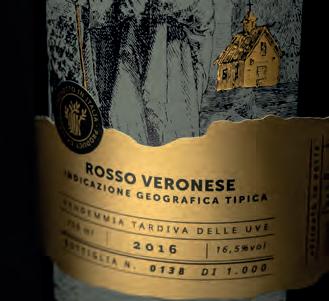
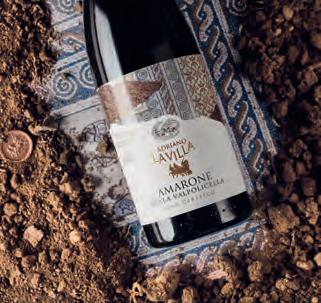

Da qualche anno in casa Grafical è, inoltre, presente la tecnologia Trustseal Spatial FX di Kurz, che fa parte della linea Trustconcept e consiste in una tecnica unica, che crea effetti tridimensionali attraverso l’illusione ottica. Le etichette vengono così impreziosite con effetti olografici personalizzati e innovativi.
«Siamo uno dei tre stampatori in Italia a disporre della tecnologia per stampare questo tipo di lamina a caldo, che viene elaborata dalla casa madre secondo pattern specifici e applicata a registro con un modulo per la stampa a caldo con controllo ottico
personalizzato» spiega con un certo orgoglio Anna Lonardi.
Un servizio offerto da Grafical è la sovrastampa a registro e in alta qualità di etichette, per andare ad aggiornare informazioni, come la data di produzione o dati tecnici, senza dover ristampare l’intera etichetta.
Anche le certificazioni sono un fiore all’occhiello dell’azienda veneta: dal 2012 FSC, per garantire al cliente che la carta utilizzata provenga da foreste controllate e dal 2015 BRCGS Packaging, per certificare la sicurezza e qualità dei materiali destinati al contatto con gli alimenti.
Una tendenza che si sta facendo strada soprattutto nel settore wine&spirit è l’etichetta adesiva multilayer, ottenuta accoppiando diversi materiali per ottenere effetti visivi e tattili originali.
La dotazione tecnologica di Grafical permette l’accoppiamento di supporti diversi (carta con carta, plastica con carta, ecc.) e la realizzazione di etichette uniche.
Inoltre, la brand protection contro eventuali contraffazioni, oggi si può ottenere senza rinunciare allo stile e al design. Anche in questo ambito Grafical unisce la propria dotazione tecnologica all’avanguardia a partnership con fornitori di materiali selezionati per offrire etichette, packaging, sigilli adesivi anticontraffazione e antimanomissione.
Le soluzioni, sviluppate sulla base delle necessità dei clienti, possono integrare microtesti, inchiostri speciali ed effetti olografici per creare design esclusivi e non riproducibili con le tecnologie comunemente disponibili sul mercato.
Ma l’attività di Grafical non si limita più dal 2019 alla stampa di etichette adesive. Infatti, come ci racconta Anna Lonardi, l’azienda ha acquisito al 50% un’azienda di cartotecnica. «Era un nostro terzista con cui lavoravamo bene. Ora produciamo box accoppiati non rivestiti, fustellatura più incollatura e altre lavorazioni. La nostra idea è di abbinare l’etichetta a una scatola, in settori come quello cosmetico.»
• MOCK UP E NOBILITAZIONI, ANDANDO OLTRE LA TRADIZIONE
Nel 1969 il primo uomo andava sulla luna e nasceva Artestampa, un’azienda che ha attualmente sede a Galliate Lombardo (VA) e che si distingue per l’offerta di prodotti che non sono mai standard in settori che spaziano dall’industria alimentare all’editoria e alla grande distribuzione, attraversando tutto il ciclo produttivo, dal mock up alla produzione.
In Artestampa la tradizione si unisce all’innovazione, che include il digitale a livello di stampa (HP Indigo) e di nobilitazione (Scodix) per impreziosire gli astuc-
ci con lucidature, lamine e altre nobilitazioni. «Noi non siamo stampatori tradizionali», ci racconta Erika Ballerio allo stand di Packaging Première, «nel senso che abbiamo sempre privilegiato le nobilitazioni. Quando tutti stampavano in offset noi avevamo già iniziato a stampare in digitale. Siamo stati tra i primi ad avere una HP Indigo in Italia e abbiamo sempre creduto nell’innovazione tecnologica. Utilizziamo quasi tutte le tecniche di stampa, tra cui l’offset UV, e siamo specializzati nella prototipazione. Una delle ultime tecnologie che abbiamo inserito è quella dell’azienda israeliana Scodix, che ci permette di nobilitare tutti gli stampati. È il secondo anno che partecipiamo a Packaging Première e siamo molto soddisfatti
18 • 9/23 www.italiaimballaggio.it
[ A PROPOSITO DI... ] PRINTING
perché è una vetrina importante che ci mette in contatto con brand importanti. Nella nostra produzione spaziamo da stampati di alta qualità a oggetti promozionali, come i tappetini per mouse. Lavoriamo molto per agenzie, aziende e gallerie d’arte, una clientela dunque molto variegata. Molti nostri clienti hanno piattaforme di e-commerce e
noi creiamo per loro gli imballaggi più idonei rispetto alle loro esigenze. Ad esempio, per una nostra cliente che è gemmologa e produce gioielli, abbiamo realizzato una scatola neutra, adatta alla spedizione, senza però privare il cliente finale dell’effetto “wow” legato all’esperienza dell’unboxing. La scatola neutra contiene, infatti, una bellissima scatolina nobilitata e personalizzata, con sede per inserire il certificato di garanzia. È un formato particolare stampato in offset con due colori Pantone in un migliaio di pezzi.»
A Packaging Première Artestampa si è presentata con uno stand molto originale e sostenibile, realizzato con scatole di cartone impilate una sopra l’altra e tenute insieme grazie a pali di legno. «Per noi la sostenibilità non è una scelta, bensì una necessità», spiega Erika Ballerio. «Non esiste un pianeta B, quindi abbiamo il dovere di salvaguardarlo. Tuttavia, ci sono una serie di credenze da sfatare, come ad esempio la convinzione che la carta riciclata sia mi gliore di quella standard. Mi è capitato di assistere a sprechi di materie prime an che da parte di chi si vantava di realizza re una linea di prodotti ecosostenibili.»




NEL TEMPO, DA ACQUISTARE ANCHE ONLINE
Per Auroflex, azienda specializzata da oltre cinquant’anni nella stampa di etichette autoadesive in bobina, il mercato del lusso rappresenta circa l’80% del fatturato.
rigorosamente FSC - o superfici sensoriali, o ancora supporti trasparenti (no label look) che lascino intravedere le sfumature del prodotto, l’obiettivo è quello di rendere l’etichetta accattivante e al tempo stesso resistente nel tempo.
L’uso di materiali e trattamenti specifici per la tenuta all’umidità e al contatto con l’acqua garantiscono all’etichetta la massima resistenza senza intaccarne la resa estetica.
«Nella sua lunga tradizione, la nostra azienda ha saputo mantenere la propria posizione di leadership di mercato grazie alla capacità di innovare e di adattarsi ai cambiamenti del mercato», dichiara Fabio Butera, chairman di Auroflex.
«Negli ultimi 18 mesi abbiamo investito molto nella digitalizzazione dei processi aziendali e nell’implementazione di nuove tecnologie per migliorare l’efficienza e la produttività. Grazie a queste iniziative contiamo non solo di mantenere la nostra posizione sul mercato, ma anche di favorire la nascita e la crescita di tutte quelle aziende che oggi ritengono di non potersi permettere etichette “luxury” e che ne hanno necessità per prodotto e mercato di riferimento.»
L’azienda di Alcamo (TP), fondata dai fratelli Alberto e Francesco Butera negli anni ‘70, è oggi guidata dalla seconda generazione - Giuseppe, Katia, Fabio e Francesca Butera - e realizza etichette per i settori del wine&spirits, food, beer, home care, beauty&personal care esportandole in tutto il mondo.
Che si tratti di vino, olio, conserve, liquori, cosmetici o prodotti per la cura della casa, le etichette vengono realizzate utilizzando i migliori supporti e tecniche di nobilitazione. Siano esse carte naturali - tutte
«Per noi è stata la prima volta a Packaging Première», spiega Claudia Fuschi , responsabile marketing & comunicazione dell’azienda. «Abbiamo scelto di partecipare perché ci sembrava l’occasione giusta per conoscere nuovi designer e approfondire con loro temi legati alle novità del mondo della stampa e della nobilitazione. Siamo più che soddisfatti della fiera, in quanto abbiamo avuto moltissime visite e contatti interessanti, che speriamo si possano tradurre in nuove opportunità per il futuro. In fiera abbiamo presentato, oltre ad alcuni prodotti realizzati per i nostri clienti, originali progetti ideati e stampati da noi. Tra questi, in esclusiva a

9/23 • 19 www.italiaimballaggio.it
• ETICHETTE DI LUSSO E RESISTENTI
PRINTING [ A PROPOSITO DI... ]
Packaging Première, “Save the world”, un progetto che racconta la necessità sempre più impellente di guardare al packaging con l’ottica della sostenibilità. La nostra designer, Clara Giglio, ha realizzato un’etichetta con tre carte sovrapposte - al cui centro è stata applicata una fustella bucata - ricavate da canna da zucchero, mela e uva. Il finishing nobilitativo è stato realizzato grazie alla stampa a caldo e a un rilievo che illustra la volta celeste.»
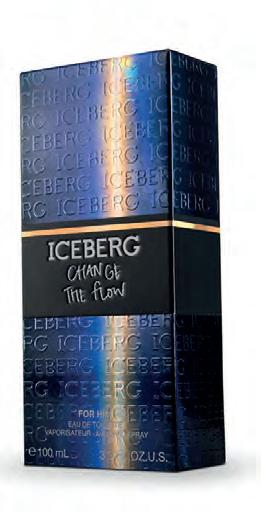

Il mercato del lusso è molto importante per Auroflex, tanto che il payoff dell’azienda è “we print luxury labels”.
«Siamo specializzati nella produzione di etichette complesse e, in un singolo passaggio, le nobilitiamo con varie tecniche: stampa a caldo e a freddo, embossing e debossing, microincisioni, Braille e oro colato, un effetto tridimensionale creato attraverso una serigrafia a rilievo grazie all’utilizzo di un foil adatto. Per le microtirature utilizziamo la stampa digitale a bobina con la possibilità di personalizzare le etichette o arricchirle con piccoli dettagli estetici o numerazioni progressive. Inoltre, accoppiamo o

sovrapponiamo materiali diversi per rendere le etichette ancora più uniche.»
Una vera novità per Auroflex è, infine, InsuperDesign, una piattaforma per l’e-commerce, che integra servizi grafici e di stampa con l’impiego di avanzati sistemi di automazione.
Rappresenta un nuovo modello per il business online, che offre agli utenti la possibilità di personalizzare, grazie a un configuratore 3D ad altissima risoluzione, etichette di lusso e acquistarle direttamente online, riducendo drasticamente i tempi di progettazione grafica e relativa realizzazione finale.
Un servizio di consulenza tecnica specializzato, fruibile da remoto, supporta l’utente nel processo di configurazione, suggerendo le carte e le soluzioni di nobilitazione più idonee a valorizzare il prodotto da etichettare, in base ai parametri impostati inizialmente. Una volta terminata la configurazione, l’utente otterrà una preview altamente realistica del packaging completo, il relativo preventivo e potrà procedere col suo acquisto online.
Vimer Industrie Grafiche Italiane è un’azienda familiare, presente sul mercato europeo dal 1973 grazie allo spirito imprenditoriale di Luigi Merendelli e della sua famiglia.
La sede è a San Giustino (PG), in una terra di mezzo tra Umbria e Toscana, nota per la grande tradizione tipografica.
Vimer è un’impresa dinamica dallo spirito italiano ma con dimensioni europee, tanto che è presente con filiali commerciali in Francia, Germania, Svizzera, Irlanda e Regno Unito, oltre a gestire progetti per clienti in tutti i continenti.
«Quest’anno tagliamo il traguardo dei 50 anni», racconta Valentina Merendelli, amministratore delegato e direttore commerciale dell’azienda. Noi ci occupiamo di litografia e di cartotecnica, quindi sia packaging sia prodotti da punto vendita come espositori, cartelli vetrina e altro. Siamo internazionali: il mercato italiano è il primo per dimensioni e importanza, seguito da quelli francese e inglese. Effettuiamo consegne in tutto il mondo per i nostri clienti europei.
Il nostro core business è rappresentato dal packaging per i settori cosmetico, profumeria e parafarmaceutico. I nostri punti forti sono la creatività e l’innovazione tecnologica, tanto che siamo considerati una delle cinque aziende tecnologicamente più avanzate in Europa. Al momento stampiamo in offset tradizionale e UV; abbiamo appena inserito una nuova linea di stampa. Abbiamo in totale 4 macchine da stampa, con linee complete di produzione e altre linee di
post-stampa. Uno dei nostri punti di forza è che tutte le lavorazioni, dalla prestampa alla logistica, avvengono internamente.
L’atelier manuale è un nostro fiore all’occhiello per tutto quello che riguarda il confezionamento di espositori, prodotti da punto vendita, riempimento degli espositori o di cofanetti.
Attualmente il business internazionale contribuisce per oltre il 60% al fatturato. Siamo nati nel ’73, ma abbiamo iniziato a esportare già nel ’78 in Francia, dove nel ’90 abbiamo aperto Vimer France, seguita da Vimer UK nel 2000, Vimer DE nel 2015 e ora esportiamo anche negli Stati Uniti, visto che l’Italia è un centro importante per la produzione cosmetica e di conseguenza noi, come produttori di packaging, realizziamo prodotti destinati anche ad aziende americane.
Il lusso è una delle nostre aree di competenza, sicuramente molto importante perché ci spinge sempre verso l’innovazione e la ricerca di soluzioni sempre più ecologiche.
Partecipiamo a Packaging Première dalla prima edizione e ogni anno questa manifestazione porta risultati interessanti per il mercato italiano, consentendoci di incontrare sia clienti sia fornitori.
Il nostro slogan è “Verde come Vimer” perché veniamo dal cuore verde dell’Umbria e siamo da sempre attenti alla sostenibilità. Abbiamo pannelli solari a
20 • 9/23 www.italiaimballaggio.it
• DALL’UMBRIA ALL’EUROPA ALL’INSEGNA DELLA SOSTENIBILITÀ
[ A PROPOSITO DI... ] PRINTING
terra che ci permettono di essere indipendenti per il 70% del consumo energetico. Non usiamo olii provenienti da idrocarburi e dal 2013 le nostre macchine sono certificate tutte per essere ecologiche, abbiamo tantissime certificazioni, tra cui Ecovadis Gold dal 2019.
Cerchiamo di fare della sostenibilità un nostro punto di forza, tanto che in questa fiera abbiamo presentato le linee di packaging di lusso ma anche tradizionali e gli espositori per dimostrare che un prodotto può essere bello anche se ecosostenibile.
Utilizziamo carte naturali oppure contenenti materiali di scarto della produzione alimentare, come ad esempio mais, erba, uva. Unendo questi elementi naturali alla cellulosa si creano carte nuove, riciclate o vergini, che ci permettono di certificare il prodotto come riciclabile con la carta o riciclato.
Abbiamo anche la certificazione Carbon footprint, in modo da poter calcolare le emissioni di CO2 alla fine della produzione di un packaging e da lì fare degli studi per migliorare le emissioni.
A livello di nobilitazioni abbiamo tutte macchine
Seen at Packaging Première 2023
Print effects
How important is sustainability? What are the finishings most requested by the market? What technological innovations are essential for continuing to be competitive? We have discussed these and other questions with a number of the companies present at Packaging Première, the Italian luxury packaging fair, in order to discover their new product developments and views on the market.
Rossi
The fifth edition of Packaging Première (by Easyfairs), held from 16 to 18 May at Fieramilanocity in conjunction with the second Italian edition of PCD Milan, recorded the record attendance of over 7,850 visitators – almost two thousand more than in 2022 - who were able to discover the latest developments of over 300 exhibitors from Italy, France, Germany, Spain, United Kingdom, United States, Bulgaria, Finland, China and Greece.
Artificial intelligence, metaverse, sustainability in the cosmetics world and digital printing, including myths and legends to dispel, were some of the themes covered during the 18 conferences organised on the sidelines of the event that outlines the future and anticipates luxury packaging trends for the fashion, cosmetics, jewellery, fine food and wine & spirits sectors.
«We are particularly proud of this edition, which saw a high number of visitors, interested not only in the developments and trends of the sector, but also in the search for creative
inspiration, confirming the leading role of the event in the Italian market », Pier Paolo Ponchia, founder and director of Packaging Première, declared.
An innovative and sustainable fair. The key themes of this edition have also been applied to the ways of obtaining information on the exhibitors and their products: by placing your smart badge close to a dedicated reader it was, in fact, possible to receive requested information via e-mail. The stand signs, usually made in Forex, the plastic material composed of PVC, were this time made of sustainable corrugated cardboard and all the paper used for invitations and catalogues was FSC-certified. The carpeting covering the corridors of the pavilion were collected together at the end of the event and taken to a logistics centre near the fair, pressed into bales and sorted to equally nearby centres for plastic processing. Finally, to reduce the use of plastic bottles during the event, the organisers - in partnership with P&P
a 7 o 8 colori, che ci permettono di creare in un unico passaggio effetti lucidi, opachi, perlescenze, in pratica tutti gli effetti di nobilitazione particolari. Anche nella stampa a caldo e a rilievo effettuiamo lavori particolari, come le microincisioni. Un nostro motivo di vanto è la sovrastampa in offset successiva alla stampa a caldo. Questo permette ai clienti di avere effetti metallizzati di più colori utilizzando una base argento, come si può vedere dall’invito stampato per Packaging Première. Un altro servizio che offriamo ai clienti è la stampa di tag, QR o codici alfanumerici per la rintracciabilità del prodotto.»
The future of luxury packaging
Packaging Première & PCD Milan: scheduled at Fieramilanocity from 21 to 23 May 2024.
The two Easyfairs-branded events are already projected towards the future, boosted by the success enjoyed at the 2023 edition, which saw an excellent attendance and a carefully-studied selection of exhibitors coming from all over the world. Packaging Première & PCD Milan were once more confirmed as being synonymous with state-of-the-art, where the trends of deluxe packaging for the fashion, beauty, jewellery, fine food, wine & spirits sectors are presented. In Milan, in fact, excellence is the norm: the high quality of the products proposed to the community of operators in the sector and the insights offered through the rich schedule of talks and conferences led by important experts at national and international level make the event unique of its kind.
Pier Paolo Ponchia, Founder and Director di Packaging Première is convinced of this, declaring: «Packaging is fundamental in all sectors and, in particular, in the luxury and cosmetics ones: it must be attractive and up-to-date, but above all, sustainable and innovative. The community of operators finds all this at Packaging Première & PCD Milan, besides a positive context for business development».
Promotion, Fontana Grafica, Carlo Gasperini and Oropress – produced water bottles in a limited edition, which could be purchased and filled at the various free water dispensers.
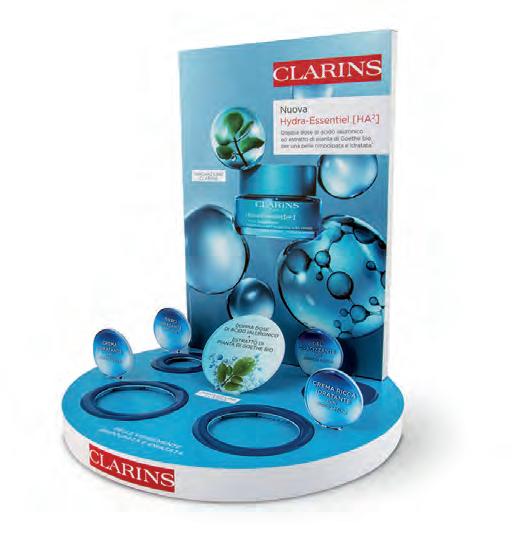
Testimonies of value
• The beauty of imperfection. Recycled denim canvas for innovative and sustainable coverings.
«The fair was an excellent showcase for our new developments again this year», explains Maria Antonietta Savino, marketing manager of Fontana Grafica, the company that for over
forty years has specialised in the supply of high-quality covering materials - paper, cardboard, canvas, luxury fabrics and consumable items - for the graphic arts sector: printing, publishing, binding, paper converting, luxury packaging, displays and small leather goods
«The central theme this year was sustainability. One of the products we are certainly most proud of is Ecojeans, a new sustainable canvas composed of ecological viscose and lyocell fibres that acquire their distinctive appearance of recycled denim jean yarn. The denim flakes scattered
9/23 • 21 www.italiaimballaggio.it
Cristina Rossi Giornalista freelance ed esperta di comunicazione nell’ambito delle tecnologie per le arti grafiche.
Cristina
PRINTING [ A PROPOSITO DI... ]
without a precise order throughout the material make every metre unique and embrace the beauty of imperfection. The combination of dope-dye yearns with a reduced environmental impact creates a perfect multi-tone effect for books, paper products and modern packaging».
Ecojeans is not only composed of ecological materials, but is also combined with 90% recycled and FSC-certified paper. Its producer is the Dutch company, Van Heek Textiles, represented in Italy by Fontana Grafica, but the recycled denim is supplied by a German manufacturer. Ecojeans is available in a wide range of colours, including green, yellow, dark grey and white. Tests in offset, screen printing, hot stamping and also digital have been carried out for the finishing of Ecojeans and the outcome has been decidedly positive.
«Talking of sustainability - continues
Savino - I think that attention should be focused not only recyclability, but also on the duration of products. Watch or jewellery boxes, for example, are often kept because they are used to protect the valuable object they contain. In my opinion, therefore, fabrics produced using recycled materials could be used, such as, for example, faux leather and suede on a rPet (recycled Pet) base».
• Original visual and tactile effects on really unique labels.
During Packaging Première, Grafical, the company founded in 1984 in Marano, in the heart of Valpolicella and specialised in adhesive labels for the wine sector, issued a special edition of a newspaper titled “Press review”, with the objective of updating its numerous customers on the company’s new developments.
Welcoming us at the stand were Anna and Sebastiano Lonardi, two young and dynamic young people representing the second generation of the company, who outlined to us the main innovations. First of all, the brand new 50x70-size sheet offset Heidelberg Speedmaster XL machine, which has replaced the Speedmaster CD74, guaranteeing even better performances thanks to a spectrophotometer in the line and even more impressive printing speed and capacity, and to which is now added great attention towards the consumption of the materials. The new model has been equipped with an innovative system that permits the recovery of the foil, limiting use of
material only to the finished area.
«The possibility of printing on the silver foil with the four-colour process offers a wide palette of colours », explains Sebastiano Lonardi. «Coldfoil, already present on the previous machine, has been a flagship of ours since 2008. Working in the world of wine, we have always preferred sheet offset machines because they are very versatile in the management of the media. We were pioneers in digital printing, installing in 2008 one of the first web-fed HP Indigo printers and last year we invested for the first time in a flexo printing machine, a Nilpeter FA-Line, with a configuration designed ad hoc for us, which ensures high quality results in large print runs. Besides the five flexo units, there are is also a hot foil unit for hot lamination with relief and bas-relief, an inkjet unit for high thickness coating with UV Led drying and a die cutting module for shaping. The use of natural papers allows us to give added value to the labels and we are experimenting flexo printing also on these media which are in great demand in the wine & spirit market, with print runs exceeding 100,000 labels. We have seen that the yield of flexo printing on some natural papers is truly excellent».
For some years now, Trustseal Spatial FX technology by Kurz has also been present in Grafical, forming part of the Trustconcept line and which consists of a unique technique which creates three-dimensional effects through optical illusion. The labels are thus enhanced with personalised and innovative holographic effects.
«We are one of three printing companies in Italy to have the technology to print this type of hot foil which has been developed by the parent company according to specific patterns and applied in register with a module for hot printing with customized optical control», explains Anna Lonardi with a certain amount of pride.
One service offered by Grafical is high quality overprinting of labels, to update information, such as the date of production or technical data, without having to reprint the entire label. Certifications are another element of pride for the Vento company: since 2012, it has obtained FSC certification to guarantee the customer that the paper used comes from controlled forests and since 2015, BRCGS Packaging certification to certify the safety and quality of the materials intended for contact with foods.
One trend which is making headway, especially in the wine & spirit sector, is the multilayer adhesive, obtained by laminating different materials to obtain original and tactile visual effects. Grafical’s technology enables the laminating of different media (paper with paper, plastic with paper, etc.) and the production of unique labels. In addition, brand protection to protect the product from possible counterfeiting, today can be obtained without sacrificing on style and design. Also in this field, Grafical combines its cutting-edge technology capacity with partnerships with suppliers of selected materials to offer anti-counterfeiting and anti-tampering labels, packaging and adhesive seals.
The solutions, developed on the basis of customer needs, can integrate micro-texts, special inks and holographic effects to create exclusive and non-reproduceable designs with technologies widely available on the market.
Since 2019, however, Grafical has no longer limited its activities to the printing of adhesive labels. As Anna Lonardi tells us, in fact, in that year the company acquired 50% of a paperconverting company. «It was a contractor of ours with which we worked well. Now we produce uncoated laminated boxes, and carry out die-cutting and gluing and other processes. Our idea is to combine the label with a box, in sectors such as cosmetics.»
• Luxury labels resistant over time, to be purchased also online For Auroflex, the company specialised for over fifty years in the printing of self-adhesive labels on reels, the luxury market accounts for around 80% of turnover.
The company based in Alcamo (TP), founded by the brothers Alberto and Francesco Butera in the 1970s, is today led by the second generationGiuseppe, Katia, Fabio and Francesca Butera - and produces labels for the wine & spirits, food, beer, home care and beauty & personal care sectors, exporting them throughout the world. Whether concerning wine, oil, preserves, spirits, cosmetics or home care products, the labels are produced using the best media and finishing techniques. Whether natural papersall strictly FSC - or sensorial surfaces, or transparent media (the “no-label look”) that make it possible to see the nuances of the product, the objective
is to make the label attractive and at the same time resistant over time. The use of specific materials and treatments for resistance to humidity and contact with water provides the label with maximum resistance without affecting aesthetic quality.
«In its long tradition, our company has been able to maintain its position as market leader thanks to the ability to innovate and adapt to market changes», affirms Fabio Butera, chairman of Auroflex.
«In the last 18 month we have invested heavily in the digitalisation of business processes and in the implementation of new technologies to improve efficiency and productivity. Thanks to these initiatives, we count not only on maintaining our position as market leader, but also on fostering the establishment and growth of companies that today feel unable to allow themselves “luxury” labels but which they actually need for their product and reference market. »
«It’s the first time for us at Packaging Première», explains Claudia Fuschi, the company’s marketing & communication manager. «We have chosen to participate because it seemed to us the right occasion to discover new designers and explore with them topics related to new developments in the printing and ennoblement world. We are more than satisfied with the fair, as we have had many visits and interesting contacts, which we hope can transform into new opportunities for the future. Besides a number of products manufactured for our customers, we presented in our stand original designs conceived and printed by us. Among these, exclusively at Packaging Première, was “Save the world”, a design that recounts the increasingly urgent need to consider packaging from a sustainable point of view. Our designer, Clara Giglio, has developed a label with three overlapping paper layers - in the centre of which a perforated die has been appliedobtained from sugar cane, apple and grapes. The ennobling finishing was achieved thanks to hot printing and a relief illustrating the celestial vault.» The luxury market is very important for Auroflex, to the extent that the company’s payoff is “we print luxury labels”.
«We are specialised in complex labels and in a single passage we ennoble them with various techniques: hot and cold printing, embossing and
22 • 9/23
www.italiaimballaggio.it [ ABOUT... ] PRINTING
debossing, micro-engravings, Braille and cast gold, a three-dimensional effect created through screen printing in relief thanks to the use of a suitable foil.
For micro print runs we use web digital printing with the possibility of personalising the labels or enriching them with small aesthetic details or sequential numbering. In addition, we laminate or overlay different materials to make the labels even more unique. »
A real new development for Auroflex is, finally, InsuperDesign, an e-commerce platform which integrates graphic and printing services with the use of advanced automation systems. It is a new online business model, which offers users the possibility of personalising luxury labels thanks to a very high-resolution 3D configurator, and purchasing them online, drastically reducing the times for graphic design and final production.
A specialised technical consultancy service, useable from remote, supports the user in the configuration process, suggesting the most appropriate papers and ennobling solutions for enhancing the product to

be labelled, according to the initially set parameters. Once configuration has been completed, the user will have a highly realistic preview of the complete final packaging and the relative cost estimate, and will be able to proceed with their purchase online.

• Mock-ups and ennoblements, going beyond tradition
In 1969 man first walked on the moon and Artestampa was established, a company which is currently based in Galliate Lombardo (VA) and which stands out for its offer of products that are never standard, with regards to the entire production cycle, from the mock-up to production, in sectors ranging from the food industry to the publishing industry and mass retail. In Artestampa tradition combines with innovation, which includes digital for printing (HP Indigo) and ennobling (Scodix) to embellish cases with polishing, foils and other ennoblements.
«We are not tradition printers», Erika Ballerio tells us at the Packaging Première stand, «in the sense that we have always concentrated on ennoblements. When everyone was
printing in offset we had already begun to print in digital. We were among the first to have an HP Indigo in Italy and we have always believed in technological innovation. We use almost all the printing techniques, including offset UV and we are specialized in prototyping. One of the latest technologies that we have introduced is the one offered by the Israelian company, Scodix, which allows us to ennoble all the prints. It’s the second year that we have taken part in Packaging Première and we are very satisfied because it’s an effective showcase that puts us in contact with important brands. In our production we range from high-quality prints to promotional objects, such as mouse pads. We work a lot for agencies, companies and art galleries, a very varied clientele, therefore. Many of our customers have e-commerce platforms and we create for them the most suitable packaging for their needs. For example, for our customer who is a gemmologist and produces jewels, we have developed a neutral box, suitable for shipping, without, however, depriving the final customer of the “wow” effect associated with
the unboxing experience. The neutral box contains, in fact, a beautiful ennobled and personalised little box, with a space for inserting the guarantee certificate. It’s a particular shape printed in offset with two Pantone colours in a thousand pieces.»
At Packaging Première, Artestampa took part with a very original and sustainable stand, set up with cardboard boxes stacked one on top of another and held together and wooden poles.
«For us, sustainability is not a choice, but a necessity», explains Erika Ballerio. «There is no planet B, and so we have the duty to safeguard it. There are, however, a series of beliefs to dispel, such as, for example, the conviction that recycled paper is better than standard paper. I have seen the wasting of raw materials also by those who boast of developing a line of eco-sustainable products.»
• From Umbria to Europe in the name of sustainability
Vimer Industrie Grafiche Italiane is a family company, present on the European market since 1973 thanks



VERIMEC è una società del gruppo MASSILLY, uno dei leader nella produzione di imballi in banda stagnata e capsule twist. VERIMEC unisce alla qualità dei suoi prodotti la garanzia di un servizio accurato che applica supportando il cliente nella scelta della migliore soluzione industriale. Dal design alla capsula personalizzata, alla macchina più razionale ed efficiente, studiando il mastice adeguato alle esigenze di pastorizzazione odi sterilizzazione, fino al controllo del processo di chiusura.


A garanzia che gli alimenti siano conservati ad arte.

PRINTING [ ABOUT... ]
DAL 1911
Verimec Srl, Via Matilde Serao 37, 20081 Abbiategrasso (MI) Tel. +39 0294960293 - verimec@massilly.com www.verimec.it - www.massilly.com
to the entrepreneurial spirit of Luigi Merendelli and his family. The head office is in San Giustino (PG), in an area where Umbria and Tuscany meet, known for its great typographic tradition.
Vimer is a dynamic enterprise with an Italian spirit but with European dimensions, having sales branches in France, Germany, Switzerland, Ireland and the United Kingdom, besides managing projects for customers in all the continents.
«This year we arrive at the milestone of 50 years’ activity», recounts Valentina Merendelli, CEO and sales director of the company. «We deal with lithography and paper converting, and so both packaging and sales outlet products such as displays, window signs and others. We are international: the Italian market is the first for size and importance, followed by the French and English markets. We make deliveries throughout the world for our European customers.
Our core business is packaging for the cosmetics, perfumery and parapharmaceutical sectors. Our strong points are our creativity and technological innovation, to the extent that we are considered one of the five most technologically advanced companies in Europe. At present we print in traditional offset and UV; we have just introduced a new printing line. We have a total of 4 printing machines, with complete production lines and other post-printing lines. Another of our points of strength is that all the processing, from preprinting to logistics, are carried out internally. The manual workshop is a key asset for everything regarding the packaging of displays, sales outlet products and the filling of displays or boxes.
The international business currently contributes over 60% of the turnover. We started in 1973, but we began to export already in 1978 to France, where in 1990 we opened Vimer France, followed by Vimer UK in 2000, Vimer DE in 2015 and now we also export to the United States, given that Italy is an important centre for the production of cosmetics and consequently we, as producers of packaging, manufacture products also intended for American companies. Luxury if one of our areas of expertise, certainly very important as it constantly pushes us towards innovation and the search for increasingly ecological solutions.
We have taken part in Packaging Première from the first edition and every year this event brings interesting results for the Italian market, allowing us to meet both customers and suppliers.
Our slogan is “Green like Vimer” because we come from the green heart of Umbria and have always been attentive to sustainability. We have solar panels on the ground that allow us to be independent for 70% of our energy consumption. We don’t use oils coming from hydrocarbons and since 2013 our machines have all been certified as ecological; we have many certifications, including EcoVadis Gold since 2019.
We try to make sustainability a strong point, and so at this fair we presented not only luxury packaging lines but also traditional ones and displays for demonstrating that a product can be beautiful as well as sustainable. We use natural papers or ones containing waste materials from food production, such as, for example, maize, grass and grapes. Combining these natural elements with cellulose we create new papers, recycled or virgin, which allow us to certify the product as paper recyclable or recycled.
We also have the Carbon footprint certification, so as to be able to calculate the emissions of CO2 for the production of a packaging and from there to carry out studies for the improvement of emissions. With regards to ennoblements, all our machines are 7- or 8-colour ones, allowing us to create in a single passage glossy, opaque, pearlescent effects, in practice all the special ennobling effects. We also carry out special works in hot stamping and relief, such as micro-engravings. One of our sources of pride is offset overprinting following hot-printing. This allows customers to have metallised effects in different colours using a silver base, as can be seen from the printed invitation for Packaging Première.
Another service that we offer to customers is the printing of tags, QR or alpha-numeric codes for product tracking.»
Cristina Rossi Freelance journalist and communication expert in the field of technologies for graphic arts.
Every product has its packaging. Everyone has…
The Voice of Italian Packaging
KAIROS MEDIA GROUP SRL - Via Fossa Buracchione 84 - 41126 Modena Redazione di Milano Via Benigno Crespi 30/2 - 20159 Milano - Tel 02,69007733 - redazione@packmedia.net www.italiaimballaggio.it - www.packmedia.net - packagingspeaksgreen.com
Webmagazine
Webmagazine
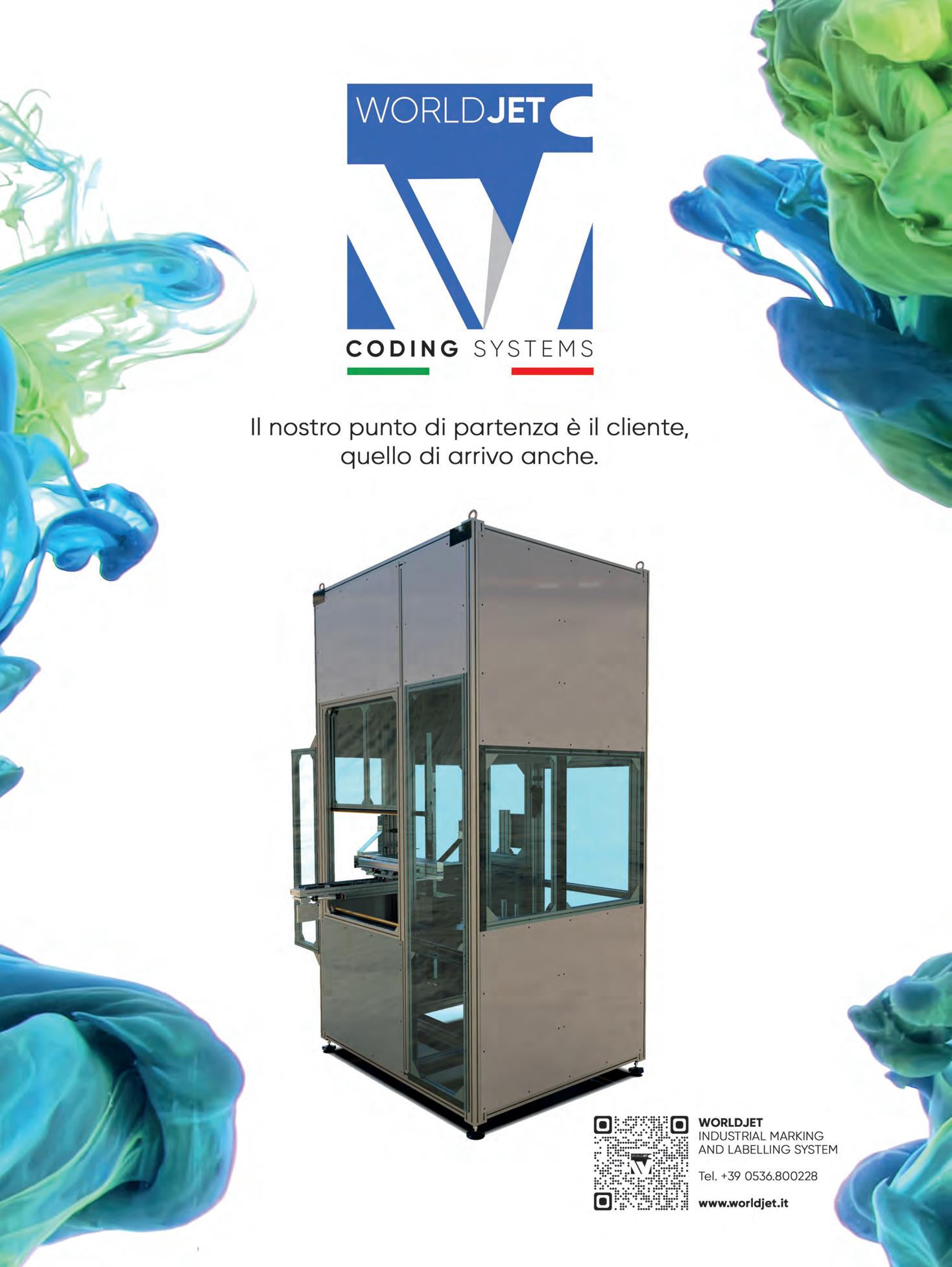
PER LA GEN Z, LA COSMETICA PASSA PER IL DIGITALE
Se ne è parlato a Cosmoprof nell’ambito dei CosmoTalks in una tavola rotonda a tema “Cosmetic art: Design your brand difference” organizzata in collaborazione con KANTAR, agenzia di analisi di dati, consulenza e strategia aziendale e con la moderazione di Jennifer Weil, European Beauty Editor di WWDWOMEN’S WEAR DAILY.

www.italiaimballaggio.it
[ MARKETING & DESIGN ] 26 • 9/23
E-commerce e digital shopping sono in costante crescita; è quanto afferma il recente report dedicato all’industria cosmetica di McKinsey & Company, multinazionale di consulenza strategica, che traccia le previsioni di sviluppo del settore fino al 2027. Secondo gli analisti, tra il 2022 e il 2027 l’e-commerce crescerà del 12% annuo, arrivando a coprire un quarto del volume complessivo di vendite per il beauty.
Lo sviluppo dei canali digitali ha radicalmente trasformato l’approccio aziendale e il rapporto tra marchio e consumatore, riportando al centro delle strategie il concetto di brand equity che rende fondamentale per le aziende rendersi riconoscibili sul mercato, grazie ad una condivisione di valori, emozioni e tratti distintivi che aiutano a costruire un’identità.

Ogni tipologia di azienda deve quindi strutturare un percorso di marketing e storytelling ad hoc, perché non esistono regole universali per tutti. Per un marchio di fragranze, ad esempio, ottenere l’attenzione del consumatore è più sfidante rispetto a un brand di skincare, perché per una profumazione non si può far leva su concetti come efficacia e performance.
Fragranze, beauty e make-up guidano la classifica degli hashtag su TikTok.
Uno tra gli strumenti oggi più performanti, e allo stesso tempo ricco di potenzialità ancora poco sfruttate, è sicuramente TikTok, il canale social che ha registrato forti tassi di crescita in questi anni con oltre 1 miliardo di utenti mensili in tutto il mondo.
L’hashtag “beauty” registra 1,5 miliardi di visualizzazioni mentre, “make-up” ne conta 3,75 miliardi, ma sono gli hashtag dedicati alle fragranze a raggiungere il dato più alto, con 25 miliardi di visualizzazioni.


Il 67% degli utenti ha oltre 25 anni, affermando il canale come migliore mezzo per interagire con le generazioni più giovani, ma non solo. La grande sfida delle aziende consiste infatti nel creare contenuti adatti ai propri target, spesso anche trasversali a obiettivi diversi. In questo contesto diventa fondamentale il ruolo dei protagonisti delle piattaforme social, i creator
I creator, leva fondamentale di comunicazione con la Gen-Z. Il digitale è l’universo di riferimento per le giovani generazioni e, conseguenza, è un territorio di riferimento per la crescita futura. Il rapporto di McKinsey & Company evidenzia infatti come entro il 2023 la Gen-Z rappresenterà un quarto della popolazione mondiale, con un potere di spesa fino a
33 trilioni di dollari. Si tratta quindi di un target imprescindibile per le aziende cosmetiche, e il loro accesso più costante alle tecnologie digital determina un approccio completamente diverso rispetto ai consumatori più adulti.
Le giovani generazioni sono infatti particolarmente attente ai contenuti veicolati dagli influencer, che non sono più solo personaggi patinati protagonisti del jetset. Quelli che hanno più successo oggi sono persone comuni, con le quali i consumatori possono entrare in sintonia perché condividono gli stessi ideali e le stesse difficoltà.
9/23 • 27 www.italiaimballaggio.it [ MARKETING & DESIGN ]
ss
s
For the Gen Z, cosmetics becomes digital
as part of the CosmoTalks in a round table on the theme “Cosmetic art: Design your brand difference” organised in partnership with KANTAR, the data analysis, business consultancy and strategy agency, moderated by Jennifer Weil, European Beauty Editor of WWD - WOMEN’S WEAR DAILY.
E-commerce and digital shopping are constantly growing; this was affirmed in a recent report dedicated to the cosmetics industry by McKinsey & Company, the strategic consultancy multinational, which sets out development forecasts for the sector up to 2027. According to the analysts, between 2022 and 2027, e-commerce will grow by 12% per year, arriving at a quarter of the overall volume of beauty sector sales.
The development of digital channels has radically transformed business approach and the brand-consumer
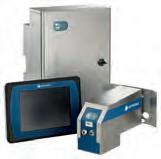
relationship, orienting strategies towards the concept of brand equity, making it essential for companies to be recognizable on the market, through a sharing of values, emotions and distinctive traits that help to construct an identity.
Every type of company must, therefore, create an ad-hoc marketing and storytelling approach, because there are no universal rules for everyone. For a fragrance brand, for example, acquiring the attention of the consumer is more challenging with respect to a skincare brand, because concepts such as
nimax La cura della tua Linea è

efficacy and performance cannot be exploited for a fragrance.
Fragrances, beauty and make-up lead the classification of hashtags on TikTok. One of the most successful instruments today which is, at the same time, full of potential, is certainly TikTok, the social channel that has grown strongly in recent years with over 1 billion monthly users throughout the world. The “beauty” hashtag has 1.5 billion visualisations, while, “make-up” has 3.75 billion; the most impressive figure, however is for fragrances, with 25 billion visualisations.

67% of users are under 25, confirming the channel as the best way to interact with the younger generations, but not only. The big challenge for companies is, in fact, creating contents suitable for their targets, often cross-sectional and with different objectives. In this context, the role played by the protagonists of the
social platform, so-called creators, becomes crucial.
Creators, a fundamental means of communication with the Gen-Z. Digital is the reference universe for the young generations and, consequently, a key area for future growth. The McKinsey & Company report highlights how by 2023 Gen-Z will represent a quarter of the world population, with a purchasing power of up to 33 trillion dollars. It is, therefore, an essential target for cosmetic companies, and their more constant use of digital technologies implies a completely different approach compared to more adult consumers.
The young generations are, in fact, particularly attentive to the content conveyed by influencers, who are not only glamorous protagonists of the jet-set. The influencers that have most success today are normal people, who consumers can identify with because they share the same ideals and problems.
Codifica e Marcatura Ispezione e Controllo Labelling

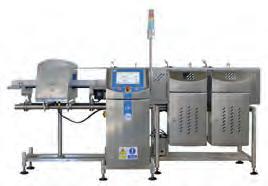
QUANDO SCEGLIETE NIMAX, ACQUISTATE MOLTO PIÙ DI UNA TECNOLOGIA.
• Avete un intero sistema 4.0 che si integra perfettamente con la vostra linea di produzione e che dialoga con il vostro network.
• Siete supportati da un team di tecnici con grande esperienza nei diversi settori industriali in tutte le fasi valutative e operative.
• Usufruite di un servizio after sales che anticipa le vostre esigenze.

[ MARKETING & DESIGN ]
Sistema Combinato CW3 – IQ4H
contactcenter@nimax.it
This argument was discussed at Cosmoprof
nimax.it
l’unico disegno che abbiamo in mente.
ESCLUSIVISTA Marcatore a getto termico d’inchiostro Gx150i
Marcatore inkjet a grande carattere Cx350i
Padiglione 2 Stand H 026
Siamo presenti al
Lusso in trasformazione tra innovazione dei brand e digitale
Lo studio Altagamma Consumer&Retail Insight 2023, curato dalla Fondazione e da Boston Consulting Group, tratteggia il quadro di un mercato esigente, in forte espansione e trasformazione, propenso all’uso del digitale in tutte le fasi dell’esperienza d’acquisto.


Secondo la nona edizione dell’Altagamma Consumer and Retail Insight, presentato di recente a Milano, i consumatori più alto-spendenti sono circa 20 milioni, su un totale di 370 con capacità di spesa elevate. Si tratta di un segmento più disponibile all’acquisto della media con un incremento atteso al +40% rispetto alla media propensione all’acquisto True-Luxury. I mercati più dinamici in questo senso sono Cina (+50%) e Stati Uniti (+40%), mentre
l’Europa segue a distanza con un trend al -40%. Dopo il ritorno ai livelli pre-pandemici dei beni di lusso personali, anche il lusso esperienziale sta riprendendo a correre con un tasso di crescita che si prevede valga il 57% del valore totale del mercato nel 2023.

La geopolitica del lusso Guardando al mercato più performante, la Cina, sono significative anche le opportunità generate dall’ecosistema digitale, con il 46% degli acquisti do -
Dal 1963
Certificazione M.O.C.A. per materiali ed oggetti a contatto con alimenti
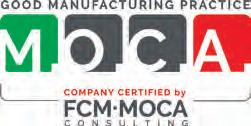

La qualità Karr nasce da più di cinquant’anni a servizio dell’industria: ALIMENTARE, DOLCIARIA, CONSERVIERA, LATTIERO-CASEARIA, FARMACEUTICA , COSMETICA , CHIMICA e PETROLCHIMICA
mestici dei consumatori cinesi effettuati su canali online, dove i consumatori alto spendenti sostengono il mercato con circa il 40% della spesa totale, mentre i giovani al di sotto dei 30 anni e i consumatori delle città lower-tier contribuiranno sempre più alla crescita del settore. Anche il Medio Oriente rappresenta una promettente opportunità; qui il mercato del lusso personale è valutato circa 15 miliardi di euro nel 2023 e atteso a 30-35 miliardi di euro nel
9/23 • 29 www.italiaimballaggio.it
MARKETING & DESIGN Tel. +39 02 45712849 Fax +39 02 45707603 karrit@tin.it info@karr-italiana.it www.karr-italiana.it
Una qualità ben dosata
AN NIVERSARIO
2030 con Emirati Arabi Uniti (EAU) e Regno dell’Arabia Saudita (KSA) come principali motori della crescita regionale.
Customer experience
tra digitale e canale fisico


La mappatura che BCG ha effettuato su 2.600 customer journey di lusso, ha permesso di indagare alcuni elementi significativi per rendere l’esperienza offerta dai brand soddisfacente per i clienti True-Luxury.
Al centro dell’attenzione il digitale, ritenuto meno soddisfacente del canale fisico, che nel lusso è due volte più apprezzato rispetto al mass market. Questo a dispetto di una tendenza dei consumatori verso l’uso dei dispositivi e del digitale, visti come veicoli di
arricchimento delle proprie esperienze d’acquisto in cui, tuttavia, i marchi di lusso riscontrano una soddisfazione al di sotto del 50% rispetto al mass retail e ai player pure online. Secondo i ricercatori, negli ultimi decenni, i brand si sono concentrati nel perfezionare l’esperienza in negozio, ritrovandosi notevolmente in ritardo nell’online.
Per migliorare l’esperienza in un contesto nel quale oltre il 50% dei customer journey sono multicanale, i brand sono chiamati a un solido percorso di innovazione, che includa nuove soluzioni come, ad esempio, la Generative AI che offre vantaggi estesi a tutta la catena del valore, con un impatto molto elevato tra marketing, personalizzazione e customer experience.
Luxury is changing, with brands’ innovation and digital
According to the ninth edition of Altagamma Consumer and Retail Insight, recently presented in Milan, there are around 20 million highest-spending consumers, out of a total of 370 with a high-spend capacity.
It’s a segment with an aboveaverage propensity to spend, with an expected increase of +40% compared to the average TrueLuxury purchase propensity. The most dynamic markets in this sense are China (+50%) and United States (+40%), while Europe follows at a distance with a trend of -40%.
After the return to pre-pandemic levels for personal luxury goods, experiential luxury is also starting to run again, with a growth rate expected to be worth 57% of total market value in 2023.
The geopolitics of luxury
Looking at the best-performing market, China, the opportunities generated by the digital ecosystem are also significant, with 46% of domestic purchases of Chinese consumers made online, in which high-spending consumers sustain the market with around 40% of the total expenditure, while youngsters below 30 and consumers in lower-tier cities will contribute increasingly more to the growth of the sector.
The Middle East also represents a promising opportunity; here the personal luxury market is valued at around 15 billion euros in 2023 and is expected to be 30-35 billion in 2030, with the United Arab Emirates (UAE) and the Kingdom of Saudi Arabia (KSA) the main drivers of regional growth.
Inoltre, questa tecnologia potrebbe estendere il “trattamento VIC” (Very Important Consumer) anche agli altri clienti aspirazionali del lusso, che rappresentano 350 milioni di consumatori.
Nuove generazioni, nuovi canali
In linea con l’esigenza di innovare prodotti, canali e formule, occorre ricordare l’impatto del ricambio generazionale.
Nel 2022, infatti, tra Millennial e Gen Z, i giovani hanno rappresentato un valore che supera i 200 miliardi di euro, con un raddoppio previsto entro il 2026, quando saranno il 75% del mercato.
Ecco perché, in un quadro così dinamico, i brand devono tenere conto delle caratteristiche che distinguono i diversi target su base geografica, anagrafica e sociologica, studiando strategie di ingaggio diversificate, con una personalizzazione dell’offerta, della comunicazione, dei canali e degli strumenti.
Customer experience between digital and the physical channel
The mapping that BCG has carried out on 2,600 luxury customer journeys, has made it possible to investigate some significant elements for making the experience offered by brands satisfying for True-Luxury customers. Particular attention is given to digital, considered less satisfying than the physical channel, which in the luxury sector is appreciated twice as much as in the mass market.
This is despite the trend for consumers to move towards the use of devices and digital, seen as vehicles for enriching purchasing experiences in which, however, luxury brands experience satisfaction below 50% compared to mass retail and pure online operators. According to the researchers, in the last few decades, brands have concentrated on enhancing the store experience, finding themselves noticeably behind in the online channel. To improve the experience in a context in which over 50% of customer journeys are multichannel, brands are called on undertake a solid path of innovation,
which includes new solutions such as, for example, Generative AI, which offers advantages extending to the entire value chain, with a very high impact on marketing, personalisation and customer experience. In addition, this technology could extend the “VIC (Very Important Consumer) treatment” also to other aspirational luxury customers, numbering 350 million consumers.
New generations, new channels
In line with the need to innovate products, channels and formulae, it’s also necessary to remember the impact of the generational shift. In 2022, in fact, between Millennials and Gen Z, young people represent a value exceeding 200 billion euros, which is expected to double by 2026, when they will represent 75% of the market. This is why, in such a dynamic scenario, brands must take account of the characteristics that distinguish the different targets according to geography, age and social status, studying diversified engagement strategies, with personalisation of the offer, communication, channels and tools.
30 • 9/23 www.italiaimballaggio.it
[ MARKETING & DESIGN ]
The Altagamma Consumer&Retail Insight 2023 survey, drawn up by the Foundation and by the Consulting Group, paints a picture of a demanding market, strongly growing and transforming, oriented towards the use of digital in all phases of the purchase experience.
MACCHINE AUTOMATICHE: STABILITO UN NUOVO PRIMATO
Dopo il 2021, il comparto italiano delle macchine per il packaging chiude un altro anno record, superando la soglia degli 8,5 miliardi di euro (+3,6%). Bene l’export e ancora meglio il mercato domestico.
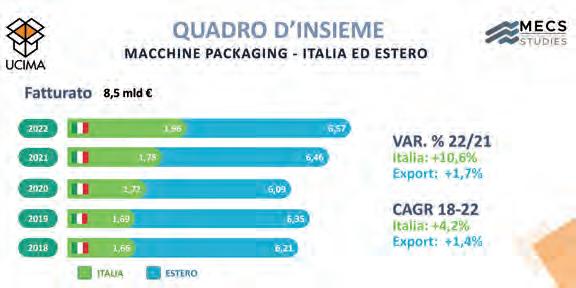

Il presidente Cavanna: “Abbiamo fatto qualcosa di straordinario”.
«Se ci si guarda indietro, abbiamo davvero fatto qualcosa di straordinario» ha commentato il Presidente di Ucima Riccardo Cavanna. «Il 2022 ha vissuto di alti e bassi e di forti tensioni internazionali, dalla supply chain all’incremento dei costi al conflitto in Ucraina, ma siamo ugualmente riusciti a crescere sfondando per la prima volta il tetto degli 8 miliardi e mezzo».
Cresce l’export, ma il mercato interno performa a doppia cifra
Punto di forza ormai consolidato, l’export (incidenza del 77% sul fatturato totale) ha registrato un incremento dell’1,7% generando un volume d’affari di 6,57 miliardi di euro.
Èun nuovo record storico quello che l’industria italiana delle macchine automatiche per il confezionamento e l’imballaggio ha messo a segno nel 2022: gli 8,5 miliardi di fatturato (+3,6% sul 2021, già anno record) confermano la solidità del settore e il trend di crescita costante negli anni. Basti pensare che nel periodo 2019-2022, il giro d’affari ha conquistato mezzo miliardo di euro in più di business sui mercati globali anche rispetto allo scenario pre-Covid.
I dati, contenuti nell’11 a Indagine Statistica Nazionale di settore, realizzata dal Centro Studi Mecs - Ucima, sono stati diffusi in occasione dell’Assemblea annuale dei Soci, svoltasi nella sede di Villa Marchetti a Modena, il 10 luglio scorso.
La forte resilienza di questa nicchia del made in Italy
è da ricercare nella grande capacità di diversificare i mercati presidiati: la debolezza della domanda europea, e ancor più di quella extraeuropea (causata dal conflitto russo/ucraino), è stata compensata dalla crescita in tutto il continente americano e in quello africano. Così come lo stop del “settore food” è stato bilanciato dalla corsa a doppia cifra del “cosmetico”, con un effetto traino delle tecnologie del secondario e del fine linea per tutti i comparti e mercati. Il comparto conta un universo di 616 aziende che occupano 37.753 addetti (+3,9% e 1.402 unità in più sul 2021).
Il podio delle aree geografiche è rimasto immutato: con 2,52 miliardi di ricavi l’Unione Europea si conferma la principale area di destinazione delle macchine made in Italy e assorbe il 38,4% dell’intero export. Segue l’Asia con 1,23 miliardi di euro, pari al 18,8% del totale delle performance internazionali del settore. Terzo gradino per il Nord America, con 1,14 miliardi e una quota del 17,4%. Seguono Europa Extra-UE (650 milioni di euro), Sud America (456 milioni), Africa (447 milioni) e Oceania con 119 milioni.
Ma è in patria che, a differenza del passato, i costruttori di tecnologie per il confezionamento e l’imballaggio hanno raccolto le maggiori soddisfazioni, con un incremento delle vendite del 10,6% sul 2021, pari a 1,96 miliardi di euro (1,78 miliardi nell’esercizio precedente) e un’incidenza sul fatturato totale del 23%.
www.italiaimballaggio.it 9/23 • 31
[ FACTS & FIGURES ]
A cura di Luca Baraldi (Mecs-Ucima) e Milena Bernardi
India e Turchia scendono in campo
Rispetto ai principali concorrenti Germania e Cina - che, va sottolineato, nel periodo 2012-2022 è cresciuta dell’11,2% - l’Italia si trova a fare i conti con altri due Paesi che stanno aumentando le proprie quote di mercato oltreconfine.
Turchia e India, cresciute rispettivamente a un CAGR 2012/2022 del +11% e +5,7% hanno infatti conquistato nuovi spazi, e in alcuni mercati esteri, già vendono più dell’Italia. Nel 2022, l’India ha esportato macchine per 265 milioni di euro (93 milioni nel 2012), mentre la Turchia ha toccato la soglia dei 208 milioni contro i 120 milioni del 2012.
Confermata la leadership dell’alimentare
Con 2,72 miliardi di euro, anche nel 2022 il food si posiziona al primo posto tra i settori clienti (-0,6% sul 2021) con una propensione all’export del 73,2%
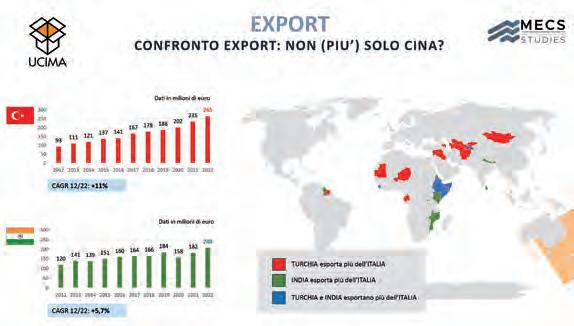
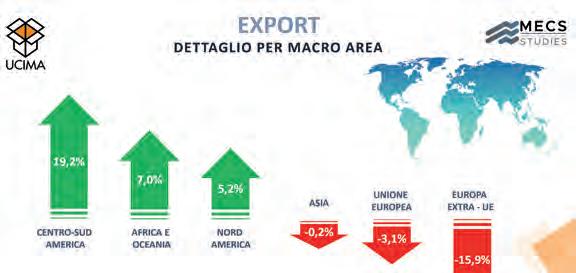
e un’incidenza del 31,9% del fatturato totale. Il beverage, al secondo gradino, si irrobustisce e cresce di 8 punti percentuali raggiungendo quota 2,12 miliardi (24,8% sul giro d’affari complessivo). Terzo classificato il settore tissue e altro con 1,59 miliardi (18,6% del totale), in rialzo del 6% (notevole incremento nel mercato domestico, pari al +27,8%). Seguono il pharma (1,43 miliardi; +1,1%), il cosmetico (378 milioni; +10.7%), chimico e home care (302 milioni; +5.1%).
Suddividendo i comparti tra food e non food, si evidenzia una crescita del +3% e +4,5% rispettivamente.

Fatturato per tipologia produttiva
La famiglia delle macchine per il packaging primario resta preponderante con il 50,2% della distribuzione del fatturato e vendite pari a 4,28 miliardi (-0.3%), seguita dal segmento del fine linea, labelling e attrezzature ausiliarie con 2,43 miliardi e dal packaging secondario che assorbe il rimanente 21,4% (+6.9%). Sebbene in contrazione del 2%, la categoria che prevale in termini di fatturato è quella delle macchine formatrici-riempitrici-chiuditrici (FFS) e termoformatrici con un valore di 1,7 miliardi di euro, il 79,2% realizzato all’estero. A crescere di più sono invece le macchine per palettizzare, depalettizzare e assicurare il carico a pallet che realizzano un volume d’affare di 1,3 miliardi (+18,3% sull’anno precedente) seguite da astucciatrici e incartonatrici (1,3 miliardi e +11,4%). Perdono smalto le riempitrici-chiuditrici (-6,8%), le avvolgitrici (-2,3%) e i dispositivi di ispezione e controllo (-12,5%).
Le aspettative per il 2023

Secondo le rilevazioni Mecs-Ucima, nei primi sei mesi del 2023 le vendite dei costruttori di macchine automatiche per il confezionamento hanno registrato un forte rimbalzo. Il fatturato è cresciuto del 13,5% sul primo semestre 2022 e il portafoglio ordini a +4,5%. Le aspettative per l’intero esercizio restano ottimistiche, pur in presenza di segnali poco incoraggianti: è svanito l’effetto rimbalzo post Covid, perdurano le incertezze geopolitiche, tassi di interesse e inflazione impattano sulla domanda globale. Il clima di fiducia degli imprenditori resta alto con il 47% che stima una crescita del business, il 42% prevede stabilità e l’11% teme un calo.
«Gli indicatori a nostra disposizione per il 2023 delineano un rallentamento della domanda globale» continua Cavanna. «Ciò che desta preoccupazione per il futuro prossimo deriva da alcuni freni agli in-
www.italiaimballaggio.it [ FACTS & FIGURES ] 32 • 9/23
vestimenti: il nuovo regolamento europeo degli imballaggi (che non ci convince) e il suo iter di approvazione, l’aumento dei tassi di interesse, l’incertezza che ancora insiste in alcune aree del mondo e la mancanza di nuove politiche 4.0».
Crescite attese tra il 2023 e il 2026 Nel periodo di riferimento, le previsioni del centro
Automatic machines: a new record is set
After 2021, the Italian packaging machine sector closes another record year, exceeding the threshold of 8.5 billion euros (+3.6%). Exports were good, but the domestic market was even better. Chairman Cavanna: “It’s an extraordinary achievement”.
By Luca Baraldi (Mecs-Ucima) and Milena Bernardi
The Italian automatic machine industry for packing and packaging achieved a new record in 2022: a turnover of 8.5 billion euros (+3.6% on 2021, already a record year) confirms the solidity of the sector and the constant growth trend of recent years.
Suffice to say that in the period 2019-2022, turnover increased by more than half a billion euros on the global markets compared to the pre-Covid figures. The data, contained in the 11th National Statistical Survey of the sector, carried out by the Mecs-Ucima Research Centre, were disclosed during the Annual General Meeting, held in Villa Marchetti in Modena, on 10 July. The reason for the strong resilience of this Made in Italy niche sector lies in the great ability to diversify the markets covered: the weakness of European demand, and even more so, that of non-EU Europe (caused by the Russia/ Ukraine conflict), was offset by growth throughout the American market and in Africa. In the same way, the stop in the “food sector” was offset by the double-figure growth of the “cosmetics” sector, with a driving effect of secondary technologies and the end-of-line for all sectors and markets. The sector has a galaxy of 616 companies employing 37,753 workers (+3.9% and 1,402 workers more against 2021).
«If we look back, we did something really incredible» commented the Chairman of Ucima Riccardo Cavanna. «2022 the sector experienced highs and lows and strong international tensions, from the supply chain to the costs of the Ukraine conflict, but we
managed all the same to grow, breaking the ceiling of 8,5 billion for the first time ».
Exports are growing, but the domestic market is flying at double figure growth
Exports, the by now well-consolidated point of strength (impact of 77% on total turnover) recorded an increase of 1.7%, generating a turnover of 6.57 billion euros.
The podium of the geographic areas remains unchanged: with 2.52 billion of revenues, the European Union is confirmed as the main destination area of Made in Italy machines and accounts for 38.4% all exports. Then comes Asia with 1.23 billion euros, equal to 18.8% of the total of international revenues of the sector. Third on the podium is North America, with 1.14 billion and a share of 17,4%. The top three are followed by non-UE Europe (650 million euros), South America (456 million), Africa (447 million) and Oceania with 119 million.
It is at home, however, that, in contrast with the past, manufacturers of technologies for packing and packaging have gained the most satisfaction, with an increase in sales of 10.6% on 2021, equal to 1.96 billion euros (1.78 billion in the previous year) and an impact on total turnover of 23%.
India and Turkey enter the game
Compared to the main competitors Germany and China – which, it should be underlined, grew by 11.2% in the period 2012-2022 – Italy finds itself having to compete with two other
studi Mecs-Ucima evidenziano un incremento medio annuo della domanda in tutte le aree geografiche, eccezion fatta per l’Europa Extra EU (-1,1%). A segno più l’Unione Europea (+3,5%), Asia (+4,4%), Nord America (+3,9%), Sud America (+3,4%), Africa/Oceania (+5,3%). I dati delineano quindi uno scenario positivo per il futuro delle esportazioni made in Italy.
countries that are increasing their overseas market share.
Turkey and India, grown respectively to a CAGR 2012/2022 of +11% and +5.7% have, in fact, conquered new space, and in a number of foreign markets already sell more than Italy. In 2022, India exported machines for 265 million euros (93 million in 2012), while Turkey reached the threshold of 208 million against 120 million in 2012.
Food sector leadership confirmed
With 2.72 billion euros, in 2022 the food sector was once more in first place among sector customers (-0.6% against 2021) with a propensity to export of 73.2% and an impact of 31,9% of total turnover. Beverages, in second place, has strengthened, and has grown by 8 percentage points to reach a value of 2.12 billion (24.8% of overall turnover). Third classified is the tissue and other sector with 1.59 billion (18.6% of the total), up 6% (a significant increase in the domestic market, equal to +27.8%). This is followed by pharma (1.43 billion; +1.1%), cosmetics (378 million; +10.7%), chemical and home care (302 million; +5.1%). Breaking down the sectors between food and non-food, there was a growth of +3% and +4.5% respectively.
Turnover by production type
The family of machines for primary packaging remains predominant, with 50.2% of the turnover and sales equal to 4.28 billion (-0.3%), followed by the end-of-line segment, labelling and auxiliary equipment with 2.43 billion and by secondary packaging which absorbs the remaining 21.4% (+6.9%). Although contracting by 2%, the dominant category in terms of turnover is that of form-fill-seal systems (FFS) and thermoforming machines with a value of 1.7 billion euros, 79.2% achieved abroad. Machines for palletizing, depalletizing and securing the load to pallets grew more, achieving a turnover of 1.3 billion (+18.3% against the previous year), followed by
cartoning and case packing machines (1.3 billion and +11.4%). Performing less well were filling-sealing machines (-6.8%), wrapping machines (-2.3%) and inspection and control machines (-12.5%).
2023 forecasts
According to Mecs-Ucima’s analysis, in the first six months of 2023, the manufacturers’ sales of automatic packaging machines experienced a strong boost. Turnover grew by 13.5% against the first quarter of 2022 and the order portfolio by +4.5%.
Expectations for the entire year remain optimistic, albeit in the presence of some not very encouraging signals: the post-Covid rebound effect has vanished, geopolitical uncertainties remain, interest rates and inflation are affecting global demand. The level of confidence of businessmen remains high, however, with 47% that expect a growth in business, 42% foresee stability and 11% fear a downturn.
«The indicators available to us for 2023 show a slowing down in global demand» continues Cavanna. «Concern for the near future derives from a number of obstacles to investments: the new European packaging regulation (which is not very convincing) and its approval procedure, the increase in interest rates, the uncertainty that still persists in some areas of the world and the lack of new 4.0 policies ».
Expected growth between 2023 and 2026
In the reference period, the forecasts of the Mecs-Ucima Research Centre show an annual increase in demand in all geographical areas, with the exception of Non-EU Europe Extra EU (-1.1%). Positive forecasts are given for the European Union (+3.5%), Asia (+4.4%), North America (+3.9%), South America (+3.4%), Africa/Oceania +5.3%. The data therefore paint a positive picture for the future of Made in Italy exports.
[ FACTS & FIGURES ]
www.italiaimballaggio.it 9/23 • 33
Efficienza operativa: elemento chiave negli investimenti
Secondo la VI indagine di Couchbase sono agilità e responsabilizzazione degli sviluppatori a guidare i progetti di applicazioni moderne e trasformative. Prevista una spesa media di 33 milioni di dollari per i progetti di innovazione nei prossimi 12 mesi.
Couchbase, Inc. (NASDAQ: BASE), azienda specializzata in piattaforme di database in cloud, ha pubblicato i risultati della sua sesta indagine sulla trasformazione digitale condotta tra i responsabili IT rivelando che, in linea con il cambiamento degli obiettivi di trasformazione digitale, le aziende continuano a investire in modo significativo nella modernizzazione dell’IT.

Al centro dell’attenzione c’è l’efficienza operativa che influenza il modo in cui le imprese investono nelle iniziative di trasformazione: per quasi il 60% degli intervistati, infatti, l’obiettivo principale è legato al miglioramento dell’efficienza aziendale, con priorità di investimento IT per il 2023 nella creazione di applicazioni moderne.
Una ricerca su larga scala dedicata al mondo IT. Condotta su un campione di 600 decisori IT senior, l’indagine ha rile-
Operating efficiency: a key element in investments
vato che le aziende prevedono di investire in media 33 milioni di dollari nei prossimi 12 mesi. La ricerca ha posto l’accento su alcune interessanti conclusioni come quelle legate al rapporto tra modernizzazione e miglioramento della resilienza aziendale. Secondo il 57% degli intervistati a livello globale, e il 62% in Italia, infatti, l’obiettivo principale della digitalizzazione è rispondere alle sfide di un’economia globale in evoluzione.
Dove guardano gli investimenti. Secondo i responsabili IT, inoltre, c’è una forte pressione per l’adozione di nuove tecnologie come il serverless computing (indicato dal 42% a livello globale e dal 44% italiano), tecnologie low o no code (39% globale e 54% italiano) e edge computing e IoT (40% globale e 26% italiano) mentre l’AI viene ancora ritenuta all’inizio del suo percorso che la vedrà protagonista in futuro. Tuttavia, secondo
Couchbase, i team IT guardano già all’adozione di modelli linguistici di grandi dimensioni (LLM) come ChatGPT (35% globale e 28% italiano).
Il ruolo degli sviluppatori nel percorso di innovazione. La produttività degli sviluppatori viene ritenuta un task di primo piano grazie anche al loro ruolo di acceleratori di innovazione presso le aziende. Da un canto, infatti, queste figure professionali spingono per lo sviluppo agile e l’innovazione (44% globale, 46% in Italia) ma anche per creare più applicazioni capaci di soddisfare le esigenze dei clienti (44% in entrambi i contesti). La ricerca ha dimostrato che il 38% dei team IT globali si sta concentrando su progetti di modernizzazione tangibili, a dimostrazione che la tecnologia continua a estendere i confini della trasformazione aziendale, a guidare l’innovazione e ispirare applicazioni di nuova generazione.
According to the 6th Couchbase survey, the drivers of modern transformative application projects are agility and accountability. An average investment of 33 million dollars for innovation projects is expected in the next 12 months.
Couchbase, Inc. (NASDAQ: BASE), the company specialised in cloud database platforms, has published the results of its sixth survey on the digital transformation carried out among IT managers, finding that companies are continuing to invest significantly in IT modernization in line with changes in digital transformation goals. The focus of attention is on operating efficiency, which affects the way enterprises invest in transformation initiatives: for almost 60% of those interviewed, in
fact, the main objective is linked to an improvement in business efficiency, with IT investment in 2023 prioritised on the creation of modern applications.
A large-scale study dedicated to the IT world. Carried out on a sample of senior IT decision-makers, the survey found that companies intend to invest on average 33 million dollars in the next 12 months. The research focused on a number of interesting conclusions, such as those linked to
the relationship between modernisation and an improvement in business resilience. According to 57% of interviewees at global level, and 62% in Italy, in fact, the main objective of digitalisation is to respond to the challenges of an evolving global economy.
Allocation of investments. According to the IT managers, moreover, there’s strong pressure for the adoption of new technologies such as serverless computing (indicated by 42% at global level and by 44% of the Italians), low- or no-code technologies (39% global and 54% Italian) and edge computing and IoT (40% global and 26% Italian), while AI is still considered to be at the start of its journey, becoming a protagonist in the future. According to Couchbase, however, IT teams are already considering the adoption of
large language models (LLM) such as ChatGPT (35% global and 28% Italian).
The role of developers in the innovation journey. Enhancement of developers’ productivity is considered a prominent goal, thanks to their role as innovation accelerators in companies. On the one hand, in fact, these professional figures are pushing for agile development and innovation (44% global, 46% in Italy) but also for creating more applications able to meet customer needs (44% in both cases). The research has demonstrated that 38% of global IT teams are focusing on tangible modernisation projects, showing that technology continues to extend the boundaries of business transformation, driving innovation and inspiring a new generation of applications.
34 • 9/23 www.italiaimballaggio.it [ FACTS & FIGURES ] NEWS
IMBALLAGGI DI CARTA & CARTONE
Resta uno dei comparti più rappresentativi dell’industria del packaging, sia in termini di tonnellate che di fatturato: nel 2022 gli imballaggi cellulosici hanno rappresentato il 33% della produzione globale di packaging, mentre in termini di fatturato hanno superato il 23,5%, percentuali abbastanza costanti nel tempo.
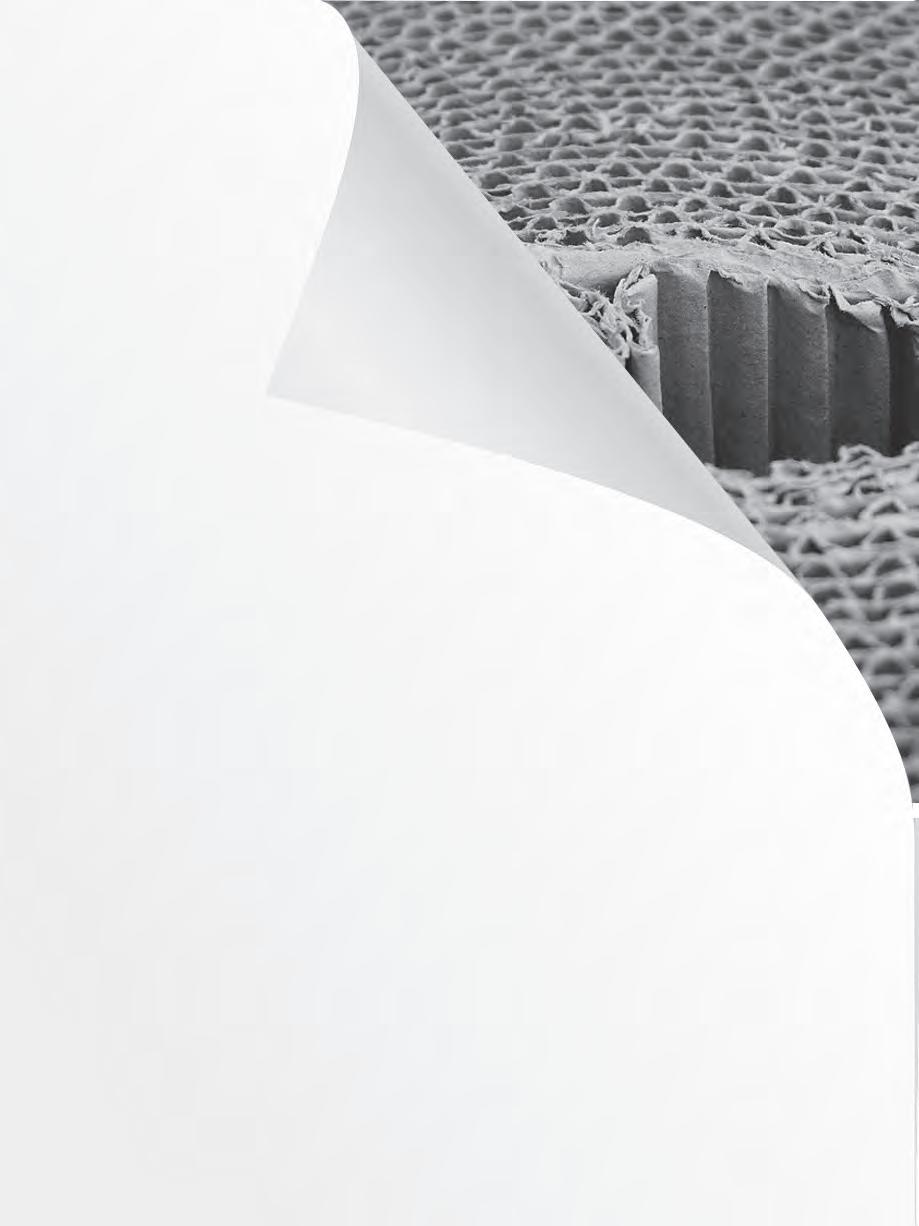
La classificazione relativa agli imballaggi cellulosici, ripresa da Imballaggio in Cifre, prevede la suddivisione in cinque categorie:
• fogli e contenitori in cartone ondulato (compreso espositori);
• astucci e scatole pieghevoli in cartoncino;
• sacchi in carta di grandi dimensioni;
• altri imballaggi cellulosici (fusti in cellulosa, tubi, carta da incarto, sacchetti piccoli e shopper, etichette, supporti in carta nel settore maglieria e abbigliamento, ecc.);
• contenitori rigidi accoppiati a prevalenza carta.
In base alle analisi congiunturali elaborate da Assografici, l’industria cartotecnica - all’interno della quale rientra il settore degli imballaggi di carta e cartone - nel 2022 chiude con un fatturato in crescita del 25,5%. Si tratta di un incremento elevato, vista la necessità di recuperare almeno in parte gli aumenti dei costi di produzione, derivati sia dai costi energetici sia da quelli delle materie prime. In calo del 3,1%, invece, l’andamento tendenziale relativo alla produzione dell’industria cartotecnica di trasformazione.
Il mercato degli imballaggi cellulosici in Italia
Il settore riesce a mantenere un certo equilibrio nella rappresentatività rispetto al totale dell’area packaging, analizzata sia in termini di peso (33%) sia di fatturato (24% circa). Dopo aver superato in modo eccellente un biennio difficile quale è stato il ‘20-‘21, nel 2022 il settore degli imballaggi cellulosici ha purtroppo registrato un trend produttivo negativo, chiudendo l’anno con un -3,3%: era dalle crisi del 2008/2009 e 2011/2012 che non venivano rilevati cali in questo ambito.
La produzione totale di imballaggi in carta e cartone nel 2022 arriva a superare di poco le 5.900 t/000. Il commercio estero risulta viaggiare in due direzioni diverse: in calo le esportazioni -3,3% che risultano in linea con la produzione, ma in sensibile aumento le importazioni che registrano un +19,1%. Da notare che la decisa crescita dell’import riguarda tutti i materiali di confezionamento e l’intero settore imballaggi, che nel 2022 arriva a oltre il 10%.
La maggior parte dei rapporti commerciali svilup-
www.italiaimballaggio.it [ FACTS & FIGURES ] 9/23 • 35
Barbara Iascone
2008 2009 2010 2011 2012 2013 2014 2015 2016 2017 2018 2019 2020 2021 2022 Δ 22/21 Fatturato MLN/euro 7.315 6.450 7.040 7.455 7.210 7.174 7.410 7.590 7.740 7.921 8.137 8.288 8.054 9.054 10.906 24,1% Turnover Produzione t/000 5.212 4.839 5.145 5.075 4.856 4.876 4.985 5.081 5.196 5.337 5.412 5.491 5.555 6.132 5.931 -3,3% Production Esportazione (t/000) 459 443 502 518 521 532 557 561 591 612 630 635 614 678 671 -2,3% Export Importazione (t/000) 115 100 110 114 124 112 130 130 148 155 157 227 147 168 206 19,1% Import Utilizzo apparente (t/000) 4.868 4.496 4.753 4.671 4.459 4.456 4.558 4.650 4.753 4.880 4.939 5.083 5.088 5.622 5.466 -2,8% Apparent use Fonte/source: elaborazioni Istituto Italiano Imballaggio
Tabella 1. Scheda monografica del settore imballaggi cellulosici (2008-2022). Table 1. Monographic sheet of the cellulosic packaging sector (2008-2022).
IL RICICLO DEGLI IMBALLAGGI CELLULOSICI. Ottimi i risultati 2022 della raccolta, secondo i dati di COMIECO (il consorzio che, in ambito CONAI, si occupa di garantire e promuovere appunto il riciclo di questa tipologia di imballaggi): sono state infatti oltre 3,6 milioni le tonnellate raccolte, con una crescita dello 0,6% rispetto al 2021. La media nazionale pro-capite risulta essere sopra i 61 kg, e il tasso di riciclo degli imballaggi cellulosici supera l’81%, confermando il superamento degli obiettivi UE al 2025 e il progressivo avvicinamento ai target fissati per il 2030.
pati dal nostro Paese rimangano in ambito europeo (un comun denominatore di tutte le tipologie di imballaggi): nel 2022 l’86,5% delle importazioni è pervenuto da paesi europei, l’89,6% delle esportazioni è invece rimasto in Europa. Tale suddivisione rimane sostanzialmente stabile da un anno all’altro.
All’interno di questa segmentazione, Germania e Francia restano i nostri più fedeli partner commerciali, ma va evidenziato come, nel 2022, le importazioni dalla Turchia siano aumentate del 149% rispetto all’anno precedente!
Il fatturato registra un incremento elevatissimo, chiudendo con un +25,5% che equivale a oltre 10 miliardi di euro, analogamente a quanto emerso a proposito dell’industria cartotecnica di trasformazione.
Per quanto riguarda il resto del mondo, in ambito importazioni extra UE è la Cina la protagonista assoluta con il 93%. Le esportazioni extra UE sono indirizzate per il 72% circa verso l’Africa.
Le tipologie di packaging in carta e cartone
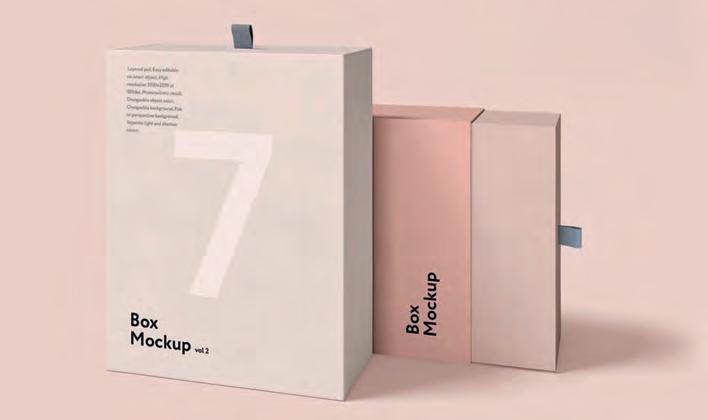

Cartone ondulato
Questo materiale viene utilizzato in prevalenza per la produzione di scatole destinate al trasporto e allo stoccaggio di merci o come imballaggio secondario per contenere prodotti a loro volta confezionati in imballaggi primari.
Gli imballaggi in cartone ondulato sono i più rappresentativi della categoria, con il 74% di share, ma nel 2022 hanno subìto una battuta d’arresto registrando
un calo pari al -4,4% arrivando a 4.284 t/000 prodotte. In base alle analisi dell’ufficio studi di Assografici, tale risultato va letto come moderatamente negativo, in quanto naturale conseguenza del deciso rimbalzo positivo registrato nel 2021, dove gli imballaggi in cartone ondulato crescevano del +12% dopo la crisi pandemica. Confrontando i risultati del 2022 con quelli del periodo pre-covid (2019), la produzione di imballaggi in carta e cartone risulta più alta del 9%. Le importazioni risultano abbastanza stabili, fermandosi al +0,8%; in calo invece le esportazioni, che chiudono il 2022 con un -5,9%, raggiungendo rispettivamente le 38.000 e le 333.000 tonnellate.
Astucci e scatole in cartoncino teso Gli imballaggi in cartoncino teso rappresentano il 15% del comparto imballaggi cellulosici. Possono essere composti al 100% di cartoncino oppure abbinati a film di PE o a film di alluminio. L’abbinamento del film plastico o del film di alluminio si rende in genere necessario per conferire all’astuccio un aspetto più accattivante, come accade per esempio per quelli impiegati nel settore cosmetico, o per particolari esigenze legate all’impiego.
Dopo il consistente trend positivo del 2021, nel 2022 anche gli
2017 è stato introdotto un nuovo metodo di rilevazione / In 2017 a new survey method was introduced
source: elaborazioni Istituto Italiano Imballaggio
www.italiaimballaggio.it [ FACTS & FIGURES ] 36 • 9/23
2008 2009 2010 2011 2012 2013 2014 2015 2016 2017 2018 2019 2020 2021 2022 Δ 22/21 Cartone ondulato 3.705 3.485 3.677 3.613 3.473 3.498 3.570 3.620 3.719 3.791 3.886 3.933 4.000 4.479 4.280 -4,4% Corrugated cardboard Cartoncino teso 759 688 745 747 707 700 731 764 769 783 790 821 819 876 868 -0,9% Flat cardboard Sacchi 201 185 198 198 182 191 195 189 187 195 197 203 200 218 221 1,4% Sacks Acc. Prev. CA 132 131 135 137 134 132 136 139 139 139 139 139 147 152 152 0,0% Paper laminated Altro (1) 415 350 390 380 360 355 353 369 382 401 400 395 389 407 406 -1,2% Other Totale 5.212 4.839 5.145 5.075 4.856 4.876 4.985 5.081 5.196 5.309 5.412 5.491 5.555 6.132 5.931 -3,3% Total 1) nel
Fonte/
Tabella 2. Evoluzione della produzione nel settore imballaggi cellulosici, suddivisi per tipologia (dati espressi in t/000). Table 2. Evolution of production in the cellulosic packaging sector, divided by type (data expressed in t/000).
astucci in cartoncino subiscono una battuta d’arresto: l’andamento tendenziale della produzione868.000 tonnellate - è al -1%.
Utilizzati in prevalenza come imballaggi secondari, gli astucci sono destinati per il per il 44,2% all’alimentare, per il 19,2% all’area bevande e per il 9,2% al cosmetico e farmaceutico. Il restante 27,3% è imputabile alla voce “altro non food” all’interno della quale rientrano per esempio i piccoli e grandi elet-
Paper and cardboard packaging
It remains one of the most representative sectors of the packaging industry, both in terms of tonnes produced and turnover: in 2022 cellulose packaging represented 33% of global packaging production, while in terms of turnover exceeded 23.5%, percentages remaining quite stable over time.
Cellulose packaging, as reported by Imballaggio in Cifre (Packaging in Figures), is subdivided into five categories:
• sheets and containers in corrugated cardboard (including displays);
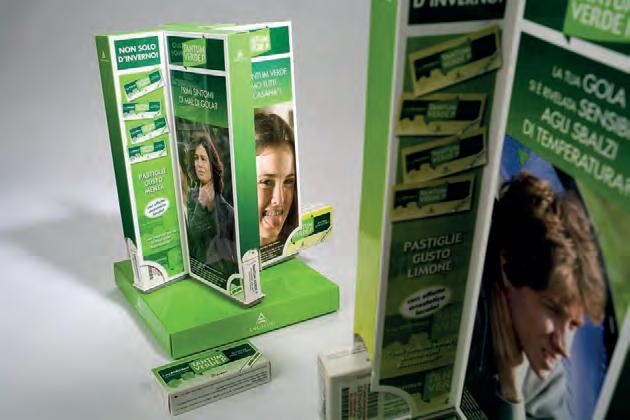
• foldable cardboard cartons and boxes;
• large-size paper bags;
• other cellulose packaging (cellulose drums, tubes,
wrapping paper, small bags and shopping bags, labels, paper supports in the knitwear and clothing sector, etc.);
• rigid mainly paper-based laminated containers.
Based on the economic analysis carried out by Assografici, the paper industry - of which the paper and cardboard packaging sector
trodomestici, pentole e utensili da cucina, prodotti per la detergenza domestica, prodotti accessori di arredo, ecc.
Sacchi di carta di grandi dimensioni
Questa tipologia di packaging viene utilizzata in prevalenza nel settore delle costruzioni dove, in base alle elaborazioni Gipsac (uno dei Gruppi di Specializzazione di Assografici) risulta essere l’unico a registrare un andamento tendenziale positivo, complice un aumento modesto dei mangimi e dei chimici-fertilizzanti. Nel 2022 la produzione arriva a 221 t/000, segnando un incremento dell’1,4%.
Altri settori imballaggi cellulosici
Questa voce comprende diverse tipologie di packaging come fusti di cellulosa e tubi per confezionare bottiglie, tubi cellulosici per carta a uso domestico, carta da incarto, carta pergamena e solfito da incarto, carta ondulata, sacchetti piccoli, shopper, incarti automatici, fogli di carta per supporto capi di abbigliamento, etichette, piattaforme ed espositori di cartone teso e cartoncino, ecc. Anche per queste tipologie, nel 2022, si registra un trend negativo della produzione al -1,2%, portando le tonnellate a circa 406.000.
Contenitori accoppiati rigidi a prevalenza carta
Nella presente analisi facciamo rientrare anche gli imballaggi accoppiati a prevalenza carta, sebbene in “Imballaggio in cifre” vengano analizzati in un capitolo a parte. Il settore mostra ormai da diversi anni una certa stabilità, fatta eccezione per l’anno 2020; ormai il comparto registra crescita zero, sia di fatturato che di produzione.
Barbara Iascone Istituto Italiano Imballaggio
forms a part - closed in 2022 with a turnover growth of 25.5%. It’s a high increase, with the need to recover at least in part the increases in production costs relating to both energy and raw materials. The trend relating to the paper converting industry, instead, shows a fall of 3.1%.
The cellulose packaging market in Italy

The sector manages to maintain a stable share of the total packaging area, analysed in terms of both weight (33%) and turnover (around 24%). After successfully getting
through the difficult two-year period of 2020-21, in 2022 the cellulose packaging sector unfortunately recorded a negative production trend, closing the year with -3.3%: such a fall in this sector had not been seen since the 2008/2009 and 2011/2012 crises.
The total production of paper and cardboard packaging in 2022 was a little over 5,900 t/000.
Foreign trade travels in two different directions: exports fell in line with production, but there was a significant increase in imports, which recorded +19.1%. It is worth noting that
www.italiaimballaggio.it [ FACTS & FIGURES ] 9/23 • 37
Barbara Iascone
THE RECYCLING OF CELLULOSE PACKAGING. Excellent sorted collection results in 2022 according to COMIECO data (the consortium which, in association with CONAI, deals with guaranteeing and promoting the recycling of this type of packaging): over 3.6 million tonnes were collected, in fact, with a growth of 0.6% compared to 2021. The pro-capita average is over 61 kg, and the recycling rate of cellulose packaging is more than 81%, confirming the exceeding of EU goals to 2025 and the gradual approaching of the targets fixed for 2030.
the growth in imports relates to all packaging materials and the entire packaging sector, which in 2022 arrived at over 10%. Most trade relations developed by our country remain in the European sphere (a common denominator of all packaging types): in 2022, 86.5% of imports came from European countries and 89.6% of exports remained in Europe. These figures remain substantially unchanged from year to year. Within this segmentation, German and France are still our most faithful commercial partners, but in 2022 it should be noted that imports from Turkey increased by 149% compared to the previous year! The turnover shows a very high increase, closing with a +25.5%, equivalent to 10 billion euros, similar to what occurred in the paper-converting industry. With regards to the rest of the world, China is the absolute leader for non-EU imports, with 93%. 72% of non-EU exports went to Africa.
Types of paper and cardboard packaging
Corrugated cardboard
This material is mainly used for the production of boxes for the transport and storage of goods or for secondary packaging to contain products already packed in primary packaging. Corrugated cardboard packaging is the most predominant of the category, with a share of 74%, but it contracted in 2022, recording a fall of -4.4% arriving at 4,284 t/000 produced.
On the basis of the analysis of the Assografici research office, this result should be seen as only moderately negative, as a natural consequence of the sharp rise recorded in 2021, in which corrugated cardboard packaging grew by +12% after the pandemic crisis. Comparing the 2022 results with those of the pre-covid period (2019), paper and cardboard packaging was 9% higher. Imports were quite stable, achieving +0.8%; exports, instead, closed 2022 with a -5.9%, arriving, respectively at 38,000 and 333,000 tonnes.
Rigid cardboard cartons and boxes
Rigid cardboard packaging accounts for 15% of the cellulose packaging sector. They can be 100% composed of cardboard or combined with PE or aluminium film.
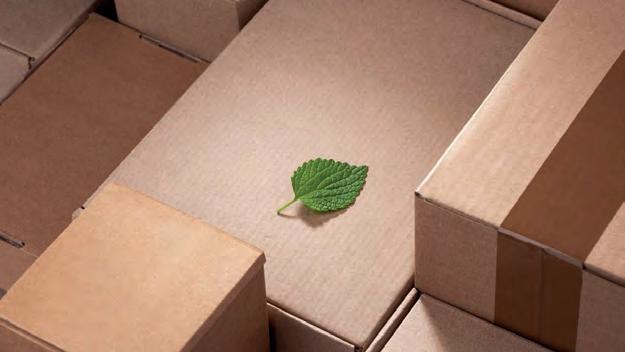
The combination of plastic and aluminium film is generally necessary for giving the carton a more attractive look, as occurs, for example for those used in the cosmetics sector, or for requirements linked to use. After the significant positive trend in 2021, in 2022 cardboard cartons also suffered a contraction: the production trend, standing at 868,000 tonnes, was -1%. Mainly used as secondary packaging, 44.2% of cartons are intended for foods, 19.2% for drinks and 9.2% for cosmetics and pharmaceuticals. The remaining 27.3% relates to the “other non-food” heading, inside of which there are, for example, small and large domestic appliances, cookware and kitchen utensils, home cleaning products, furnishing accessory products, etc.
Large paper bags
This type of packaging is mainly used in the construction sector in which, according to Gipsac’s figures (one of Assografici’s Specialisation Groups), is the only type of packaging to show a positive trend, thanks to a modest increase in animal foods and chemical fertilisers. In 2022, production arrived at 221 t/000, marking an increase of 1.4%.
Other cellulose packaging sectors
This heading includes several types of packaging such as cellulose drums and tubes for packaging bottles, cellulose tubes for household paper, wrapping paper, parchment paper and sulphite wrapping paper, corrugated paper, small bags, shopping bags, automatic wrapping, sheets of paper to support garments, labels, rigid and thick cardboard platforms and displays, etc.
Also for these types, in 2022 there was a negative production trend of -1.2%, taking the tonnes produced to around 406,000.
Rigid mainly paper-based laminated containers
Rigid mainly paper-based laminated packaging is also included in this analysis, although in “Packaging in Figures” it isare analysed in a separate section.
The sector has shown a certain stability for a number of years, with the exception of 2020; the sector today is recording zero growth, both in terms of turnover and production.
Barbara Iascone
[ FACTS & FIGURES ]
Istituto Italiano Imballaggio
www.italiaimballaggio.it 38 • 9/23
+23% il fatturato 2022 dell’industria italiana dell’automazione industriale
n Dopo la consistente flessione del 2020 (-10,3 % a valori correnti) e l’impetuoso +22,2% del 2021, nel 2022 si è assistito a una crescita del 23% rispetto al 2021 che, peraltro, aveva già riportato il mercato ai livelli preCovid, sfiorando quota 7 miliardi di euro. Il 2023 è iniziato in modo altrettanto soddisfacente, con il settore del software industriale che conferma la tendenza positiva con media superiore al 20% anno su anno. Tutto questo malgrado le problematiche dovute alle difficoltà di approvvigionamento, al rincaro delle commodity, alla mancanza di manodopera. Nell’analisi ANIE, tutti i segmenti hanno fatto registrare crescite superiori al 15%: molto bene sono andati motori brushless (+30%), azionamenti e networking Industriale (+26%), wireless factory (+21%) e PLC-I/O e HMI (+20%)
Anche nel 2022 gli OEM rimangono i leader in Italia nel consumo di automazione (60%
del totale -1%) davanti alla Distribuzione che ha perso 5 punti scendendo al 16%.
Per quanto riguarda i principali settori industriali, da segnalare che la meccanica rimane sempre il più importante consumatore di automazione (17%, era al 16% nel 2021), il packaging perde un punto ora è al 9% mentre l’alimentare è stabile al 9%; la logistica è sempre al 6%.
Tutti i settori industriali nel corso del 2022 hanno visto una crescita nel giro d’affari, con percentuali dal 12 a oltre il 40% unica eccezione i Mezzi di trasporto (+2,7% -0,1%), gli Alimentari, bevande e tabacco crescono del 17,7%. Il settore del Packaging segna nel 2022 +3,6% per un fatturato totale record di 8 miliardi e 537 milioni di euro. I dati completi sono disponibili ne “Osservatorio dell’industria Italiana dell’automazione 2023” su https://anieautomazione. anie.it/pubblicazioni/. (M. Cacciamani)
Carton Group rileva Europoligrafico
n Carton Group, azienda leader nel settore degli imballaggi controllata della società di private equity Waterland, ha acquisito il 100% della veronese Europoligrafico, specializzata in soluzioni di imballaggio innovative e di alta qualità con un fatturato di circa 60 milioni di euro e 210 dipendenti impegnati nei due siti produttivi italiani.
L’acquisizione, il cui closing è previsto per l’autunno 2023, è una tappa decisiva nel percorso di crescita di Carton Group, che mira a diventare leader europeo nella fornitura di servizi di imballaggio di qualità.
Di proprietà della società di private equity Waterland, che vanta un track record di oltre 1000 investimenti e 14 miliardi di euro di asset in gestione, Carton Group ha avviato una solida strategia di buy & build, costruendo un piano di crescita che guarda sia al mercato italiano che europeo con l’obiettivo di formare una rete multinazionale di specialisti dell’imballaggio consumer-oriented.
NUOVE PROSPETTIVE PER LA PROMOZIONE INTERNAZIONALE DEL COMPARTO COSMETICO - BolognaFiere
Cosmoprof, società organizzatrice delle manifestazioni b2b leader per il comparto cosmetico del network Cosmoprof in tutto il mondo, e SIMEST, la società del Gruppo Cassa Depositi e Prestiti che supporta l’internazionalizzazione delle imprese italiane, hanno firmato un protocollo d’intesa per sviluppare e incentivare nuove iniziative a sostegno dell’internazionalizzazione delle aziende espositrici di Cosmoprof.
Grazie alla collaborazione tra i due enti, gli espositori del network Cosmoprof potranno accedere ai servizi, alle professionalità e agli strumenti messi a disposizione e gestiti da SIMEST, finanza agevolata, supporto all’export e prestiti partecipativi. La società sarà presente con desk dedicati a
Cosmoprof Worldwide Bologna 2024, in programma dal 21 al 24 marzo prossimi, e a Cosmoprof Asia Hong Kong, dal 14 al 17 novembre 2023.
Con l’accordo, Cosmoprof e SIMEST rafforzano la collaborazione a supporto delle imprese della cosmetica per rispondere alle loro esigenze di crescita ed espansione all’estero, sostenendo con sempre maggiore forza il Made in Italy nel mondo.
NEW PROSPECTS FOR THE INTERNATIONAL PROMOTION OF THE COSMETICS SECTOR BolognaFiere
Cosmoprof, the leading organiser company of b2b events for the cosmetics sector of the Cosmoprof network throughout the world, and SIMEST, the company in the Cassa Depositi e Prestiti Group that supports the

+23% in 2022 turnover for the Italian industrial automation sector
After the significant downturn in 2020 (-10,3 % at current values) and the impressive +22.2% in 2021, in 2022 there was a growth of 23% compared to 2021 which, moreover, had already returned the market to pre-Covid levels, at very nearly 7 billion euros. 2023 began in a similarly satisfying way, with the industrial software sector confirming the positive trend with an average above 20% year-on-year. All this is despite the problems due to supply difficulties, the increase in the cost of commodities, and the shortage of labour. In ANIE’s analysis, all the segments have recorded growth greater than 15%: brushless motors (+30%), drivers and Industrial networking (+26%), wireless factory (+21%) and PLC-I/O and HMI (+20%) have all done very well.
Again in 2022, OEMs remain the top consumers of automation in Italy (60% of the total, down -1%) ahead of Distribution, which lost 5 percentage points, falling to 16%. With regards to the main industrial sectors, it’s worth pointing out that the mechanical sector remains the most important consumer of automation (17%, against 16% in 2021), packaging loses a percentage point and is now at 9%, while food is stable at 9%; logistics remains at 6%.
All industrial sectors in 2022 saw a growth in turnover, with percentages from 12 to over 40%, with the unique exception of means of transport (+2.7%, down 0.1%); Food, beverages and tobacco grew by 17.7%. The Packaging sector recorded +3.6% in 2022, for a total record turnover of 8 billion and 537 million euros. The complete data are available in “Osservatorio dell’industria Italiana dell’automazione 2023” at https://anieautomazione.anie.it/pubblicazioni/. (M.Cacciamani)
Carton Group acquires Europoligrafico
Carton Group, the leading company in the packaging sector controlled by the private equity company, Waterland, has acquired 100% of the Verona-based company, Europoligrafico, specialised in innovative and high-quality packaging solutions with a turnover of 60 million euros and 210 employees working in the two Italian production sites.
The acquisition, the closing of which is expected in autumn 2023, is a decisive step in the growth strategy of Carton Group, which aims to become a European leader in the supply of quality packaging services.
Owned by the private equity company, Waterland, which boasts a track record of over 1000 investments and 14 billion of managed assets, Carton Group has embarked on a solid buy&build strategy, drawing up a growth plan that looks at both the Italian and European market with the aim of forming a multinational network of consumeroriented packaging specialists.
internationalisation of Italian companies, have signed a memorandum of understanding to develop and incentivize new initiatives supporting the internationalisation of Cosmoprof’s exhibiting companies.
Thanks to the collaboration between the two bodies, Cosmoprof network exhibitors will be able to access the services, professionalism and tools made available and managed by SIMEST, including low-inter financing, support for exports and equity loans. The company will be present with dedicated desks at Cosmoprof Worldwide Bologna 2024, scheduled for next 21 to 24 March, and at Cosmoprof Asia Hong Kong, from 14 to 17 November 2023.
With this agreement, Cosmoprof and SIMEST are strengthening the collaboration
and support of cosmetics businesses in order to respond to the need for growth and expansion abroad, supporting Made in Italy in the world with increasing vigour.
9/23 • 39 www.italiaimballaggio.it NEWS [ FACTS & FIGURES ]
Una giornata istituzionale “Made of Paper”

Il 22 giugno, a Roma, si sono tenute le assemblee di Assocarta e Federazione Carta e Grafica: un’occasione per fare il punto sulla situazione di un comparto composito, che in Italia continua a esprimere numerosi primati pur nelle difficoltà dettate dalla contingenza.
Nel 2022 il fatturato della Federazione
Carta e Grafica ha superato i 31 miliardi di euro, in aumento del 24,4%, rispetto al valore già in crescita del 2021, anno in cui si sono toccati i 25,3 miliardi di euro, segnando un +15,5% rispetto al 2020, mentre il saldo della bilancia commerciale con l’estero si è confermato positivo per 4 miliardi di euro.
Una filiera quindi strategica per l’economia circolare del Paese e costituita dalle aziende associate ad Acimga (macchine per grafica e cartotecnica), Assocarta (carta e cartone) e Assografici (stampa, cartotecnica e trasformazione, imballaggio flessibile).
Dati e fatti in sintesi
Sono stati il neoeletto Presidente Michele Bianchi, il Past President Carlo Emanuele Bona e il Vice Presidente Daniele Barbui ad approfondire le dinamiche congiunturali espresse dai comparti che fanno capo alla Federazione Carta e Grafica. Consolidato il ruolo della Federazione
An institutional day “Made of Paper”
presso Confindustria e nei rapporti con le istituzioni, si conferma filiera chiave nella transizione energetica, ecologica e digitale; genera infatti l’1,6% del PIL italiano, impiegando oltre 162.000 addetti diretti in 16.369 imprese con un fatturato complessivo che, nel 2022, ha toccato i 31 miliardi di euro. E questo, nonostante la crescita del valore sconti gli effetti inflattivi dei forti aumenti dei prezzi dei prodotti cartari e di conseguenza dei prodotti grafici, dell’imballaggio e cartotecnici. I ritocchi si sono infatti rivelati necessari
per tentare di recuperare, almeno in parte, gli ingenti rincari del gas, dell’energia, delle materie prime fibrose e dei trasporti. Le difficoltà della congiuntura non intaccano però i primati. La produzione di carta igienica sanitaria italiana è la prima in Europa e la seconda nel mondo. L’industria italiana delle macchine per printing e converting è la terza a livello globale, mentre l’industria grafica italiana è seconda in Europa, dopo la Germania. Infine, l’industria cartotecnica trasformatrice è al secondo posto, a livello europeo
The General Annual Meetings of Assocarta and Federazione Carta e Grafica were held in Rome on 22 June 2023. It was an important occasion to evaluate the state of a composite sector that continues to achieve numerous milestones in Italy, despite the challenges posed by the economic situation.
In 2022, the Federazione Carta e Grafica (Paper and Graphics Federation) achieved a turnover of over € 31 billion, marking a 24.4% increase from the already thriving value of € 25.3 billion in 2021. This represents an increase of 15.5% compared to 2020, while the foreign trade balance remained positive at € 4 billion.

A supply chain that therefore plays a
crucial role in Italy’s circular economy, comprising member companies from Acimga (graphic and paper processing machinery), Assocarta (paper and cardboard) and Assografici (printing, paper processing and converting, flexible packaging).

Key facts and figures
The newly-elected President Michele Bianchi, Past President Carlo
Emanuele Bona and Vice President Daniele Barbui discussed the economic dynamics within the segments belonging to the Federazione Carta e Grafica. The Federation’s role in Confindustria and its relationships with institutions has been solidified, establishing itself as a key player in energy, ecological and digital transition. In fact, it accounts for 1.6% of Italy’s GDP, employing over 162,000 direct workers across 16,369 companies, with projected total sales of € 31 billion in 2022. This is despite the fact that the growth in value offsets the inflationary impacts of sharp price increases in paper products and consequently in graphic materials, packaging and paper stationery. The adjustments proved necessary to
partially recover from the significant price hikes in gas, energy, fibrous raw materials and transportation. Nevertheless, the economic difficulties did not affect the records. Italy leads in toilet paper production in Europe and ranks second globally. Italy’s paper printing and converting machinery industry is ranked third globally, while its graphics industry holds the second position in Europe, after Germany. Finally, Italy’s paper converting industry is the secondlargest in Europe in terms of turnover, with Germany leading the pack.
Nevertheless, Michele Boni warns: «The first months of 2023 saw a worsening scenario. The concerns of companies in the supply chain are growing due to a macroeconomic
www.italiaimballaggio.it [ FACTS & FIGURES ] NEWS 40 • 9/23
Image by Alexander Stein from Pixabay
per fatturato, dopo la Germania. Tuttavia, ammonisce Michele Boni: «I primi mesi 2023 vedono uno scenario in peggioramento: emergono le preoccupazioni delle imprese della filiera per il rallentamento macroeconomico, che sta incidendo negativamente sulla domanda dei prodotti della filiera e, quindi, sull’attività produttiva».
Il tema energia, centrale per Assocarta l’Assemblea Pubblica di Assocarta ha aperto uno spaccato su un settore energy intensive come quello dei produttori di carta, cartoni e paste per carta, per il quale il 2022 è stato un anno complesso, dove il caro energia ha condizionato fortemente l’attività produttiva. I volumi, che nel primo semestre segnavano +1,4%, da luglio 2022 hanno visto un’inversione di tendenza, perdendo il 19,7% nel secondo semestre (dati 2022/2021). I risultati del 2022 sono stati generati dalla tempo-
ranea fermata di alcuni impianti a causa dei forti rincari di gas, il cui costo incide sul fatturato per oltre il 30% rispetto al 4,2% del 2020, energia elettrica e materie prime fibrose, ma anche dal progressivo rallentamento dell’economia e dalla perdita di competitività, nei confronti di Paesi con costi energetici più bassi come Germania e Francia, oltre quelli extra UE che hanno avvantaggiato l’import in aumento del 15,5% nel 2022/2021. Da non dimenticare infatti che il gas europeo costa sei volte quello USA.
I primi tre mesi del 2023, rispetto al prepandemia del 2019, confermano un calo della domanda di carta dell’11,6% e della produzione del 15,4% con carte per imballaggio (rispettivamente +0,1%, -1.1%) e per uso igienico sanitario (rispettivamente +0,3%, 0,1%) più o meno in tenuta, e un forte calo delle carte per usi grafici (rispettivamente -42,7% -53,7%). Come ha avuto modo di sottolineare il
Presidente di Assocarta, Lorenzo Poli: «La sfida è recuperare la quota di produzione di carta e cartone erosa da perdita di competitività per caro energia, destoccaggio e inflazione, coda lunga della pandemia».
Investire in sostenibilità e riciclo. L’Italia, con il 10,3% dei volumi europei è seconda solo alla Germania. Le cartiere nazionali hanno fortemente investito su sostenibilità, riciclo e raccolta della carta, grazie anche alla presenza di consorzi specializzati come Comieco. Su 11 milioni di tonnellate di imballaggi riciclati ogni anno, circa 4,5 milioni sono fatti di carta, senza dimenticare l’utilizzo di fibre vergini certificate (PEFC, FSC). Il settore, in sintesi, si conferma al secondo posto in Europa come riciclatore, dopo la Germania, laddove nell’imballaggio il riciclo supera l’80%, superando quindi l’obiettivo del 75% entro 2025 previsto dalla normativa comunitaria.
slowdown, which is negatively affecting demand and production in the supply chain.»
Energy, a crucial theme for Assocarta
The Public General Meeting of Assocarta opened a side discussion on the energy-intensive sector, encompassing paper, cardboard and pulp manufacturers. 2022 proved to be a very difficult year, characterised by soaring energy costs that had a profound impact on production activities. In the first half of the year, volumes increased by 1.4%, however, this trend reversed dramatically in the second half of the year (2022/2012 data), resulting in a decline of 19.7%. The 2022 results were the consequence
of several factors. One major contributor was the temporary shutdown of some manufacturing plants due to substantial increases in gas prices, resulting in a more than 30% decrease in turnover, compared to 4.2% in 2020. The escalating costs of electricity and fibrous raw materials also played a role, as did the progressive economic slowdown. Another significant factor was the loss of competitiveness against countries with lower energy costs such as Germany and France, as well as countries outside the EU which benefitted from a 15.5% increase in imports in 2022/2021. It is important to note that European gas prices were approximately six times higher than those in the
United States.
Compared to the pre-pandemic year of 2019, the first three months of 2023 demonstrate an 11.6% decline in paper demand and a corresponding 15.4% decrease in production, with packaging paper (respectively +0.1% and -1.1%) and toilet paper (respectively +0.3% and 0.1%) more or less holding up, and graphic paper (respectively -42.7% and -53.7%) dropping sharply.
According to Lorenzo Poli, President of Assocarta, «the challenge lies in regaining the market share of paper and cardboard production that has been eroded due to loss of competitiveness caused by high energy costs, destocking, inflation, and the prolonged impacts of the pandemic.»

Investing in sustainability and recycling
With a share of 10.3% of European volumes, Italy stands as the second-largest recycler in Europe, trailing only behind Germany. National paper mills have invested heavily in sustainability, recycling and paper collection thanks also to the presence of specialised consortia such as Comieco. Approximately 4.5 million tonnes of paper is recycled out of the 11 million tonnes of packaging recycled annually, not forgetting the use of certified virgin fibres (PEFC, FSC). In short, the sector confirms its place as the second largest recycler in Europe, after Germany, where packaging recycling reaches 80%, thus surpassing the EU-mandated goal of 75% by 2025.

9/23 • 41 www.italiaimballaggio.it
NEWS [ FACTS & FIGURES ]
Image by isaac Hartman from Pixabay
n Con 473 voti a favore, 110 contrari e 69 astensioni, mercoledì 12 luglio l’assemblea plenaria del Parlamento europeo ha adottato una risoluzione legislativa preparata dalla commissione per l’ambiente, la sanità pubblica e la sicurezza alimentare (ENVI) sulla revisione del quadro di progettazione ecocompatibile dell’UE per i prodotti sostenibili, rafforzando le misure proposte dalla Commissione per garantire una maggiore durata di vita dei prodotti e consumatori più informati.
Italian Machine Vision Forum, edizione n.2
Il 30 marzo 2022 la Commissione aveva presentato una proposta di regolamento per istituire un quadro generale per la definizione di specifiche per la progettazione ecocompatibile dei prodotti sostenibili e per abrogare le norme attuali che si concentrano solo sui prodotti connessi all’energia.
Le norme riviste si applicherebbero a quasi tutti i prodotti del mercato interno (ad eccezione di alimenti, mangimi, medicinali e organismi viventi). La proposta fa parte di un pacchetto di proposte sull’economia circolare, che comprende anche una strategia dell’UE per i prodotti tessili sostenibili e una proposta sulla responsabilizzazione dei consumatori per la transizione verde.
Aggiornamenti di software, materiali di consumo (ad esempio cartucce d’inchio-
stro, lampadine, capsule di caffè), pezzi di ricambio e accessori secondo il Parlamento Europeo devono essere disponibili per un periodo adeguato. Nel testo, si propone l’introduzione di un nuovo “passaporto del prodotto” contenente informazioni accurate e aggiornate per aumentare la trasparenza e consentire ai consumatori di fare scelte di acquisto consapevoli, chiedendo alla Commissione di dare priorità alla definizione dei requisiti di sostenibilità per una serie di gruppi di prodotti nelle prossime misure di progettazione ecocompatibile, quali ferro, acciaio, alluminio, tessili, mobili, pneumatici, detergenti, vernici, lubrificanti e prodotti chimici. A questo si aggiunge la richiesta di divieto specifico per evitare la distruzione di prodotti tessili invenduti e apparecchiature elettriche ed elettroniche.
Si terrà il 3 ottobre al Palacongressi di Rimini la mostra convegno itinerante Italian Machine Vision Forum, promossa da ANIE Automazione e organizzata da Messe Frankfurt Italia.
n Visione artificiale, competitività e sostenibilità saranno i temi al centro dell’evento, che offrirà una panoramica fedele ed esaustiva di un settore con ampio potenziale di sviluppo nell’ambito dell’industria green e digitale.
Il format dell’evento. Il forum sarà un’occasione di confronto sulle opportunità dei sistemi di visione: oggettività dei controlli qualitativi, aumento dell’efficienza in produzione, costante tracciamento dei processi tra i benefici più apprezzati. La sessione plenaria aprirà i lavori con il coinvolgimento di alcune figure di spicco del mondo industriale. Durante le sessio-
EU Ecodesign: more environmentallyfriendly and energy-efficient products
On Wednesday 12 July, with 473 votes in favour, 110 against and 69 abstentions, MEPs in plenary session adopted a legislative resolution prepared by the Committee on the Environment, Public Health and Food Safety (ENVI) revising the EU’s ecodesign framework for sustainable products, strengthening the measures proposed by the Commission to ensure longer product lifespans and better-informed consumers.
On 30 March 2022, the Commission had put forward a regulation proposal to set up a general framework for defining ecodesign requirements for sustainable products and to repeal current rules which focus on energy-related products only.
The revised rules would apply to almost all products in the internal
market (with the exception of food, animal feed, medicinal products and living organisms). The proposal is part of a circular economy package, which also includes a EU strategy for sustainable textiles and a proposal on empowering consumers for the green transition.
According to the European Parliament, software updates, consumables (e.g., ink cartridges, light bulbs, coffee capsules), spare parts and accessories should be available for an appropriate period.
The text proposes the introduction of a new “product passport” containing accurate and up-to-date information to increase transparency and enable consumers to make informed purchasing choices, inviting the Commission to prioritise the definition of sustainability requirements for a number of product groups in the upcoming ecodesign measures, such as iron, steel, aluminium, textiles, furniture,
ni parallele “Tecnologie” e “Applicazioni” si alterneranno gli interventi di produttori, integratori e distributori di tecnologie per la visione artificiale. Nell’area espositiva sarà infine possibile approfondire con i professionisti del settore gli aspetti tecnologici e applicativi trattati nelle conferenze.
Per saperne di più: machinevisionforum.it
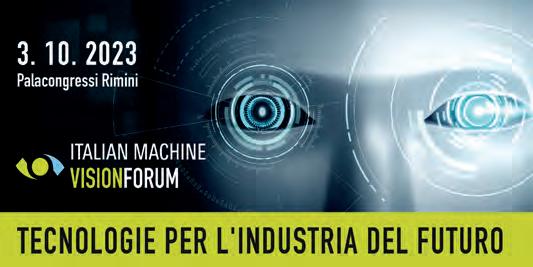
tyres, detergents, paints, lubricants and chemicals. A specific ban is also requested on the destruction of unsold textiles and electrical and electronic equipment. More info: www.europarl.europa.eu
Italian Machine Vision Forum, II edition
The Italian Machine Vision Forum, the travelling conference exhibition, promoted by ANIE Automazione and organized by Messe Frankfurt Italia, will be held on 3 October at the Rimini Conference Centre.
Artificial vision, competitiveness and sustainability will be the central themes of the event which offers a faithful and exhaustive overview of a sector with great potential for development in the sphere of the green and digital industry.
Format of the event. The forum will be an opportunity for discussion on vision system opportunities: objectivity of qualitative controls, increase in production efficiency and constant tracking of processes are among the most appreciated benefits.
The plenary session will open proceedings with the involvement of a number of prominent figures in the industrial world. During the parallel “Technologies” and “Applications” sessions, there will be a sequence of talks by manufacturers, integrators and distributors of artificial vision technologies. In the exhibition area, finally, it will be possible to look deeper into the technological and application aspects of the conferences with sector professionals.
To find out more: machinevisionforum.it
42 • 9/23 www.italiaimballaggio.it [ FACTS & FIGURES ] NEWS
Ecodesign dall’UE: prodotti più ecologici ed efficienti dal punto di vista energetico
Dalla Direttiva Macchine al Regolamento Macchine
La risposta dell’UE all’evoluzione tecnologica. TÜV Italia fa il punto sulle novità normative contenute nel regolamento che aggiorna una Direttiva applicata ormai da 15 anni.
n I profondi cambiamenti nel mondo della progettazione e produzione di macchine e macchinari, sempre più integrati a sistemi digitalizzati, elementi di robotica, intelligenza artificiale, automazione, hanno reso necessario un aggiornamento della Direttiva Macchine, a partire dal nome, divenuto ora Regolamento, il cui obiettivo è migliorare ulteriormente la sicurezza delle macchine all’interno dell’Unione Europea. Nasce da questa esigenza la modifica della Direttiva Macchine (CE) 2006/42, rispondendo alla necessità di tenere il passo con i rapidi sviluppi tecnologici e affrontare i rischi emergenti nel settore, quali l’integrazione dell’intelligenza artificiale e della robotica. Temi che sono alla base del cambiamento e della promulgazione del nuovo Regolamento Macchine (UE) 2023/1230 che garantisce alle macchine commercializzate nell’UE siano conformi a requisiti di sicurezza più rigorosi, fornendo una maggiore protezione per gli utenti e l’ambiente.
Il primo, e più evidente cambiamento, riguarda la nomenclatura: Regolamento anziché Direttiva. Questo garantisce un approccio più armonizzato e standardizzato in tutta l’UE. Infatti, a differenza delle direttive, che hanno bisogno anche di un decreto di recepimento nazionale, i regolamenti entrano in vigore subito alla data
From the Machinery Directive to the Machinery Regulation
The EU’s response to technological evolution. TÜV Italia takes a look at the new regulations contained in the regulation that updates a Directive that has been in force for the past 15 years.
The profound changes in the world of design and production of machines and machinery, which are increasingly integrated with digitalised systems, elements of robotics, artificial intelligence and automation, have called for an update of the Machinery Directive, starting from its name, which has now become a Regulation, and is aimed at further improving the safety of machines within the European Union. This prompted the amendment of the Machinery Directive (EC) 2006/42, responding to the need to keep pace with rapid technological developments and address emerging risks in the
stabilita dal regolamento stesso e si applicano automaticamente e uniformemente in tutta l’Unione Europea. Una seconda e importante modifica riguarda il coinvolgimento degli enti terzi, la cui valutazione diventa obbligatoria per diverse tipologie di macchine.
Il nuovo Regolamento Macchine (UE) 2023/1230 pubblicato il 29/06/2023 entrerà in vigore ufficialmente in UE il prossimo 19/07/2023 e sarà applicabile a partire dal 14/01/2027, data, quest’ultima, che segna dunque l’abrogazione definitiva della Direttiva Macchine (CE) 2006/42.
Gli altri cambiamenti chiave previsti dal nuovo Regolamento sono:
- Integrazione delle disposizioni sull’intelligenza artificiale: il Regolamento si applica ai sistemi che utilizzano tecnologie di intelligenza artificiale per gli aspetti che riguardano le possibili influenze sulla sicurezza della macchina;
- Misure di sicurezza informatica rafforzate: il nuovo Regolamento macchine chiede che i circuiti di comando, che svolgono funzioni di sicurezza, siano progettati in modo da evitare che attacchi malevoli possano causare comportamenti pericolosi delle macchine (cyber security);
- Macchine automatizzate e telecomanda-
sector, such as the integration of artificial intelligence and robotics. These issues are behind the change and the promulgation of the new Machinery Regulation (EU) 2023/1230, which ensures that machinery marketed in the EU complies with more stringent safety requirements, providing greater protection for users and the environment.
The first and most obvious change is in the nomenclature: regulation instead of directive. This ensures a more harmonised and standardised approach across the EU. In fact, unlike directives, which also need a national transposition decree, regulations come into force immediately on the date set by the regulation itself and apply automatically and uniformly throughout the EU. A second important change regards the involvement of thirdparty organisations, the assessment of which becomes mandatory for
te: il Regolamento definisce le linee guida per garantire l’uso e il funzionamento sicuri delle macchine automatizzate e telecomandate;
- Istruzioni e dichiarazioni digitalizzate: le istruzioni per l’uso, in caso di macchine, e le istruzioni per l’assemblaggio, in caso di quasi-macchine ed in maniera analoga le dichiarazioni di conformità / incorporazione possono essere fornite dal fabbricante in formato digitale.
- Valutazione obbligatoria da parte di un organismo notificato: sei categorie di prodotti richiedono la valutazione obbligatoria della conformità da parte di organismi terzi. Tra questi anche le macchine ed i componenti di sicurezza con comportamenti basati sul machine learning;
- Specifiche comuni: quando non sono disponibili norme armonizzate adeguate, le specifiche comuni forniscono un’opzione di ripiego, garantendo chiarezza e coerenza;
- Procedure di salvaguardia semplificate: le procedure di salvaguardia sono state semplificate e allineate con altre normative pertinenti per facilitare misure di sicurezza efficienti ed efficaci.
various types of machinery. The new Machinery Regulation (EU) 2023/1230 published on 29/06/2023 will officially enter into force in the EU on 19/07/2023 and will be applicable from 14/01/2027, the latter date marking the definitive repeal of the Machinery Directive (EC) 2006/42. The other key changes under the new Regulation are:
- Integration of the provisions on artificial intelligence: the Regulation applies to systems using AI technologies for aspects concerning possible influences on machine safety;
- Enhanced cyber security measures: the new Machinery Regulation requires control circuits, which perform safety functions, to be designed to prevent malicious attacks that might cause dangerous machine behaviour (cyber security);
- Automated and remote-controlled machines: the Regulation defines guidelines to ensure the safe use and operation of automated and remote-

controlled machines;
- Digitised instructions and declarations: the instructions for use, in the case of machinery, and the assembly instructions, in the case of quasi machines. Similarly, declarations of conformity/incorporation can be provided by the manufacturer in digital format.
- Mandatory assessment by a notified body: Six product categories require mandatory conformity assessment by third-party bodies. These include machines and safety components with machine learning behaviour;
- Common specifications: when suitable harmonised standards are not available, common specifications provide a fallback option, ensuring clarity and consistency;
- Simplified safeguard procedures: safeguard procedures have been simplified and aligned with other relevant legislation to enable efficient and effective safety measures.
9/23 • 43 www.italiaimballaggio.it
NEWS [ FACTS & FIGURES ]
Nuove sfide in America Latina
Perfezionata l’acquisizione della società brasiliana Mega Embalagens da parte di Goglio, che attiva così nuove sinergie per il mercato del caffè e del pet food.
n Attraverso la sua società controllata brasiliana, Goglio SpA ha finalizzato l’acquisizione della quota di maggioranza, pari al 51% di Mega Embalagens, azienda attiva in patria e all’estero nella fornitura di imballaggi flessibili destinati a diversi campi di applicazione, tra cui l’alimentare, l’igiene e il pet food.
Fondata nel 1993, Mega Embalagens ha sede a Salvador do Sul (Brasile), impiega circa 400 dipendenti e commercializza i propri prodotti in oltre 15 Paesi. La società, che registra un fatturato di circa 50 milioni di euro, è riconosciuta per la qualità del packaging offerto ai propri clienti e per l’approccio imprenditoriale orientato al costante miglioramento tecnologico. Ne è esempio il moderno impianto produttivo, pronto a ricevere nuovi investimenti e a migliorare la quota di mercato di Mega Embalagens e Goglio in Sud America. Un’operazione da cui si attendono importanti sinergie per entrambe le aziende, grazie all’integrazione delle rispettive competenze. Da una parte la leadership di Goglio nel settore del caffè, che si consolida così ulteriormente grazie all’ingresso in un mercato fondamentale come quello brasiliano, secondo al mondo per consumi di caffè con oltre 200 milioni di clienti e primo per la produzione di caffè verde.
Dall’altra, Mega Embalagens, tra i leader nel settore pet food, che beneficia dell’ingresso in una realtà consolidata a livello mondiale come quella di Goglio, già presente con impianti produttivi in Cina, Olanda e Stati Uniti e con società commerciali in Nord Europa, Giappone e India.
Strumenti per leggere il presente e prepararsi al futuro
Sostenibilità, digitalizzazione, tracciabilità e logistica collaborativa sono i quattro pilastri alla base del piano strategico di GS1 Italy, raccontato nell’Annual report 2022 di recente pubblicazione e di cui proponiamo una sintesi.
n L’Annual report 2022 di GS1 Italy tratteggia un anno fatto di nuove sfide e in continua trasformazione, dunque molto significativo per l’associazione che nel nostro Paese rappresenta GS1, l’organizzazione non profit che sviluppa gli standard più utilizzati al mondo per la comunicazione tra imprese.
Un anno in cui niente è stato come prima
In uno scenario globale caratterizzato da grandi cambiamenti, misure di adattamento e nuove sfide, GS1 Italy ha continuato a occuparsi non solo del presente ma anche del futuro del largo consumo in Italia. Tra le proposte spicca il “Nuovo Codice Consumi”, una ricerca che inaugura l’innovativo sistema di classificazione degli italiani e dell’Italia dei consumi, basato sul concetto di “comunità di sentire”, con cui sono state create nuove categorie per descrivere i consumatori in base a esigenze, affinità, attitudini e passioni prevalenti.
Un lavoro che cambia l’angolazione con cui approcciare gli italiani e che GS1 Italy mette a disposizione di tutti.
Classificazione internazionale e sostenibilità
L’Annual report riepiloga anche i risultati ottenuti dalle soluzioni e dai servizi che GS1 Italy ha messo a disposizione della business community. Tra questi spiccano alcuni tool legati a sostenibilità e digitalizzazione, tra i temi del momento e su cui puntiamo l’attenzione. “Immagino”, ad esempio, è un servizio che permette di creare i gemelli digitali dei prodotti; adottato da 6.211 utenti (+9,9% rispetto al 2021), ha superato i 134 mila prodotti digitalizzati (+3,4%).
“Codifico”, invece, consente alle aziende di creare e gestire i
New challenges in Latin America
Goglio has finalised its acquisition of the Brazilian company Mega Embalagens, thus creating new synergies for the coffee and pet food markets.
Through its Brazilian subsidiary, Goglio SpA has completed the acquisition of a 51% majority stake in Mega Embalagens, a company with a strong domestic and international presence in the supply of flexible packaging for various sectors, including food, hygiene, and pet food. Founded in 1993 and based in Salvador do Sul (Brazil), Mega Embalagens employs around 400 people and sells its products in more than 15 countries. The company boasts a turnover of around 50 million euros and is renowned for delivering high-quality packaging solutions while adopting an entrepreneurial mindset focused on continuous technological innovation. One example is their


modern production plant, which is poised to receive further investments, thereby bolstering Mega Embalagens and Goglio’s market presence in South America. This strategic move is expected to generate significant synergies for both companies, as they combine their respective areas of expertise. On the one hand, this acquisition solidifies Goglio’s dominant position in the coffee industry thanks to its entry into a key market like Brazil, which ranks second globally in coffee consumption with over 200 million customers, and first in green coffee production. On the other hand, Mega Embalagens, a leader in the pet food industry stands to benefit from becoming a part of the globally established Goglio company, which already has production plants in China, Holland and the United States, along with commercial branches in Northern Europe, Japan and India.
Tools for reading the present and planning for the future
GS1 Italy’s strategic plan is built on four pillars: sustainability, digitalisation, traceability, and collaborative logistics, as detailed in the recently released 2022 Annual Report, summarised below.
Nota. The GS1 Italy 2022 Annual Report is available on the website https://gs1it.org.
GS1 Italy’s 2022 Annual Report outlines a year marked by new challenges and continuous transformation, therefore highly significant for the association that represents GS1 in Italy, the non-profit organisation that develops the world’s most extensively adopted standards for business-to-business communication.
A year unlike any other Amidst significant global changes, adaptation measures and new challenges, GS1 Italy has continued to
address not only the present but also the future of mass consumption in Italy. One notable proposal is the “New Consumer Code”, a research project that introduces an innovative classification system for Italians and their consumption patterns. The system is based on the concept of a “community of sentiment”, creating new categories that describe consumers according to needs, affinities, attitudes and prevailing passions.
This work changes the way we look at Italians, and GS1 Italy has made it available to everyone.
International Classification and Sustainability
The Annual Report also summarises the outcomes achieved through the solutions and services offered by GS1 Italy to the business community. These include various tools related to sustainability and digitalisation, which are two areas of our current focus.
44 • 9/23 www.italiaimballaggio.it [ INDUSTRY & MANAGEMENT ] NEWS
barcode GS1 per i loro prodotti; ha superato i 443 mila barcode (+53,3%) generati da 5.607 imprese (+13,0%).


“GS1 Registry Platform”, inoltre, con 510 mila prodotti inseriti nel registro mondiale, mira a condividere le sette informazioni fondamentali che li riguardano (il GTIN, la marca, una descrizione del prodotto, l’URL dell’immagine di prodotto, la classificazione standard Global Product Classification, il contenuto netto e l’unità di misura, il paese di commercializzazione).
Guardando poi al green, ecco “Ecologistico2”, il tool creato per misurare le emissioni e agire per un minore impatto ambientale, adottando scelte consapevoli e vantaggiose. Uno strumento già adottato da 15 aziende, tra produttori (Barilla, Bauli, Campari, Carlsberg, Eridania, Fater, Ferrero, Lavazza, L’Oréal Italia, Mondelez Italia, Nestlé Waters, Procter & Gamble, Unilever) e distributori (Conad, Coop Italia).
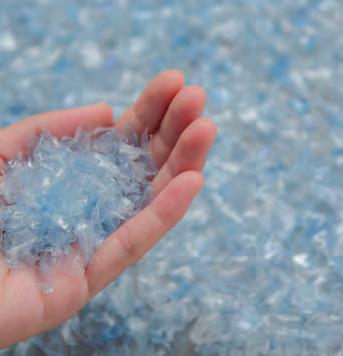

E sempre di sostenibilità si occupa “Circol-UP”, lo strumento pensato per permettere alle aziende di misurare la loro performance di circolarità in modo da migliorare i processi, diminuire gli sprechi, immaginare nuovi modelli di business e sistemi collaborativi che ha coinvolto 23 aziende, tra produttori (Artsana, Auricchio, Barilla, Bauli, Esselunga, Fater, Ferrero, Marchese Antinori, Mondelēz Italia, Nestlé Italiana, Panzeri Diffusion, Parmalat, Prealpi, Procter & Gamble, Sutter) e distributori (Bennet, Conad, Decathlon, Despar Italia, D.itDistribuzione Italiana, Esselunga, Metro, Realco).
For example, “Immagino” is a service that streamlines the process of creating digital twins of products. It has been adopted by 6,211 users (a 9.9% increase compared to 2021), resulting in over 134,000 products being digitised (+3.4%). On the other hand, “Codifico” enables businesses to generate and manage GS1 barcodes for their products. Over the year, more than 443,000 barcodes (+53.3%) have been generated by 5,607 businesses (+13.0%). Then there is the “GS1 Registry Platform” which has 510,000 products registered in the global registry. It aims to disseminate seven critical pieces of information about each product, including the GTIN, brand, description, URL of the product image, standard Global Product Classification, net content, unit of measurement, and marketing country.

In terms of sustainability, there is “Ecologistico2”, a tool designed to measure emissions and guide businesses in making conscious and
beneficial choices that help reduce their environmental impact.



This tool has already been adopted by 15 companies, including manufacturers (Barilla, Bauli, Campari, Carlsberg, Eridania, Fater, Ferrero, Lavazza, L’Oréal Italia, Mondelez Italia, Nestlé Waters, Procter & Gamble, Unilever) and distributors (Conad, Coop Italia).
Sustainability is also the focus of the “Circol-UP” tool, which enables companies to measure their circularity performance in order to improve processes, reduce waste, and develop innovative business models and collaborative systems. This tool involves 23 companies, including manufacturers (Artsana, Auricchio, Barilla, Bauli, Esselunga, Fater, Ferrero, Marchese Antinori, Mondelēz Italia, Nestlé Italiana, Panzeri Diffusion, Parmalat, Prealpi, Procter & Gamble, Sutter) and distributors (Bennet, Conad, Decathlon, Despar Italia, D.itDistribuzione Italiana, Esselunga, Metro, Realco).
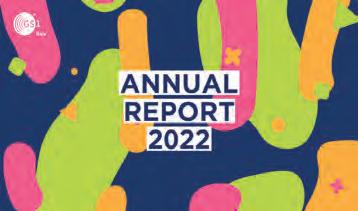
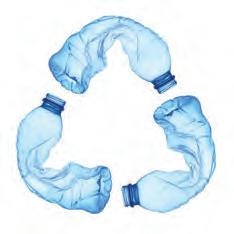
9/23 • 45
www.italiaimballaggio.it NEWS [ INDUSTRY & MANAGEMENT ]
Nota. L’Annual report 2022 di GS1 Italy è consultabile sul sito https://gs1it.org.
VIENE DALLA NATURA, TORNA ALLA NATURA
PaperFoam® è un’innovativa soluzione di imballaggio stampata a iniezione, 100% riciclabile e compostabile, che permette di ridurre al minimo l’impatto ambientale.
Ècompletamente privo di plastica e prodotto con materie prime naturali: amido di patate industriali (70%), fibre di cellulosa (12%), acqua (18%) e un additivo speciale, sempre biobased, utilizzato come legante. PaperFoam® è un esempio di packaging green a basse emissioni di carbonio, con eccezionali caratteristiche di adattabilità e stabilità e, grazie alla scelta illimi tata di colori, si presta a essere personalizzato nella stampa e nella grafica.
non a uso alimentare), una materia prima rinnovabile fondamentale per PaperFoam®, sia per le sue qualità fisiche sia per la complessiva riduzione dei consumi. Le fibre vergini lunghe e corte provengono invece da foreste certificate FSC ® , e garantiscono la massima efficienza ecologica di tutta la catena di produzione, dalla coltivazione al prodotto finale.
particolarità di questo processo è che permette di ottenere una superficie molto ben definita e, allo stesso tempo, una resistenza ottimale.
Ecofoam sarà a Luxe Pack con Dimontonate Floccati SpA, agente esclusivo per l’Italia (stand RF08)
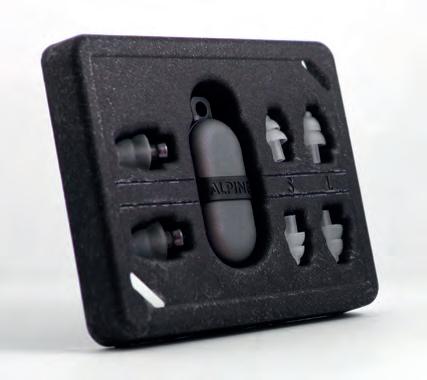

Ecofoam will be at Luxe Pack with Dimontonate Floccati SpA, exclusive agent for Italy (booth RF08)
A commercializzarlo in esclusiva per Spagna, Italia e Portogallo è Ecofoam Nature, azienda spagnola con una vasta esperien za nel settore, che da anni collabora con i marchi leader del packaging sosteni bile.
L’amido utilizzato è un amido con venzionale a uso industria le (ottenuto da patate
Coming from nature, returning to nature
PaperFoam® is an innovative 100% recyclable and compostable injection moulded packaging solution that makes it possible to reduce environmental impact to a minimum.
It’s completely plastic free and produced with natural raw materials: industrial potato starch (70%), cellulose fibre (12%), water (18%) and a special additive, always biobased, used as a binder. PaperFoam® is an example of low carbon-emission green packaging, with exceptional adaptability and stability characteristics and, thanks to the infinite choice of colours, lends itself to being personalized in the printing
and graphics.
Il processo di produzione. Per mezzo di uno speciale processo a iniezione, la polpa di carta prodotta viene iniettata in appositi stampi di alluminio, successivamente convogliati in un forno e cotti a una temperatura di oltre 200 °C per ottenere il pezzo finale. L’uso di stampi a iniezione garantisce che i contorni dell’imballaggio siano perfettamente definiti, oltre a un’elevata stabilità di forma. La
Per info: www.ecofoamnature.com
reduction in consumption. Long and short virgin fibres coming from FSC® certified forests guarantee maximum ecological efficiency along the entire production chain, from cultivation to the final product.
Sostenibilità e circolarità dalla produzione al fine vita del prodotto. L’impronta ecologica degli imballaggi PaperFoam® è dell’85% inferiore rispetto a quella degli imballaggi in plastica o in polpa di cellulosa della stessa categoria.
Ciò è dovuto, tra l’altro, al basso consumo di acqua durante la produzione, al ridotto peso dell’imballaggio e all’elevata efficienza energetica nei processi, senza dimenticare l’uso di materie prime rinnovabili, la gestione e lo smaltimento ecologico dei rifiuti.
Gli imballaggi PaperFoam® hanno eccellenti proprietà di riciclo e compostaggio e sono quindi perfetti per packaging monouso 100% riciclabile, si smaltiscono nella carta, sono biodegradabili e compostabili secondo la norma EN 13432.
It’s marketed exclusively in Spain, Italy and Portugal by Ecofoam Nature, the Spanish company with extensive experience in the sector, working for years with leading sustainable packaging brands.
The starch use is obtained from potatoes for non-food use, a fundamental renewable raw material for PaperFoam®, both thanks to its physical qualities, and to the overall
The production process. Through a particular injection process, the paper pulp produced is injected into special aluminium moulds and then sent to a kiln and cooked at a temperature of over 200°C to obtain the final piece. The use of injection moulds guarantees that the contours of the packaging are perfectly defined, as well as high shape stability. The particular characteristic of this process is being able to obtain a very well-defined surface and, at the same time, optimal resistance.
Sustainability and circularity from production to the end of the product’s life. The ecological footprint of PaperFoam® packaging is 85% less than packaging in plastic or cellulose pulp of the same category. This is due, among other things, to the low consumption of water during production, the weight of the packaging and the energy efficiency of the processes, without forgetting the use of renewable raw materials, and the ecological management and disposal of the waste.
PaperFoam® packaging has excellent recycling and composting properties and is, therefore, perfect for 100% recyclable single-use packaging; it is disposed of with paper, being biodegradable and compostable according to the EN 13432 standard.
46 • 9/23 [ ENVIRONMENT & LEGISLATION ] NEWS www.italiaimballaggio.it
Dopo confronto con i Consorzi Comieco, Rilegno e Coreve, e valutato lo scenario attuale della filiera del riciclo degli imballaggi, CONAI ha rimodulato nuovamente il CAC per gli imballaggi in carta, legno e vetro.
Carta e cartone in aumento. Incremento per gli imballaggi in carta e cartone che, dal 1° ottobre 2023, vedranno il contributo passare da 5 a 35 euro/tonnellata. Un’inversione di tendenza rispetto al trend osservato tra luglio 2020 e luglio 2022, quando il contributo per la carta si è progressivamente ridotto da 55 a 5 euro/ tonnellata grazie all’incremento dei valori della carta riciclata sul mercato e alle condizioni delle riserve economiche di COMIECO.
Le ragioni che sostengono il ritocco sono da ricercarsi, da una parte, nella riduzione dei ricavi dovuti alla vendita del materiale previste per il 2023; dall’altra nella diminuzione dei volumi degli imballaggi immessi al consumo e assoggettati al CAC, decremento dovuto a sua volta alla contrazione della produzione industriale nelle principali economie mondiali. Il tutto in un contesto di aumento delle quantità di raccolta in convenzione. Le riserve patrimoniali di COMIECO si sono ridotte sensibilmente al di sotto della soglia ne-
cessaria a garantire la continuità rispetto agli impegni di raccolta e riciclo. Non cambiano invece i valori degli extra CAC da applicare agli imballaggi poliaccoppiati a base carta idonei al contenimento di liquidi, a quelli di tipo C (con componente cellulosica superiore o uguale al 60% e inferiore all’80%) e a quelli di tipo D (con componente cellulosica inferiore al 60% o non esplicitata).
Decremento per il legno. Guardando agli imballaggi di legno, dal 1° gennaio 2024 il contributo passa da 8 euro/tonnellata a 7 euro/tonnellata. Il decremento è correlato all’aumento dell’immesso al consumo nel 2021 e 2022 che ha determinato una situazione economica positiva.
Scende il vetro. Sul fronte degli imballaggi di vetro, infine, dal 1° ottobre 2023, il contributo passa da 23 a 15 euro/tonnellata, con una variazione al ribasso che ha una duplice conseguenza: la continua crescita dei prezzi del materiale ceduto in asta che nella prima parte del 2023 si sono mantenuti superiori a quelli già molto alti del 2022; la riduzione dei costi di gestione, legata alle minori quantità conferite al sistema consortile.
Environmental contributions reformulated for paper, wood and glass
After consultation with the Comieco, Rilegno and Coreve consortia, and having evaluated the current scenario of the packaging recycling supply chain, CONAI has reformulated the Environmental Contribution (so-called “CAC”) for paper, wood and glass.

Increase for paper and cardboard. An increase for paper and cardboard packaging which, from 1 October 2023, will see the contribution moving from 5 to 35 euro/tonne. This is a trend reversal compared to that seen between July 2020 and July 2022, when the contribution for paper had gradually fallen from 55 to 5 euros/tonne thanks to the increase in the value of recycled paper on the market and the status of COMIECO’s economic funds.
The reasons behind the adjustment are to be found, on the one hand, in the reduction of revenues expected from the sale of the material for 2023; on the other hand, in the fall of volumes of packaging released for consumption and subject to CAC, a decrease due to the contraction in industrial production in the major global economies. This is all occurring in the context of an increase in the amount of material collected under the agreement. COMIECO’s funds have significantly fallen under the threshold necessary to ensure continuity with respect to collection and recycling commitments.
The values of extra CAC to be applied to paper-based poly-laminated packaging suitable for containing liquids, those of type C (with cellulose component greater than or equal to 60% and less than 80%) and those of type D (with cellulose component less than 60% or not stated) remain, instead, unchanged.
Decrease for wood. Looking at wood-based packaging, from 1 January 2024, the contribution passes from 8 euros/tonne to 7 euros/tonne. The decrease is related to the amount released for consumption in 2021 and 2022, leading to a positive economic situation.
Glass falls. With respect to glass-based packaging, finally, from 1 October 2023, the contribution passes from 23 to 15 euros/tonne, with a downward variation that has a double consequence: the continued growth of prices of the material sold at auction which in the first part of 2023 remained higher than those already high in 2022; the reduction of management costs, linked to the smaller quantities transferred to the consortium system.
PROCEDURE SEMPLIFICATE PER L’IMPORT. Gli effetti delle rimodulazioni avranno effetti anche sulle procedure forfettarie / semplificate per importazione di imballaggi pieni. Il contributo mediante il calcolo forfettario sul peso dei soli imballaggi (tara) delle merci importate (peso complessivo senza distinzione per materiale) passerà dagli attuali 59 a 70 euro/tonnellata dal 1° ottobre 2023 e a 69 euro/tonnellata dal 1° gennaio 2024. Tuttavia, l’aliquota da applicare sul va-
lore complessivo delle importazioni (in euro) diminuirà da 0,12 a 0,11% per i prodotti alimentari imballati, a decorrere dal 1° ottobre 2023; resterà invece invariata quella relativa ai prodotti non alimentari imballati (0,6%).
SIMPLIFIED PROCEDURES FOR IMPORTS. The effects of the reformulations will also have effects on the flat-rate/simplified procedures for the importation of full packages.
The contribution by flat-rate calculation on the weight of the packaging only (tare) of imported goods (overall weight without distinction between materials) will pass from the current 59 to 70 euros/tonne from 1 October 2023 and to 69 euros/tonne from 1 January 2024. The rate to be applied on the overall value of imports (in euros), however, will fall from 0.12 to 0.11% for packaged food products, starting from 1 October 2023; the rate relating to packaged non-food products will, instead remain unaltered (0.6%).
9/23 • 47 NEWS [ ENVIRONMENT & LEGISLATION ] www.italiaimballaggio.it
Rimodulati i contributi ambientali per carta, legno e vetro
C’È PLASTICA E PLASTICA
Conversazione sul concetto di riciclato con Karel Krpan.
Il Gruppo FKuR, specializzato nello sviluppo e produzione di compound bioplastici e riciclati destinati all’imballaggio flessibile, applicazioni tecnologiche, compound TPE e PP/PE, offre al mercato un’esperienza ad ampio spettro sul tema del packaging e dei materiali sostenibili. Ne racconta a ItaliaImballaggio Karel Krpan, sales agent per l’Italia di FKuR Kunststoff GmbH, condividendo una serie di riflessioni che partono dal rapporto tra riciclo industriale e post consumo, per spaziare verso questioni normative e trend di mercato.
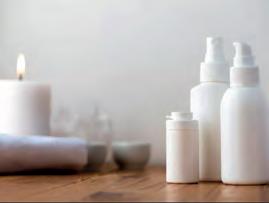
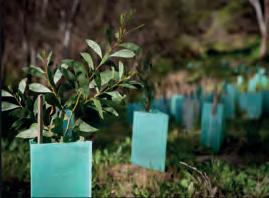
Informare per scelte sostenibili e consapevoli
«Il primo problema che si dovrebbe affrontare - esordisce Krpan - è la capacità del consumatore di distinguere tra plastica post consumo e plastica postindustriale. Le plastic tax, di cui i cittadi-
There’s plastic and plastic
The FKuR Group, specialised in the production of bioplastic and recycled compounds intended for flexible packaging, technological applications, TPE and PP/PE compounds, offers the market extensive experience on the theme of packaging and sustainable materials. Karel Krpan, sales agent for Italy in FKuR Kunststoff GMBH, talked to ItaliaImballaggio about this, sharing a series of reflections starting from the relationship between industrial and post-consumption recycling, moving on to regulatory questions and market trends.
Enabling sustainable and informed choices
«The first problem that needs to be tackled - Krpan begins - is the
ni sentono parlare quotidianamente, si riferiscono infatti alla plastica post consumo, che è tipicamente ibrida, contaminata e richiede un complesso ciclo di lavorazione per essere riciclata. L’aspetto distorsivo a livello di materiali è quindi determinato da un mercato che richiede plastica riciclata senza distinguere o addirittura ignorando l’esistenza del post-industriale, un materiale più pulito e omogeneo. Lo scarto industriale infatti è spesso rappresentato da un singolo materiale, con un basso grado di contaminazione che viene inserito nell’ampio concetto di riciclato quando, nei fatti, potrebbe essere considerato materia prima seconda».
Secondo Krpan nel mercato si è apparentemente creata una bolla, in cui il materiale post-industriale sembra assumere un valore commerciale molto elevato,
considered as a second raw material».
According to Krpan, the market has apparently created a bubble, in which the post-industrial material seems to assume a very high commercial value, being a convenient alternative to the more problematic postconsumption material.
consumer’s ability to distinguish between post-consumption plastic and post-industrial plastic. The plastic tax, which citizens hear about every day, refers, in fact, to postconsumption plastic, which is typically hybrid, contaminated and requires a complex processing cycle to be recycled. The distorting aspect in terms of materials is therefore determined by a market demanding for recycled plastic without distinguishing, or even ignoring, the existence of post-industrial material which is cleaner and homogeneous.
Industrial waste is, in fact, often represented by a single material, with a low level of contamination, which is inserted into the wide concept of recycling while, in fact, it could be
poiché comoda alternativa al più problematico post consumo.
«Ci sono denominazioni fantasiose come “contiene riciclato interno” che, per paradosso, potrebbero spingere a un deliberato eccesso di sfrido» prosegue Krpan. «Il mercato finisce quindi per cercare materiale riciclato di qualunque tipo, purché dichiarato tale.»
Krpan prosegue poi ricordando il disappunto di un converter che, dopo aver mandato un campione di film di LDPE post consumo al suo cliente, è stato redarguito per il fatto che fosse opaco, avesse odore e non fosse bello come quello di altri concorrenti che proponevano un generico “riciclato”.
«Bisogna rendersi conto che nelle poliolefine come l’LDPE e HDPE con l’attuale stato di riciclo meccanico del post consumo è estremamente difficile ottenere
«There are imaginative expressions, such as “contains internal recycled material” which, paradoxically, could lead to a deliberate excess of waste» continues Krpan. «The market therefore ends up looking for recycled material of any kind as long as it is declared as such.»
Krpan continues by referring to the disappointment of a paper-converter that, after having sent a sample of post-consumption LDPE film to their customer, was complained to because the sample was opaque, smelled and wasn’t attractive like that of other competitors that offered a generic “recycled” material.
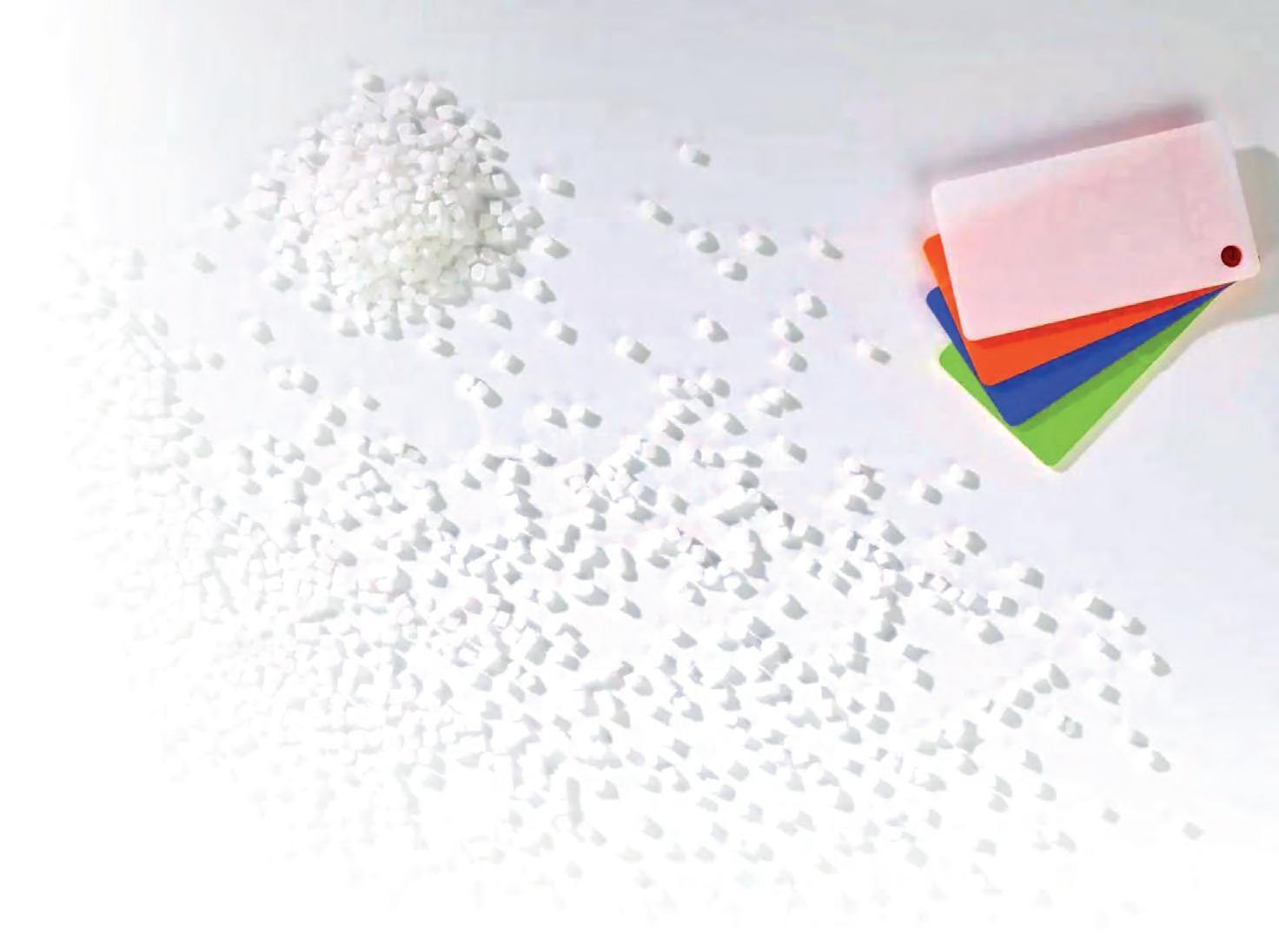
«It’s necessary to understand that in polyolefins like LDPE and HDPE, with
the current mechanical recycling of post-consumption material, it’s extremely difficult to obtain products “equivalent” to the virgin material. If the aim is a sustainable alternative with virgin performances, it’s advisable to turn to bio-based or hybrid solution products, such as those obtained with co-extrusions. It should be noted that there are supply chain certifications that properly distinguish between the use of post-consumption plastic and post-industrial plastic.»
Regulatory impact
To understand the mechanism better, Karel Krpan takes the reasoning to the extreme, hypothesizing a unique European instrument capable of regulating in real time. This would, in fact, prevent virgin material from being improperly treated as recycled to increase the quality perceived by customers. The push to use recycled material is, in fact, determined by national and European laws and regulations which have an impact on
www.italiaimballaggio.it [ ENVIRONMENT & LEGISLATION ] TALES
OF TODAY
Conversation on the concept of recycling with Karel Krpan.
48 • 9/23
M. Costanza Candi
RACCONTI DI OGGI
M. Costanza Candi
un prodotto “pari” al vergine. Se si cerca un’alternativa sostenibile alle performances del vergine è consigliabile rivolgersi ai prodotti biobased o a soluzioni ibride, come quelle permesse dai coestrusi. Va detto che esistono certificazioni di filiera che distinguono con serietà l’utilizzo di plastica post-consumo o quella post-industrial».
L’impatto della normativa
Per capire meglio il meccanismo, Karel Krpan porta il ragionamento all’estremo, ipotizzando che non ci sia uno strumento univoco Europeo capace di vigilare in tempo reale. Questo eviterebbe infatti che materiale vergine venga impropriamente trattato per riciclato per aumentarne la qualità percepita dai clienti. La spinta all’uso di materiale riciclato è infatti determinata da leggi e regolamenti nazionali ed europei, che hanno un impatto sulle dinamiche del mercato e sulle scelte industriali. Su questo punto Krpan prosegue:
«Il Regolamento imballaggi sta superando il concetto alla base delle Direttive, provvedimento che lascia agli Stati membri ampio spazio di azione per ragioni di interesse nazionale. Un esempio classico è fornito dalle stoviglie monouso: per evitare che fossero qualificate come tali, i produttori ne hanno semplicemente aumentato lo spessore e fatto dei test di resistenza al lavaggio. Ed ecco sul mercato prodotti apparentemente lavabili e riutilizzabili, ma di fatto di qualità percepita simile a quella dell’usa e getta.»
market dynamics and on industrial choices. On this point, Krpan continues:
«Packaging regulation is superseding the concept underpinning the Directives, leaving member States ample room for action driven by national interest. A classic example is provided by disposable tableware: to prevent it being classified as such, manufacturers have simply increased the thickness and carried out washing resistance tests. And now we have apparently washable and reusable products on the market, but of a quality perceived as being similar to that of disposable products.»
Chemical recycling vs mechanical recycling
The regulatory framework should, therefore, take into account existing technological solutions, driving the market towards being more sustainable on the basis of the type of material and on enterprises’ ability to use it. A pertinent example is the debate revolving around the
Riciclo chimico vs riciclo meccanico
Il quadro normativo dovrebbe quindi tenere in considerazione le soluzioni tecnologiche esistenti, veicolando il mercato verso le più sostenibili in base alla tipologia di materiale e alla capacità delle imprese di disporne. È il caso del dibattito che ruota attorno al riciclo meccanico o chimico di materiale postconsumo.
«L’Europa sta opponendo una forte resistenza al riciclo chimico, anche se molto sostenuto dai gruppi multinazionali che possono mettere in campo percorsi di compensazione tra rinnovabili, decarbonizzazione e crediti. Come sappiamo infatti, il riciclo chimico permette di unire tutto il prodotto senza separare: grazie alla pirolisi, i polimeri vengono trasformati in nafta con un processo che richiede un’elevata quantità di calore. Per quanto si sa, l’Europa, in questo quadro, punta a limitare la pirolisi solo a ciò che non può essere sottoposto a riciclo meccanico, che viene preferito, ma senza definirne confini chiari.
Il rischio è che una tecnologia molto energivora venga preferita a soluzioni più complesse, come la costruzione di filiere di riciclo basate su specifici materiali. Di fatto la pirolisi potrebbe essere il game changer per evitare di mandare all’incenerimento molta plastica difficilmente selezionabile, ma potrebbe anche essere un soft killer per la filiera del riciclo e di tutti gli sforzi fatti finora nello sviluppo di soluzioni monomateriale.
È chiaro che l’aspetto economico, le regolamentazioni e le tecnologie disponibili faranno la differenza. Infatti oggi il monomateriale è molto richiesto da consumatori e
mechanical or chemical recycling of post-consumption material.
«Europe is putting up strong resistance to chemical recycling, albeit heavily supported by multinational groups that can put in place compensation paths regarding renewables, decarbonisation and credits. As we know, in fact, chemical recycling makes it possible to unite the whole product without separation: thanks to pyrolysis, polymers are transformed into naphtha with a process that requires a high quantity of heat. As far as we know, Europe, in this context, aims to limit pyrolysis only to what cannot be subject to mechanical recycling, which is preferred, but without defining clear boundaries.

The risk is that a very energyintensive technology is preferred to more complex solutions, such as the construction of recycling supply chains based on specific materials. Pyrolysis could effectively be a gamechanger to avoid sending a lot of hard-to-sort plastic, but it could also
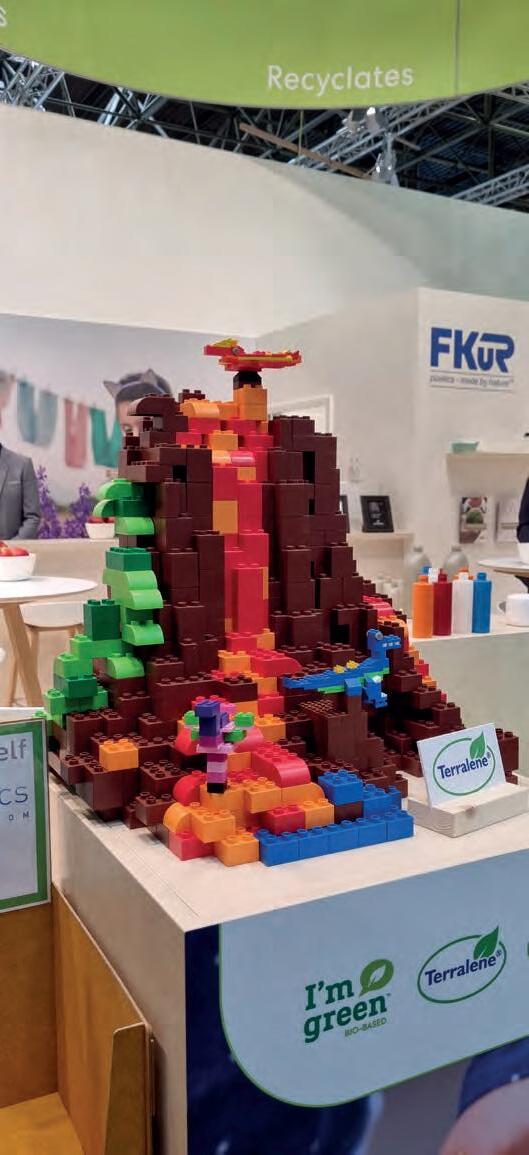
industria, ma la domanda è: il sistema di riciclaggio riesce a riconoscere il materiale e a separarlo correttamente? Abbiamo soluzioni riciclabili o solo potenzialmente riciclabili? Molte aziende produttrici di materiali specifici hanno bisogno di una loro filiera per garantire un monomateriale correttamente separato ed è qui che il sistema deve arrivare: separare costruendo dei percorsi omogenei per i diversi materiali.»
Il ruolo dei produttori
«La responsabilità condivisa del produttore diventa quindi strategica per lo sviluppo di materiale e tecnologia di sorting per il suo corretto recupero. Una soluzione complessa in un mercato dove, al contrario, molti spingono per la soluzione più facile e d’impatto. Pensiamo ai film termoretraibili. Ha più senso un film vergine a basso spessore che richiede meno calore nei forni di retrazione o un film più spesso contenente del riciclato che richiede più energia? Sul fronte dello sviluppo tecnico quindi, le domande sono aperte e aspettano che l’Europa prenda posizione. In FKuR stiamo lavorando PER rispondere a ogni scenario. Accanto alla gamma di compound biodegradabili e compostabili Bio-Flex® e Ceroflex® per film e iniezione, distribuiamo il Green PE e Green EVA di Braskem, polimeri derivati dalla canna da zucchero sulla base del quale produciamo TPE biobased (Terraprene®) e altri compound durevoli, dotati di fonte rinnovabile (Terralene®). Di recente, infine, abbiamo introdotto materiale riciclato post consumo e post industrial di elevata qualità con qualità estetiche e funzionali particolari.»
be a soft killer for the recycling supply chain and for all the efforts made so far in the development of monomaterial solutions. It’s clear that the economic aspect, the regulations and technologies available will make the difference. Today, in fact, the mono-material is much requested by consumers and industry, but the question is: is the recycling system able to recognize the material and separate it correctly? Do we have recyclable solutions or only potentially recyclable ones? Many manufacturers of specific materials need to have their own supply chain in order to guarantee a correctly separated mono-material and it is here that the system has to arrive: separate by constructing homogeneous paths for different materials.»
The role of manufacturers
«The shared responsibility of the manufacturer becomes, therefore, strategic for the development of material and sorting technology for
its correct recovery. It’s a complex solution in a market in which, conversely, many are pushing for the easiest and most impactful solution. Let’s consider shrink film. Does a low thickness film that requires less heat in shrink ovens make more sense than a thicker film containing recycled material that requires more energy? On the technical development front, therefore, the debate is open and needs Europe to take a position. In FKuR we are working to respond to every scenario. Next to the range of Bio-Flex® e Ceroflex® biodegradable and compostable compounds for film and injection, we distribute Braskem Green PE and Green EVA, polymers deriving from sugar cane on the basis of which we produce bio-based TPE (Terraprene®) and other long-lasting compounds with renewable sources (Terralene®). Finally, recently we have introduced high-quality postconsumption and post-industrial recycled material with high aesthetic qualities and particular functions.»
www.italiaimballaggio.it [ ENVIRONMENT & LEGISLATION ] 9/23 • 49
una potenziale serie di difetti, il controllo operato da tecnologie pre-neurali non raggiunge la perfezione, comportando costose rilavorazioni o, nel peggiore dei casi, l’immissione sul mercato di un prodotto con standard inferiori alle attese, con gravi rischi in termini di brand reputation.
L’AI nel rossetto
L’AI nel rossetto
Da Sea Vision, un sistema di visione dedicato alla più iconica delle formulazioni cosmetiche.
In quello che passerà alla storia come l’anno in cui l’Intelligenza Artificiale è arrivata al grande pubblico, SEA Vision presenta a-eye lipstick, il suo nuovo sistema di controllo dei rossetti basato su AI. La soluzione ambisce a migliorare il confezionamento di questo cosmetico, attualmente considerato tra i più venduti al mondo: obiettivo raggiunto attraverso l’automatizzazione di processi, finora in larga parte affidati al controllo umano.
Affrontare standard non uniformi. Le numerose peculiarità estetiche e la com-
AI in lipstick
From Sea Vision comes a visual inspection system dedicated to the most iconic cosmetic formulations.

In what will go down in history as the year Artificial Intelligence becomes widely available, SEA Vision introduces a-eye lipstick, a new AI-based lipstick inspection system. The solution aims to improve the packaging of a product currently recognised as one of the world’s best-selling cosmetics. This goal was achieved by automating processes that, until now, were largely subject to human control.
Dealing with inconsistent standards. The numerous distinctive aesthetic features together with the complexity of the industrial process required to perfectly amalgamate the pigments, oils, waxes and emollients in its
plessità del processo industriale deputato all’amalgama di pigmenti, oli, cere ed emollienti che ne compongono la pasta, complicano il processo produttivo del rossetto e rendono particolarmente difficile il controllo qualità. Ancora oggi, nonostante gli sforzi compiuti in fase di produzione per prevenire e controllare
Sea Vision e Marchesini Group
AI per una qualità superiore. L’applicazione dell’AI promette di porre rimedio a gran parte delle potenziali difettosità in questo ambito. A-eye lipstick, sviluppato da un team composto da esperti di SEA Vision e della controllata ARGO Vision, si basa sulla segmentazione semantica delle aree del rossetto, con l’obiettivo di identificare pixel-by-pixel ogni possibile imperfezione. Il sistema è in grado di discernere difetti sempre più vari e complessi, grazie a un processo di apprendimento basato su dataset proprietari - un mix di immagini reali e sintetiche generate con tecniche avanzate di Data augmentation e Neural Generation

Fondata a Pavia nel 1995, Sea Vision è produttore di spicco di sistemi per la tracciabilità, la raccolta dati e l’ispezione nel settore del confezionamento di prodotti farmaceutici e cosmetici.
Oggi è un gruppo multinazionale con numerose filiali nel mondo, dove lavorano oltre 330 persone che condividono l’obiettivo di trovare soluzioni nuove e ingegnose che vanno oltre le convenzioni.
mondiale nella progettazione e realizzazione di macchine per il packaging, che ne completa l’acquisizione nel 2022. A seguito dell’operazione, Pietro Cassani, AD di Marchesini Group, diventa presidente del CdA di SEA Vision Group, dove siede anche Michele Cei, co-fondatore dell’azienda lombarda, che mantiene il ruolo di amministratore delegato.
Sea Vision and Marchesini Group
formula mean that lipstick is complicated to produce and to verify in terms of product quality. Even today, despite all the efforts made during production to prevent and control a whole series of potential defects, some flaws still pass through controls performed by pre-neural technology undetected. This leads to costly reprocessing or, in the worst-case scenario, to placing these sub-standard products on the market, posing serious risks for businesses in terms of brand reputation.
AI for higher quality. The use of AI sets out to remedy a large proportion
Dopo oltre 20 anni di fruttuosa e consolidata collaborazione, nel 2018 SEA Vision cede il 48% delle proprie quote a Marchesini Group, leader
Founded in Pavia in 1995, Sea Vision is a leading manufacturer of traceability, data collection and inspection systems for the
of these potential defects. A-eye lipstick, developed by a team of experts from SEA Vision and its subsidiary ARGO Vision, is based on semantic segmentation of the lipstick areas in order to identify every possible flaw pixel-by-pixel. The system learns how to discern an ever-increasing variety of complex defects. Learning takes place both on the basis of proprietary datasets – a mix of real and synthetic images generated with the most advanced data augmentation and neural
generation techniques – and by combining different parameters and patterns observed over time.
Machine learning applied to cosmetics. The a-eye lipstick technology aims to generalise the “concept” of lipstick, making the algorithms more and more specialised in quality control regardless of the product’s possible shape, colour and texture (e.g. satin, transparent, matt, pearl, glitter, etc.). As Alessandro Ferrari,
www.italiaimballaggio.it 50 • 9/23
[ MATERIALS & MACHINERY ] COSMOPHARMA
-, combinando i parametri e i diversi modelli osservati nel tempo.
Machine learning applicato al cosmetico. La tecnologia a-eye lipstick mira a generalizzare il “concetto” di rossetto, rendendo gli algoritmi sempre più specializzati nel controllo qualità, indipendentemente dalla forma, dal colore e dalla texture (es.: satinata, trasparente, opaca, perlata, glitterata o altro) che il prodotto può assumere, come spiega Alessandro Ferrari, AD di ARGO Vision: «C’è un aspetto che contraddistingue questa innovazione, differenziandola dai tradizionali sistemi di visione che sono solitamente in grado di riconoscere la presenza di difetti sulle immagini attraverso il confronto con modelli già noti in partenza. Si tratta della capacità del sistema di apprendere dagli esempi passati, incrementando costantemente la propria capacità di analisi, che è più o meno quello che facciamo noi umani quando impariamo dall’esperienza».
pharmaceutical and cosmetics packaging sectors. Today, it is a multinational corporation with numerous subsidiaries worldwide, employing over 330 people, who all share the goal of finding innovative and creative solutions that go beyond norms. In 2018, after more than 20 years of successful collaboration, SEA Vision sold 48% of its shares to Marchesini Group, a global leader in the design and manufacture of packaging machinery. The acquisition was completed in 2022. Following this transaction, Pietro Cassani, CEO of Marchesini Group, was appointed Chairman of the Board of Directors at SEA Vision Group, while Michele Cei, co-founder of the Lombard company, continues to serve as the CEO.
CEO of ARGO Vision, explains: “There is one aspect that distinguishes this innovation, differentiating it from conventional vision systems which can detect defects in images through comparison with models already known at the outset. It is about the system’s ability to learn from past examples, and thus constantly increasing its analysis capability, which is more or less what we humans do when we learn from experience.”
Presente e futuro del riempimento asettico
Proposti in anteprima mondiale a Interpack 2023 da IMA Life, il tunnel di decontaminazione ad alta velocità NEBULA e INJECTA 36, soluzione di riempimento innovativa per siringhe, flaconi e carpule pre-ghierate ready to use (RTU).
NEBULA. Il tunnel di decontaminazione ad alta velocità si integra perfettamente con le linee di riempimento asettiche di IMA Life e costituisce un approccio senza precedenti per ga rantire la sterilità al 100% di tub o trays contenenti componenti RTU, in ingresso e trasferimento all’in terno di linee isolate. In risposta alle guidelines GMP Annex 1 di recente pubblicazione, in base alle quali i rischi legati alla garanzia di sterilità devono essere ridotti al minimo durante il trasferimento del materiale e devono essere supportati da una tecnologia di trasferimento ad alta capacità, NEBULA realizza ciò che nessun’altra soluzione ha mai fatto prima, soprattutto in termini di velocità. La decontaminazione a 6 log viene ottenuta sull’intero tub/tray packaging utilizzando il contenimento aerodinamico del perossido di idrogeno sotto forma di vapore altamente concentrato (HCVPHP), mentre il packaging attraversa il tunnel in pochi secondi. Ciò consente l’introduzione continua e ad alta velocità del tub/tray packaging fino a sei unità al minuto. Il tunnel è composto da una serie di camere in cui la pressione è gestita per
Present and future of aseptic filling
For the first time on display (exclusive insight) at Interpack 2023, the latest innovations by IMA Life: NEBULA, high-speed decontamination tunnel, and INJECTA 36, the latest fill-finish solution for RTU syringes, vials and pre-capped cartridges.

NEBULA. Adopting an unprecedented approach to ensuring 100% sterility of RTU material as it enters and transits isolated production lines, NEBULA is a high-speed decontamination tunnel which integrates seamlessly with IMA Life aseptic fill-finish lines. Responding to the recently published GMP Annex 1 notes whereby risks linked with sterility assurance must be minimised during material transfer and must be supported by high capability transfer technology, NEBULA accomplishes what no other solution has done before, especially in terms of speed.
6-log decontamination is achieved over the entire packaging using aerodynamic containment of highly concentrated vapour phase hydrogen peroxide
garantire la massima sicurezza sia per l’operatore che per la camera bianca, evitando la circolazione di perossido di idrogeno all’interno dell’isolatore. Il sistema può essere collegato a impianti di riempimento asettici per ottimizzarne le La flessibilità operativa viene migliorata evitando la complessità legata alle procedure di cambio formato e riducendo in modo drastico la sensibilità della macchina ai componenti e al materiale di confezionamento.
INJECTA 36 Grazie alla robotica avanzata, consente di elevare lo standard per il riempimento asettico e ad alta velocità di siringhe, flaconi e carpule pre-ghierate RTU. L’impiego di tecnologie robotiche d’avanguardia garantisce un’accurata lavorazione dei componenti, evitandone il contatto diretto (tecnologia No-TouchTransfer) e con il minimo intervento dell’operatore nell’area di lavoro. Grazie all’introduzione di una soluzione per il controllo del processo e del peso al 100% (IPC), INJECTA 36 consolida IMA Life quale attore chiave nel segmento ready to use delle macchine riempitrici in asettico, massimizzandone le prestazioni produttive.
(HC-VPHP), while material crosses the tunnel in a matter of seconds. This allows for continuous, high-speed tub introduction, up to six per minute. The tunnel is comprised of a series of chambers in which pressure is managed to ensure maximum safety for both operator and cleanroom, avoiding hydrogen peroxide circulation within the isolator. NEBULA is a system which can be connected to aseptic fill-finish plants to enhance their performance. On one hand, operational flexibility is significantly improved by avoiding the complexity involved in changeover procedures and drastically reducing the machine’s sensibility to packaging make-up and material.
INJECTA 36. Enhancing the performance of advanced robotics, the INJECTA 36 raises the bar for high-speed production of Ready-To-Use components (syringes, vials and pre-capped cartridges). The same cutting-edge robotic technologies assure accurate no-touch-transfer component processing with minimal operator access to the working area. Introducing an innovative solution for 100% In-Process Control and check-weighing, INJECTA 36 consolidates IMA Life as a key player in the Ready-ToUse segment for automatic filling & closing machines to maximise production performance.
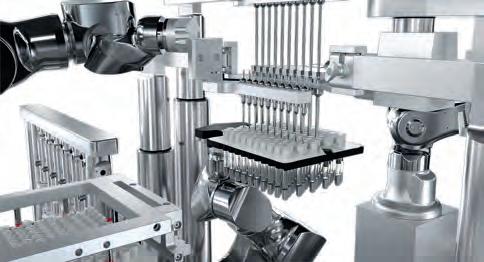
www.italiaimballaggio.it
COSMOPHARMA [ MATERIALS & MACHINERY ]
9/23 • 51
Tecnologie specializzate per il riempimento liquidi
Facendo tesoro della lunga esperienza, ACMA ha deciso di far evolvere la propria tecnologia del riempimento liquidi proponendo una serie di nuove soluzioni: il portafoglio di piattaforme rinnovate e specifiche per il Personal Care, l’Home Care e gli Oli (sia edibili che minerali).
Nel mondo delle macchine automatiche, poche aziende possono vantare l’esperienza ingegneristica di ACMA, le cui radici affondano negli albori del packaging e che, nello specifi-
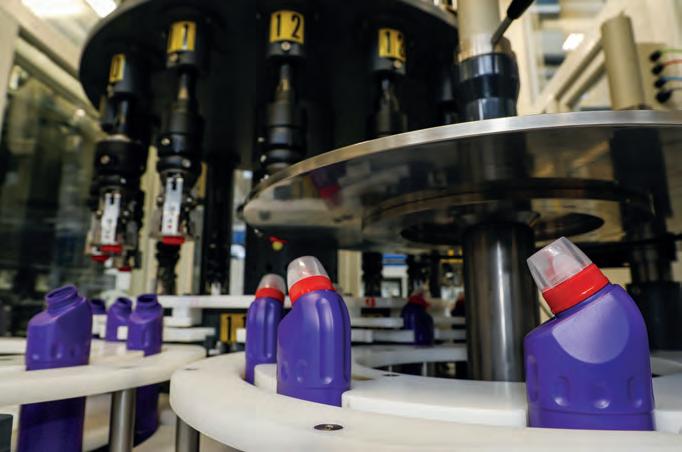
co settore del riempimento liquidi, ha portato a installare oltre 700 macchine in tutto il mondo.
L’importanza di essere il partner giusto. Da sempre, ACMA propone ai propri clienti soluzioni innovative, cost-effective e customizzate, rispondendo alle esigenze industriali focalizzate su una richiesta di automazione sempre crescente, grande affidabilità dei macchinari, oltre che precisione e riduzione degli sprechi di prodotto. Con questa operazione, ACMA riposiziona la propria offerta di macchine per riempimento liquidi in base agli specifici mercati: Personal Care, Home Care e Oli (edibili e minerali). Ognuno di questi settori presenta, infatti, alcune criticità in termini di gestione del prodotto e delle tempistiche di produzione, pulizia macchinario e costi di mantenimento. In ambito Home Care, per esempio, si ha spesso a che fare con prodotti corrosivi, che impongono specifici trattamenti ai vari componenti della macchina. Al contempo, vengono richieste alte velocità e unità capaci di lavorare su più turni in maniera continuativa.
L’ambito Personal Care richiede invece frequenti cambi formato, data
Specialised technologies for liquid filling
In the world of automatic machines, few companies can boast ACMA’s engineering experience, with roots going back to the dawn of packaging and which, in the specific sector of liquid filling, has led to the installation of over 700 machines throughout the world.
The importance of being the right partner. ACMA has always offered
its customers innovative, costeffective and customised solutions, responding to industrial needs, focused on the increasing demand for automation and high machinery reliability, as well as precision and the reduction of product waste. With this operation, ACMA repositions its offer of liquid filling machines on the basis of specific markets: Personal Care, Home Care and Oils (edible and mineral).
la presenza di molteplici combinazioni di tappi e bottiglie, nonché tempi di fermo macchina ridotti al minimo, quindi capacità di cambio formato molto veloce ed efficiente. È, inoltre, un settore caratterizzato dalla presenza di prodotti spesso viscosi, che rendono critiche alcune operazioni come la pulizia del serbatoio.
“LRF - PC” sarà quindi la piattaforma tecnologica dedicata al Personal Care, “LRF - HC”, quella per l’Home Care e “LRF - OI” quella per gli oli.
Differenti tecnologie, stessi vantaggi. Nonostante le problematiche specifiche dei tre settori e la conseguente offerta diversificata a seconda delle necessità del cliente, ACMA garantisce vantaggi comuni a tutte le soluzioni.
Anzitutto la flessibilità delle macchine, vero e proprio marchio di fabbrica di ACMA. Le piattaforme consentono infatti di riempire flaconi o bottiglie di diverse tipologie e dimensioni, con sistemi di tappatura molteplici, consentendo al contempo cambi formato in tempi ridotti e senza la necessità di utilizzo di attrezzi secondo una logica toolless e plugand-play.
Precisione e accuratezza di riempimento sono altre due caratteristiche fondamentali che vengono raggiunte grazie al sistema a peso netto in cui si effettua il controllo su ogni singola bottiglia. Questa feature è necessaria per rientrare negli standard di riempimento produttivi e viene gestita con una precisone unica sul mercato.
Le macchine ACMA operano, inoltre, se-
Each of these sectors has, in fact, specific requirements in terms of product management and production times, machine cleaning and maintenance costs. In the context of Home Care, for example, corrosive products are quite common, requiring specific treatments on various parts of the machine. At the same time, there is a demand for high speeds and units capable of working on several shifts on a continuous basis.
The Personal Care sector requires, instead, frequent format changes, given the presence of multiple combinations of caps and bottles; it also needs stoppage times reduced to a minimum, and so, very rapid and efficient format change capacity. It is, moreover, a sector characterised by the presence of
often very viscose products, making certain operations, such as tank cleaning, potentially problematic.
“LRF - PC” will, therefore, be a technological platform dedicated to Personal Care, “LRF - HC” to Home Care and “LRF - OI” to oils.
Different technologies, same advantages. Despite the specific problems of the three sectors and the consequent diversified offer according to customer needs, ACMA guarantees advantages common to all the solutions. First of all, the flexibility of the machines, a veritable ACMA “trademark”. The platforms make it possible, in fact, to fill containers and bottles of different types and sizes with multiple capping
www.italiaimballaggio.it [ MATERIALS & MACHINERY ] MULTIMARKET
52 • 9/23
Building upon its long experience, ACMA has decided to evolve its liquid filling technology, proposing a series of new solutions: a portfolio of renewed and specific platforms for Personal Care, Home Care and Oils (both edible and mineral).
condo una logica di smart filling: minimizzando la quantità di prodotto nel serbatoio mediante un sistema di controllo brevettato - il Virtual Level System (VLS) - e ottimizzando la velocità di dosaggio del prodotto con un sistema di misurazione costante della viscosità e della temperatura, si arriva alla riduzione massima degli scarti. Anche le operazioni di manutenzione vengono tenute in considerazione in fase progettuale: tutte le soluzioni Acma sono ingegnerizzate per massimizzare l’efficienza, riducendo i costi di mantenimento.
Nota.
Secondo un report redatto da Mordor Intelligence, nel 2023 il mercato del packaging per il Personal Care raggiungerà i 30,53 miliardi di dollari, destinati a toccare i 39,85 miliardi entro il 2028, con un tasso di crescita annuo pari al 5.47%. Sempre nel 2023, si stima che il mercato del packaging per i prodotti Home Care sarà di 33,55 miliardi di dollari, che saliranno a 43,68 entro il 2028, con un tasso di crescita annuo pari al 5,42%.
(Fonte: https://www.mordorintelligence.com)
systems, allowing, at the same time, format changes in reduced times and without the need to use equipment according to a toolless and plug-and-play logic.
Precision and accuracy are another two fundamental characteristics achieved thanks to a net weight system in which a check is carried out on every single bottle. This feature is necessary for complying with production filling standards and is managed with a precision which is unique in the market.

ACMA machines operate, moreover, according to a “smart filling” logic: minimising the quantity of product in the tank through a patented control system - the Virtual Level System (VLS) - and optimising the speed of
28 – 30 November 2023
Nuremberg, Germany
dosage with a system that constantly measures viscosity and temperature, results in a maximum reduction of waste.

Maintenance operations are also considered in the design phase: all Acma’s solutions are engineered for maximum efficiency, reducing maintenance costs.
Find out what drives the beverage industry worldwide.


Do you want to keep an eye on current topics relating to packaging and logistics in the beverage industry? Then you can‘t miss BrauBeviale in Nuremberg.

The international community of the beverage industry will meet here from 28 – 30 November 2023. Be part of it!
Note.
According to a report drawn up by Mordor Intelligence, in 2023 the packaging market for Personal Care will reach 30.53 billion dollars, and is projected to arrive at 39.85 billion by 2028, with an annual growth rate of 5.47%.
Again in 2023, it is estimated that the packaging market for Home Care will be worth 33.55 billion dollars, which will rise to 43.68 by 2028, with an annual growth of 5.42%.
(Source: https://www.mordorintelligence. com)
braubeviale.de/en
www.italiaimballaggio.it MULTIMARKET [ MATERIALS & MACHINERY ]
Reliable dosing and packaging in small spaces
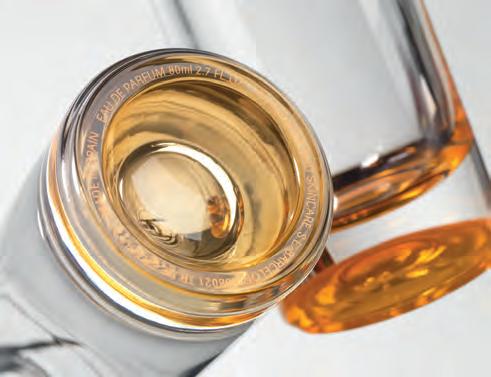
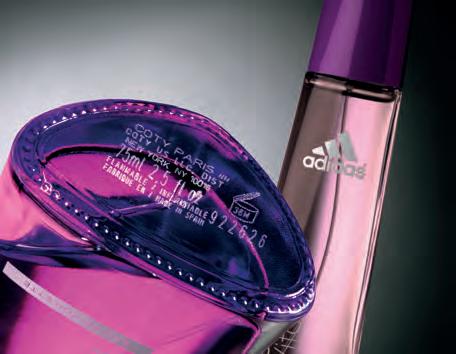

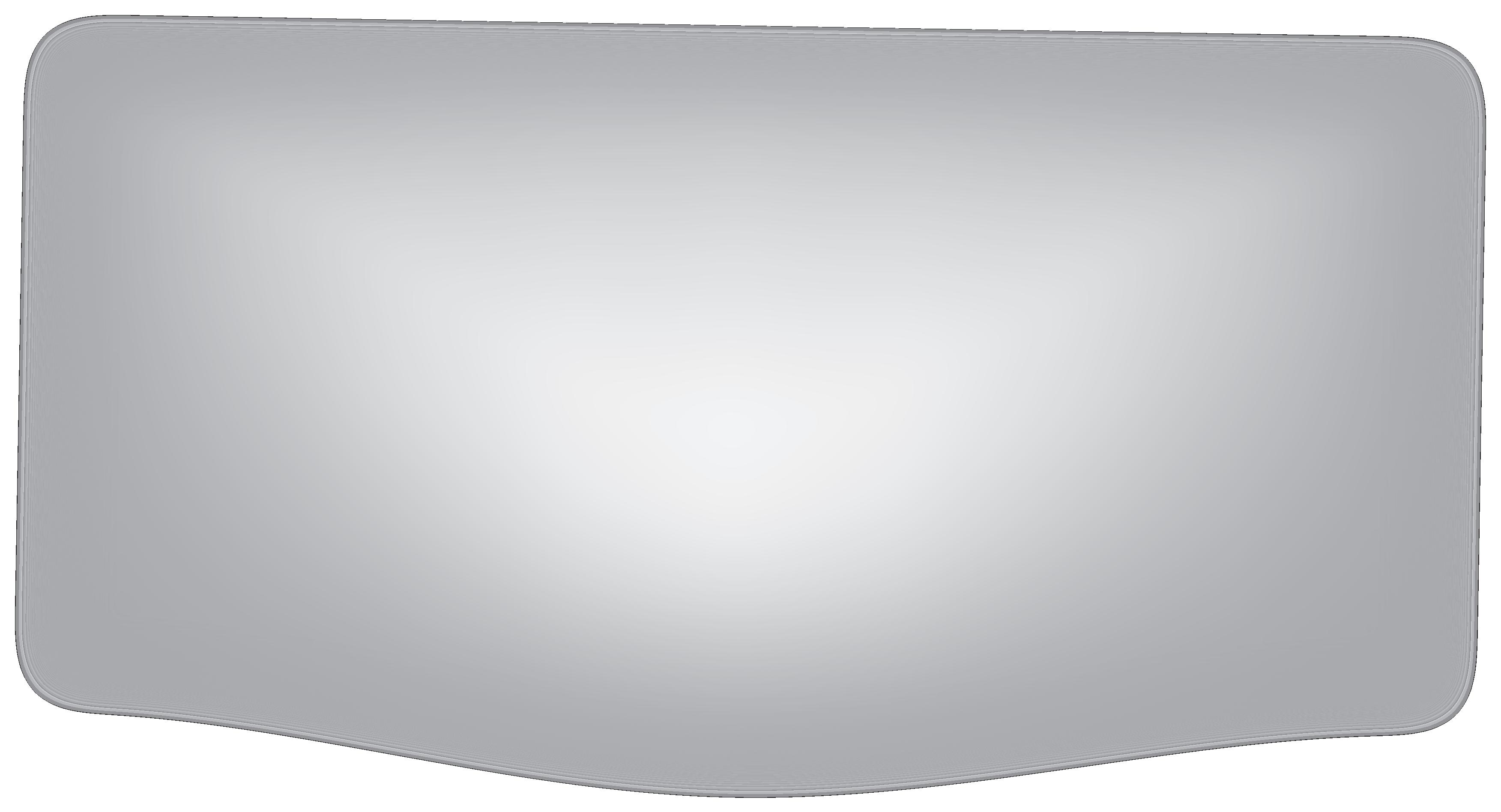
The success story of Seven Fluss and of the Tecno Fluss brand continues. ItaliaImballaggio has recently met Stefano Marengo, Executive Managing Director of Seven Fluss at interpack 2023, who summarised the evolution of the company in this way: «Our points of strength include reliability guaranteed by mass and magnetic dosing systems that facilitate cleaning and capping activities, characterised by a turret equipped with silent anti-vibration gears that makes the system very compact.».
Solutions presented in the stand included the new monobloc in the Precysa series for filling ad capping, equipped with 12 mass filling systems and 4 capping heads. Available in 7 versions, Precysa reaches dosing speeds in a range from 6,000 to 18,000 pieces per hour (100 - 300 pieces per minute).

Looking at the linear solutions, such as Calybra, presented in the fair, the different models have been developed for dosing from 1 to 12 dosing units with magnetic and volumetric mass systems suitable for different products. They range from frothy products, for which an anti-foam lift system has been set up, to explosive spirits – therefore Atex compliant – and acids, for the management for which the company has used modules with plastic components.
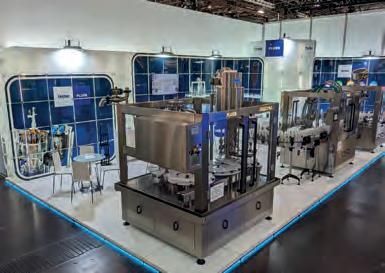
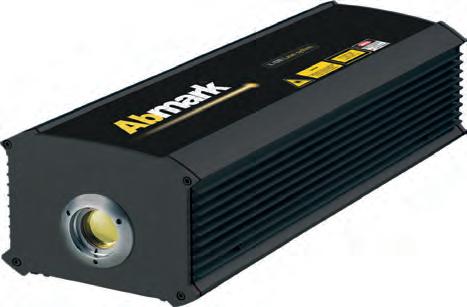
Dosaggio e confezionamento affidabili in spazi ridotti
Prosegue il percorso di successo di Seven Fluss e del brand Tecno Fluss. ItaliaImballaggio ha di recente incontrato Stefano Marengo, Executive Manager Director di Seven Fluss a interpack 2023, che ha sintetizzato così l’evoluzione dell’azienda: «Tra i nostri punti di forza, troviamo l’affidabilità garantita dai sistemi di dosaggio massici e magnetici che favoriscono le attività di pulizia e la tappatura, caratterizzata da una torretta dotata di ingranaggi silenziati anti-vibra -

zione che garantisce grande compattezza al sistema.». Tra le soluzioni in evidenza allo stand, ricordiamo la nuova monoblocco della serie Precysa per riempimento e tappatura, dotata di 12 sistemi massici di riempimento e 4 teste di tappatura. Declinata in 7 versioni, Precysa raggiunge velocità di dosaggio in un range da 6.000 a 18.000 pezzi ora (100 - 300 pezzi al minuto). Guardando alle soluzioni lineari come Calybra, presente in fiera, i diversi modelli sono stati sviluppati per dosare da 1 a 12 gruppi di riempimento con sistemi massici magnetici e volumetrici adatti a prodotti diversi. Si spazia infatti dagli schiumosi, per i quali è stato predisposto un sistema di risalita anti-schiuma, agli alcoolici esplosivi - quindi con costruzione Atex- fino agli acidi, per la cui gestione l’azienda ha utilizzato moduli in componenti plastici.

MARCATURA LASER: INDELEBILE
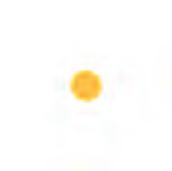
www.italiaimballaggio.it 54 • 9/23 CO&MA S.r.l. | Via Parini, 3 | 40033 Casalecchio di Reno (BO) | Tel. +39 051.4985029 | www.coema-coding.com
CODIFICA E MARCATURA
L'UNICA TECNOLOGIA CHE OFFRE UNA SOLUZIONE ANTICONTRAFFAZIONE EFFICACE AL 100%
Distributore in esclusiva dei sistemi di marcatura
[ MATERIALS & MACHINERY ] MULTIMARKET
L’industria del packaging ha individuato nei monomateriali, nella carta e nel cartone i materiali di confezionamento più sostenibili. Tuttavia, sigillare in modo sicuro ed esteticamente perfetto questi materiali delicati pone una sfida non trascurabile ai processi di giunzione convenzionali. Fatti i debiti confronti, secondo una nota firmata da Andreas Runck (sviluppatore dei sistemi in Herrmann Ultraschall), la tecnologia di saldatura a ultrasuoni rende il processo semplice ed efficiente.
Processi tradizionali vs ultrasuoni
I processi convenzionali, come la sigillatura a caldo, raggiungono rapidamente i loro limiti, perché funzionano con calore applicato dall’esterno, che
I monomateriali?
Saldabili a ultrasuoni
Nel solco della sostenibilità, la tecnologia a ultrasuoni di Herrmann Ultraschall garantisce la sigillatura sicura dei materiali riciclabili e un’estetica impeccabile degli imballaggi.
e adattata alle proprietà di ogni singolo materiale. Ciò garantisce un risultato riproducibile con un’estetica impeccabile, anche con finestre di lavorazione molto strette.
modo esteticamente impeccabile imballaggi sostenibili realizzati, per esempio, con monomateriali.
può determinare contrazione e raggrinzamento del film, pregiudicando l’ermeticità e l’aspetto estetico della confezione.
Come conseguenza, i tassi di scarto sono elevati e causano inutili sprechi, sia delle confezioni sia degli alimenti. Con gli ultrasuoni, l’energia termica viene generata solo per attrito tra i materiali all’interno della zona di sigillatura. Inoltre, l’energia può essere controllata con precisione
Una tecnologia a basso consumo energetico
Il processo richiede energia solo durante il breve tempo di sigillatura, compreso tra 100 e 200 millisecondi, riducendo in tal modo il consumo energetico fino al 75 per cento. Durante il processo, gli utensili di sigillatura rimangono freddi, consentendo quindi di sigillare in modo affidabile persino i materiali di confezionamento a base carta e a basso contenuto di pla-
it’s possible to seal in an aesthetically flawless way sustainable packaging made, for example, with monomaterials.
Mono-materials? Sealable with ultrasonic
With a view to sustainability, Herrmann Ultraschall’s ultrasonic technology guarantees the safe sealing of recyclable materials and flawless packaging aesthetics.
The packaging industry has identified mono-materials, paper and cardboard as the most sustainable packaging materials. Sealing these materials in a safe and aesthetically flawless way, however, poses a significant challenge to conventional joining processes. After making due comparisons, according to Andreas Runck (systems developer in Herrmann Ultraschall), the ultrasonic sealing system makes the process simple and efficient.
Traditional systems vs ultrasonics
Conventional processes, such as heat-sealing, rapidly reach their limits, since they function with heat applied externally, which can lead to the film shrinking and wrinkling, compromising the airtightness and aesthetic appearance of the package.
As a result, reject rates are high and cause unnecessary waste, both of packages and foods. With ultrasonic, thermal energy is generated only due
to the friction between the materials inside the sealing zone. In addition, the energy can be precisely controlled and adapted to every individual material. This guarantees a reproduceable result, also with very narrow processing windows.

A low energy-consumption technology
The process requires energy only during the short sealing time, between 100 and 200 milliseconds, reducing energy consumption in this way by up to 75 percent. During the process, the sealing tools remain cold, making it possible, therefore, to reliably seal also
packaging which is paper-based and with a low plastic content. This is true both for the thinnest and thickest layers of paper, such as the cardboard used in beverage packaging.
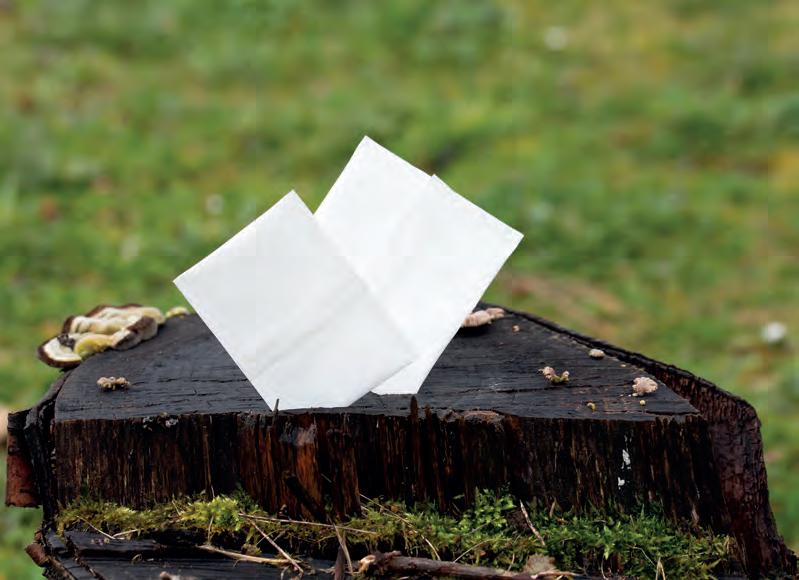
Material analysis for the best sealing solution
Cartons for beverages, in particular, have a thin layer of aluminium inside, which makes it possible to seal the package by induction. For ecological reasons, however, an ever-higher number of companies are planning to eliminate this layer in packaging: for these applications, it’s therefore necessary to find alternative joining
www.italiaimballaggio.it MULTIMARKET [ MATERIALS & MACHINERY ] 9/23 • 55
Figura 2. Nel laboratorio a ultrasuoni, grazie a test elaborati, è possibile verificare la saldabilità dei materiali di confezionamento sostenibili.
Figure 2. It’s possible to verify the sealability of sustainable packaging materials with tests performed in the ultrasonic workshop.
Figura 1. Con gli ultrasuoni è possibile sigillare in
1
Figure 1. With ultrasonic,
stica. Ciò vale sia per gli strati di carta più sottili sia per quelli più spessi, come il cartoncino utilizzato nel confezionamento delle bevande.
Analisi del materiale per la soluzione di saldatura ottimale
Controllo senza difetti di etichette e imballaggi flessibili
Prati ha completamente riprogettato il tavolo di controllo JUPITER e presenta il nuovo modello TCWM (Tavolo di Controllo Wide Modular).
PREVIEW @ INTERPACK
Le confezioni di cartone per bevande, in particolare, presentano un sottile strato di alluminio all’interno, che rende possibile la sigillatura della confezione tramite induzione. Per motivi ecologici, un numero sempre maggiore di aziende sta però progettando di eliminare quello strato dagli imballaggi: per queste applicazioni diventano pertanto necessari processi di giunzione alternativi, come la sigillatura a ultrasuoni.
4-10 MAY 2023
n Con JUPITER TCWM, Prati passa da una struttura rigida a una completamente modulare, dove lo sviluppo orizzontale del flusso di materiale è stato di aiuto nella riprogettazione. La completa modularità consente inoltre di offrire ai clienti una macchina totalmente configurabile, pur mantenendo tutti i vantaggi della standardizzazione dei singoli moduli in termini di ripetibilità e qualità. Per questo motivo non parla di macchina, bensì di piattaforma, ossia una base per futuri sviluppi e configurazioni.
Totale riproducibilità dell’etichetta finita
Costruito per comunicare con i workflow link di tutti i marchi, il tavolo di controllo JUPITER funziona alla massima velocità e si ferma solo per consentire l’eliminazione o la correzione dei difetti predefiniti. Grazie all’esclusivo sistema automatico di gestione del flusso di lavoro, quando il tavolo si ferma, l’azione correttiva viene eseguita in maniera automatica, garantendo sempre un risultato finale privo di difetti, fattore determinante per ottenere la totale riproducibilità dell’etichetta finita e azzerare il rischio di errore umano.
world tour 2023
L’uso degli ultrasuoni facilita in tal modo il passaggio ai monomateriali o ad altri materiali di confezionamento riciclabili e apre la via a un processo di confezionamento più sostenibile.
Quando si passa ai monomateriali o a materiali di confezionamento a base carta, può essere sufficiente rettificare i parametri di saldatura. Tuttavia, soprattutto in caso di utilizzo di nuovi tipi di film, potrebbe essere necessario sviluppare un processo di saldatura completamente nuovo. Solo in questo modo è possibile garantire un processo affidabile con sigillature ermetiche ed estetica perfetta. Per valutare se un materiale o la sua composizione possono essere sigillati con gli ultrasuoni, vengono condotti test di fattibilità in laboratori a ultrasuoni.
processes, such as sealing with ultrasonic.
The use of ultrasonic facilitates, in this way, the transition to mono-materials or other recyclable packaging materials and opens up the way to a more sustainable packaging approach.
It may be sufficient to adjust the sealing parameters when passing to mono-materials or paper-based packaging materials. It could be necessary, however, to develop a completely new sealing process, especially in the case of using new types of film. Only in this way will it be possible to guarantee a reliable process with hermetic seals and flawless aesthetics. Feasibility testing in ultrasonic laboratories is carried out to assess whether a material or its composition can be sealed with ultrasonic.
Con una semplice regolazione, l’innovativo sistema di coltelli taglia un’ampia varietà̀ di supporti plastici e cartacei anche a velocità molto elevate. Può gestire diversi materiali da 12 a 450 µm con tre diverse tensioni di ribobinatura per film non supportati, etichette autoadesive ed etichette “clear-on-clear”.
NAIROBI
Rispetto ai precedenti modelli il TCWM è di fascia alta e modulare. E, grazie allo sbobinatore indipendente, il cliente non è vincolato a una determinata configurazione, perché può personalizzare la macchina secondo le proprie esigenze. Altra novità è rappresentata dal sistema di caricamento bobina, riprogettato con un sistema di gancio rapido per una maggiore sicurezza.
LAGOS
ALGERI
ADDIS ABABA
GUADALAJARA
BANGKOK
SHANGHAI
DAKAR
SAN PAOLO
MUMBAI
LAS VEGAS
Control of labels and flexible packaging without defects
ISTANBUL
Prati has completely redesigned the JUPITER inspection rewinder and will be presenting the new TCWM (Tavolo di Controllo Wide Modular).
CHICAGO
HO CHI MINH CITY
With JUPITER TCWM, Prati managed to move from a rigid to a fully modular structure. The horizontal flow of material has helped the company in the redesign. Full modularity has also allowed to offer customers a totally configurable machine whilst maintaining all the advantages deriving from the standardisation of the single modules in terms of repeatability and quality.
developments and configurations. This is without forgetting that high level of configurability also makes it possible to specialise JUPITER for different types of finished product.
ACCRA ERBIL
For this reason, they are not dealing with a machine but, rather, a platform, that is, a base for future
Total reproducibility of the finished label
Built to communicate with all workflow link brands, the rewinder runs at full speed and only stops for pre-defined defects to be removed or corrected.
With the exclusive Automatic Workflow Management System, what makes the difference is when the rewinder stops, any corrective action is entirely automatic and the end result is error-free, every time. Only this way do converters achieve total reproducibility of the finished label by zeroing the risk
of human error.
JUPITER handles multi-substrates from 12 to 450μm with 3 different rewinding tensions for unsupported film, SA labels and clear-on-clear labels.
JUPITER with Automatic Workflow Management System enables fully automatic correction procedures, leading to consistency and failsafe quality of the finished label.
Compared to previous models, the TCWM is high-end and modular. And, thanks to the independent unwinder, the customer is not restricted to a determined configuration, but is able to personalise the machine according to needs. Another new development is the reels loading system, redesigned with a rapid hooking system for greater security.
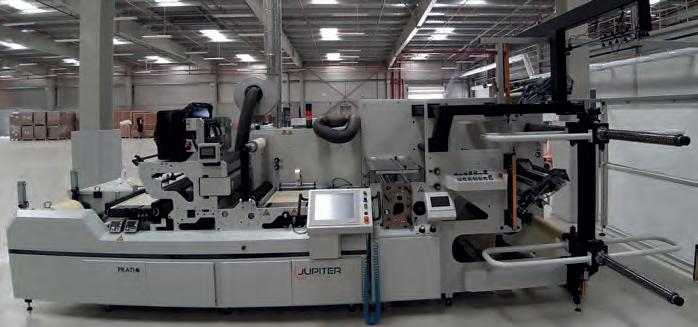
www.italiaimballaggio.it [ MATERIALS & MACHINERY ] MULTIMARKET 56 • 9/23
discover the italian packaging technology wemakepackaging.it
Gamma Hygienic Design più ampia con gli attuatori axenia value
Slungo a un’ampia gamma di sostanze aggressive, come detergenti e disinfettanti, assicurando, al contempo, un accoppiamento preciso e dinamico tra motore e riduttore.
Un attuatore perfetto per svariati settori: alimentare, farmaceutico, medicale, imballaggio e confezionamento.
Spesso in queste applicazioni si preferisce non utilizzare componenti verniciati per evitare il rischio di sfaldamento del colore con conseguente contaminazione del prodotto in lavorazione. Oppure si inseriscono le unità in alloggiamenti in acciaio inox, anche se questo può comportare problemi termici e minor compattezza agli assi.
temperatura, diversi sistemi di feedback e oltre 20 tipi di azionamento di diversi produttori. axenia value can be configured in three motor sizes with acceleration torques of 32 Nm, 80 Nm or 200 Nm and ratios ranging from i=10 to i=25. It’s possible integrate a parking brake, temperature sensors, different feedback systems and over 20 drive types from different manufacturers.
Svantaggi che si riflettono in una maggior complessità progettuale e nell’impiego di elementi di trasmissione meccanici aggiuntivi soggetti ad usura, come leve articolate, alberi o cinghie.
Le soluzioni Hygienic Design, invece, sviluppate secondo le normative FDA e dello European Hygienic Engineering & Design Group (EHEDG), hanno superfici trattate
axenia value actuators extend Hygienic Design line

WITTENSTEIN extends the Hygienic Design line with axenia value, the new compact stainless-steel actuator with single-cable technology.
Specially developed and produced to meet the highest hygiene requirements, axenia value is able to resist for a long time a wide range of aggressive substances, such as detergents and disinfectants, ensuring, at the same time, an absolutely precise and dynamic
coupling between motor and gearbox.
The solution proposed by WITTENSTEIN is an actuator perfect for aseptic applications in various sectors, ranging from food to pharmaceutical, from medical to packing and packaging.
con lucidatura elettrochimica e una forma costruttiva priva di spigoli o solchi. Così il deposito di batteri o microorganismi inquinanti è evitato e la loro pulizia (e quella dell’intero impianto) è più veloce, efficiente e sicura, senza dover ricorrere alla chiusura o alla carterizzazione di intere unità.
Per maggiori informazioni: https://www. wittenstein.it/hygienic-design/
In aseptic applications it is often preferred not to use painted components in order to avoid the risk of the flaking of the colour, with the consequent contamination of the processed product. The units are, therefore inserted in stainlesssteel housings, which can imply thermal problems and less compactness at the axes, leading to disadvantages reflected in greater design complexity and in the use of additional mechanical transmission elements subject to wear, such articulated levers, shafts or belts.
WITTENSTEIN’s
Hygienic Design
solutions, instead, developed according to European Hygienic Engineering & Design Group (EHEDG) standards, have a construction form without sharp edges and grooves which, together with the surfaces treated with electrochemical polishing, prevents the deposit of polluting bacteria or microorganisms, making their cleaning and that of the entire plant quicker, more efficient and safer. In this way, it’s no longer necessary to resort to the closure or protective covering of entire transmission units to combat the risks of pollution and contamination due to germs and microorganisms.
l’informazione continua su more info on l’informazione continua su more info on l’informazione continua &packmedia.net italiaimballaggio.it packagingspeaksgreen.com www.italiaimballaggio.it 58 • 9/23
La linea Hygienic Design WITTENSTEIN si amplia con il nuovo attuatore compatto in acciaio inox a tecnologia monocavo axenia value.
[ AUTOMATION & CONTROLS ]
EVENTI E FIERE RENDONO SPECIALE LA STAGIONE ESTIVA DELL’AUTOMAZIONE
Sono molte le novità sul fronte dell’automazione che hanno animato l’inizio estate 2023, tra manifestazioni fieristiche e celebrazioni di percorsi aziendali pluridecennali, come nel caso di Renishaw, che ha festeggiato i suoi 50 anni in un evento dedicato a clienti e stampa. Guardando alle manifestazioni, proseguiamo nel “raccontare” l’edizione 2023 di SPS (conclusa il 25 maggio scorso), che ha visto un ricco parterre di proposte di automazione, apprezzate dagli oltre 39.000 visitatori che ne hanno affollato i padiglioni. Passeggiando tra gli stand, la redazione di ItaliaImballaggio ha incontrato alcuni importanti player nazionali e internazionali che hanno presentato le loro migliori soluzioni di automazione, tra robotica, sistemi industry 4.0 ready, componentistica e sensoristica. Di alcuni abbiamo avuto modo di parlare sui fascicoli di giugno e luglio/agosto (B&R, Bosch Rexroth, Beckhoff, wittenstein, Emerson, Pilz) e su questo numero della rivista diamo la parola a Image S, Mondial, Wenglor, Robox e igus. Vediamo com’è andata dalla viva voce dei protagonisti.
La proposta di igus motion plastics include anche una serie di interessanti risposte alle esigenze dei mercati food, beverage e pharma senza dimenticare la sostenibilità. Ne parlano Matteo Zaniboni Area Manager Centro Sud e specialista settore Packaging e Marie Olyve, responsabile Marketing. «igus è molto orientata al packaging alimentare e pharma - esordisce Zaniboni - settori dove l’uso della plastica è indispensabile. Noi lavoriamo polimeri ad alte prestazioni con ottime proprietà di attrito e resistenza all’usura. Tra le novità abbiamo quindi ben 7 materiali approvati per l’uso alimentare tra barre, lastre, materiali a nastro da incollare e polvere per il coating di superfici metalliche. A questo si aggiunge, in particolare per il pharma, la gamma di ruote dentate con dimensioni da 3 a 200 mm, su cui operiamo un costante studio di nuovi materiali per renderle adatte ad ambienti dove

si fa largo uso di igienizzanti e prodotti per la sanificazione. Appartengono a questa categoria anche catene portacavi e guide predisposte per la camera bianca, senza lubrificazione e molto silenziose poiché prive di sfere o sistemi metallici, quindi ideali per farmaceutico e ospedaliero.»
igus, da tempo membro dell’associazione EHEDG, ha sviluppato il primo sistema di guide lineari basato sui principi dell’Hygienic Design. L’utilizzo di materiali conformi alle normative FDA, come, ad esempio, il polimero ad alte prestazioni iglidur A160, l’acciaio inossidabile alto legato, la struttura autodrenante e l’interno lavabile del carrello garantiscono la conformità agli standard della progettazione igienica.
«Abbiamo lanciato una guida che può essere pulita senza smontaggio - prosegue Zaniboni - con un innovativo carrello appositamente progettato per il food.
www.italiaimballaggio.it [ AUTOMATION & CONTROLS ]
Tecnopolimeri ad alte prestazioni per ogni tipo di movimento
Costanza Candi
Infatti, oltre al materiale stesso, anche il design igienico dei componenti è importante. La slitta realizzata in materiale iglidur A160 è autodrenante: agevola le operazioni di pulizia permettendo ai liquidi e ai detergenti di defluire liberamente.
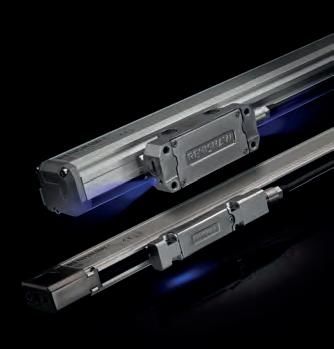
Si tratta di una novità assoluta per il mercato delle tecnologie lineari. Finora la maggior parte delle soluzioni in esecuzione igienica si basavano su unità completamente chiuse» aggiunge Zaniboni.
«I principi Hygienic Design sono stati applicati, ad esempio, anche alla catena portacavi TH3, realizzata con materiale approvato FDA».
igus dispone di un laboratorio interno dove testare le soluzioni, guidando così lo sviluppo di nuovi prodotti e generando contestualmente una grande mole di dati che confluiscono nei configuratori, tool online che permettono agli uffici tecnici dei clienti di confrontarsi con parametri operativi e di disporre di un controllo sull’applicazione a vari livelli, dalla fase di progettazione alla manutenzione preventiva.
«Guardando alla sostenibilità - conclude Olyve - igus ottimizza da sempre le risorse mettendo in campo una varietà di iniziative per la riduzione delle emissioni
di CO2 che includono – oltre alla completa rivalorizzazione degli scarti da produzione - anche il costante aggiornamento del parco macchine aziendale, come la recente sostituzione di 400 macchine da stampaggio a iniezione. A questo si aggiunge lo sviluppo di una gamma di prodotti “ECO” a base di materiale rigranulato come cuscinetti cilindrici e flangiati o cuscinetti a sfere. Infine, grazie al programma Chainge, le catene portacavi igus o della concorrenza, vengono ritirate al termine del loro ciclo di vita, per procedere con la separazione di tutti gli elementi costitutivi e il loro riciclo e riuso.»
L’imaging che guarda al futuro
nn Se si cerca un approccio innovativo ai sistemi di visione e all’imaging, un player di primo piano è Image S, delle cui novità racconta il fondatore Marco Diani: «Mi diverto con l’imaging da 40 anni, quando ho iniziato un percorso di studi sull’imaging che 30 anni fa mi ha portato a fondare l’azienda che, con passione e innovazione, non ha mai smesso di crescere. Nelle soluzioni per il packaging, il nostro approccio cerca di coprire un’ampia parte dello spettro elettromagnetico con particolare focus su terahertz e raggi X».
Tra le soluzioni che Image S può proporre spiccano l’analisi multi-spettrale e iper-spettrale per individuare la composizione chimica del contenuto di un blister: una tecnologia che riteniamo abbia grandi prospettive dovute anche all’ottimizzazione del rapporto prestazioni/prezzo.
«Nell’arco dei prossimi 5 anni ci aspettiamo un incremento nelle prestazioni dei componenti per la realizzazione di sistemi di visione. Anche la velocità e la risoluzione delle telecamere lineari è in costante aumento per andare a leggere oggetti con sempre maggior precisione: gli ultimi modelli consentono di avere 4 bande spettrali R, G, B e NIR. È il caso della telecamera Teledyne DALSA Linea2, con uscita a 5 GigE, che quintuplica la velocità rispetto ai modelli precedenti»
50 anni di Renishaw
nn Celebrata a fine luglio a Torino, nella suggestiva cornice del Museo dell’Auto, la giornata dedicata ai primi 50 anni di attività di Renishaw è stata l’occasione per ripercorrere le tappe di un successo che, in decenni, non ha mai subito rallentamenti. Nel corso della giornata sono stati presentati i nuovi prodotti che l’azienda inglese espone a EMO, in programma ad Hannover dal 18 al 23 settembre. Specializzata in metrologia, controllo di processo e additive manufacturing, Renishaw propone un’offerta basata sulle sue soluzioni di automazione industriale come la piattaforma di smart manufacturing
Renishaw Central, che permette di digitalizzare, visualizzare e quindi controllare i processi di lavoro e di misura con una riduzione delle interruzioni di produzione fino al 69%, confermando le tecnologie Renishaw come strumento ideale per migliorare la produttività, eliminare l’errore umano e ottimizzare i processi produttivi. Guardando poi ai prodotti per la calibrazione delle macchine, core business aziendale fin dalla sua fondazione, ecco la nuova versione 4.8 del pacchetto software CARTO, con il supporto per il sistema di calibrazione multiasse Renishaw XM-60 che migliora il monitoraggio delle macchine di precisione. CARTO, associato a uno dei sistemi multilaser Renishaw per lavorazioni additive (AM) ad alta produttività, permette la fabbricazione di componenti di precisione. Presenti, infine, gli encoder incapsulati FORTiS™, che aiutano i costruttori a realizzare macchine utensili conformi a standard elevati nel pieno rispetto degli standard ambientali.
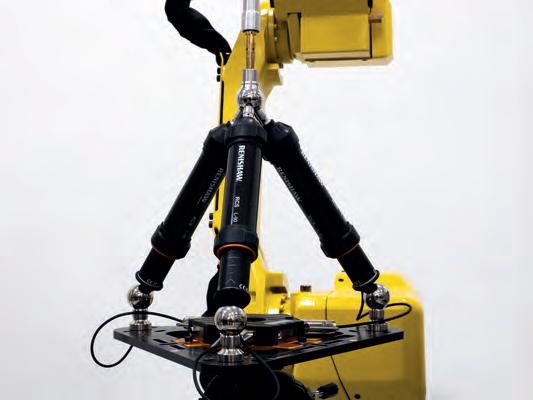
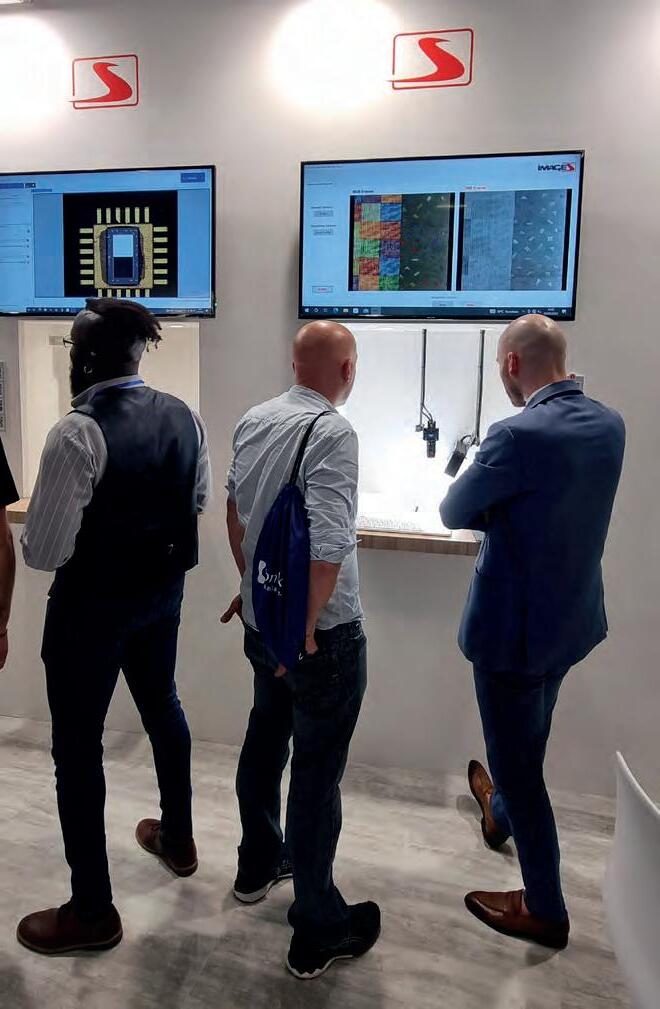
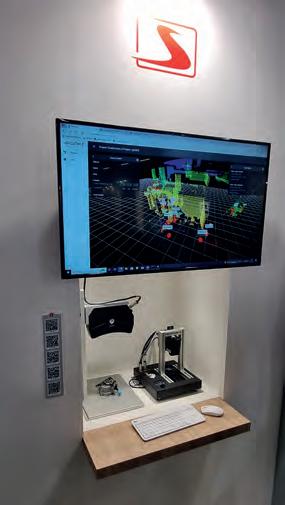
www.italiaimballaggio.it [ AUTOMATION & CONTROLS ] 60 • 9/23
Sistemi efficienti per la movimentazione
nn La trasmissione di potenza è la specializzazione del Gruppo Mondial, presente a SPS con una serie di soluzioni sviluppate con partner tecnologici di primo piano. Lo racconta la Business Unit Manager della Linear Division Faouzia Ben Messaoud. «I nostri prodotti sono usati nel settore assemblaggio e confezionamento in particolare nel food and beverage. Con DTS+ di HepcoMotion presentiamo uno dei sistemi lineari dedicati al mondo dell’imballaggio, mentre con GFX della stessa azienda proponiamo un sistema di guida integrato con motore lineare Beckhoff, garantendo ai nostri clienti flessibilità, versatilità e affidabilità nella movimentazione dell’imballaggio.»
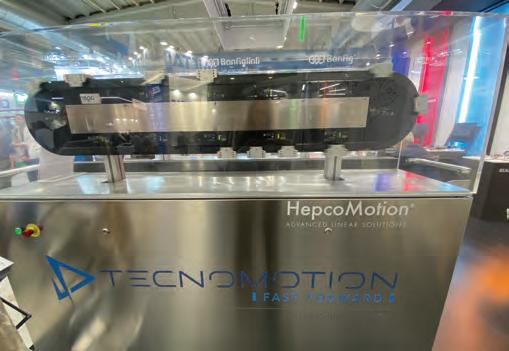
Un successo l’AGV di Robox
nn Dal 1975 Robox è sul mercato con prodotti di elettronica industriale. L’evoluzione più recente vede l’azienda novarese impegnata nello sviluppo di un AGV con caratteristiche di robustezza e affidabilità che rendono il progetto unico nel suo genere. Ce ne parla Marco Bassignana, ingegnere elettronico.
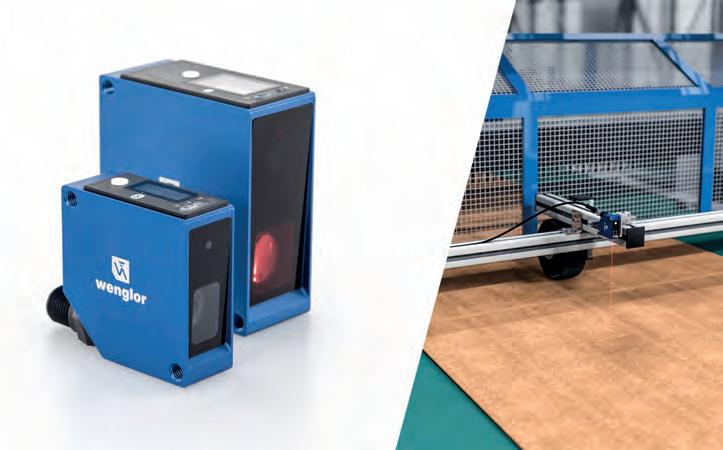

«L’AGV con sistema di controllo è costituito da un giroscopio e un’antenna magnetica che ne guidano i movimenti, seguendo un percorso di auto-localizzazione basato su magneti a pavimento. La connessione Wi-Fi permette di governare l’apparato all’interno del perimetro dello stabilimento attraverso l’AGV manager installato su PC. Tra i vantaggi della soluzione Robox c’è la robustezza rispetto ai più sofisticati modelli basati su laser e sistemi di visione, difficili da mantenere efficienti quando, uscendo dalla sala prove, si entra in uno
Una sensoristica sempre più avanzata
nn I sensori sono protagonisti dei sistemi industriali, tra linee da monitorare, ambienti da controllare e la costante necessità di nuovi dati per la gestione della produzione. Dell’ultima soluzione di wenglor sensoric parla Elio Bolsi, il General Manager della filiale italiana.
«La nostra proposta più recente, è la nuova gamma di sensori di distanza a triangolazione laser della serie P3 indispensabili per misurare oggetti di forma complessa. La soluzione presenta una innovativa progettazione interna, poiché il sensore contiene un ulteriore sensore che permette di misurare la temperatura compensando la deriva termica. I sensori CMOS sono adatti a diverse applicazioni a distanze fino a 1.000 mm. Grazie al procedimento di triangolazione ad alta precisione, i sensori P3 riconoscono anche piccole differenze di altezza con una riproducibilità fino a 0,8 µm.»
stabilimento sporco, con materiali talvolta in disordine e collocati in posizioni non previste; contesti dove serve un AGV robusto come il nostro, che è stato riconosciuto dal mercato con ben 170 installazioni avvenute sul mercato cinese negli ultimi due anni. Si tratta di un aiuto all’operatore umano per attività in ambienti tossici, inquinati e pericolosi.
Pensiamo ad acciaierie o fonderie della plastica, ma anche ambienti ospedalieri dove serve una sanificazione costante. Tra le applicazioni recenti c’è quella per il trasporto di sangue in ambienti ospedalieri, dove ingresso e uscita da una cella frigo e da una sala operatoria, non richiedono le stesse procedure di vestizione e sanificazione che sarebbero imposte a un operatore umano, accelerando così i processi e riducendo i rischi.»
www.italiaimballaggio.it [ AUTOMATION & CONTROLS ] 9/23 • 61
sss
Events and trade fair make the summer automation season special
There are many new developments on the automation front that have enlivened the beginning of summer 2023, including trade fair events and celebrations of decades-long corporate journeys, as in the case of Renishaw, which has celebrated its 50 years in an event dedicated to customers and the press.
Talking of events, we will continue by “recounting” the 2023 edition of SPS (concluded on 25 May), which saw a rich array of automation proposals, appreciated by the over 39,000 visitors that crowded into the pavilions.
nn High-performance techno-polymers for any type of movement
Igus motion plastics’ offer includes also a series of interesting solutions to the requirements of the food, beverage and pharma markets, without forgetting sustainability. We talked about this with Matteo Zaniboni, Central/South Italy Area Manager and specialist in the Packaging sector and Marie Olyve, Marketing manager.
«Igus is very oriented towards food and pharma packaging - Zaniboni begins – sectors in which the use of plastic is essential. We process highperformance polymers with excellent friction and wear resistance properties.
Walking through the stands, the editorial staff of ItaliaImballaggio met a number of important national and international operators that presented their best solutions, including robotics, ready industry 4.0 systems, components and sensors. We managed to talk with some of them in the June and July/ August editions (B&R, Bosch Rexroth, Beckhoff, wittenstein, Emerson, Pilz) and in this issue of the magazine we give the floor to Image S, Mondial, Wenglor, Robox and igus. Let’s see how it went, in the voices of the protagonists.
Among new developments there are as many as 7 materials approved for food use, including bars, plates, tape materials for gluing and powder for the coating of metal surfaces. In addition, specifically for pharma, there is the range of cogwheels with dimensions from 3 to 200 mm, on which we constantly carry out research to make them suitable for environments in which there is extensive use of sanitizers and sanitizing products. Cable drag chains and guides predisposed for the clean room, without lubrication and very silent as they are without balls or metal systems, and therefore ideal for the pharmaceutical and hospital sectors, also belong to this category.»
Igus, a long-standing member of the EHEDG association, has developed the first system of linear guides based on Hygienic Design principles. The use of materials complying with the FDA regulations, such as, for example, the iglidur A160 high-performance
polymer, high alloy stainless steel, the self-draining structure and the washable interior of the trolley guarantee compliance with the hygienic design standards.
«We have launched a guide that can be cleaned without dismantling- Zaniboni continueswith an innovative trolley specially designed for food. Besides the material in itself, in fact, the hygienic design of components is important. The slide made of iglidur A160 material is selfdraining: it facilitates cleaning operations, allowing the liquids and detergents to drain away freely. It’s an absolutely new development for the linear technologies market. So far, most hygienic design solutions have been based on completely closed units» adds Zaniboni. «Hygienic Designs principles have been applied, for example, also to TH3 cable drag chains, made in FDA-approved material». igus has an internal laboratory where to test the solutions, guiding, therefore, the development of new products and generating at the same time a large amount of data that channels into the configurators, online tools that allow customers’ technical offices to deal with operating parameters and have control over the application at various levels, from the design phase to preventive maintenance.
«Looking at sustainabilityconcludes Olyve - igus has always optimised resources, undertaking a series of initiatives to reduce CO2 emissions, which includebesides the complete recovery of production waste - also the constant updating of the company’s machinery, like the recent replacement of 400 injection moulding machines. In addition, there is the development of a range of “ECO” products made of re-granulated material, such as cylindrical and flanged bearings or ball bearings. Finally, thanks to the Chainge programme, igus or competitor cable drag chains are withdrawn at the end of their life-cycle for subsequent separation of all their constituent parts and their recycling and reuse.»
nn Imaging that looks to the future
If you’re looking for an innovative approach to vision systems and imaging, one of the leaders is Image S, whose new developments are here described by the founder Marco Diani: « I started to enjoy imaging 40 years ago, when I began an imaging course that then 30 years ago led me to found the company which, with thanks to passion and innovation, has never stopping growing.
In solutions for packaging, we try to cover the whole electromagnetic spectrum, with a particular focus on terahertz and X-rays. The solutions that Image S is able to offer include multispectral and hyperspectral analysis for identifying the chemical composition of the contents of a blister: a technology that we believe has great potential also thanks to the excellent performance/price ratio.
www.italiaimballaggio.it [ AUTOMATION & CONTROLS ] 62 • 9/23
Over the next 5 years we expect an improvement in the performance of components for the development of vision systems. The speed and resolution of linear video cameras is constantly increasing for reading objects with ever greater precision: the latest models make it possible to have 4 spectral bands, R, G, B and NIR. This is the case of the Teledyne DALSA Linea2 video camera, with 5 GigE output, which quadruples the speed with respect to previous models. »
nn 50 years of Renishaw
Celebrated at the end of July in Turin, in the fascinating setting of the Automobile Museum, the day dedicated to the first 50 years of Renishaw’s activity was an opportunity to retrace the milestones of a success which, over the decades, has never faltered. During the day, the new products that the English company will be exhibiting at EMO scheduled at Hanover from 18 to 23 September were presented. Specialised in metrology, process control and additive manufacturing, Renishaw’s offer is based on its industrial automation solutions such as the Renishaw Central smart manufacturing platform, which makes it possible to digitalise, visualise and therefore control work and measurement processes with a reduction of production stoppages of up to 69%, confirming how Renishaw technologies are the ideal tool for improving productivity, eliminating human error and optimising production processes.
Looking then at products for machine calibration, a core business of the company right from the company’s beginning, there is the new 4.8 version of the CARTO software package, with the support for the Renishaw XM-60 multi-axis calibration system which improves the monitoring of precision machines. CARTO, combined with one of the Renishaw multilaser systems for high-productivity additive manufacturing (AM), permits the manufacture of precision components. Finally, there is the FORTiS™ encapsulated encoders, which help manufacturers to produce machine tools conforming to high standards in full compliance with environmental standards.
nn Efficient handling systems
Power transmission is the specialisation of Gruppo Mondial, present at SPS with a series of solutions developed with top technological partners. This is what was explained by Business Unit Manager of the Linear Division, Faouzia Ben Messaoud. «Our products are used in the assembly and packaging sector, in particular, in food and beverage. With HepcoMotion’s DTS+, we present one of the linear systems dedicated to the world of packaging, while with GFX, of the same company, we offer an integrated guidance system with a linear Beckhoff motor, guaranteeing our customers flexibility, versatility and reliability in packaging handling. »
nn The Robox AGV is a success
Robox has been operating on the market with industrial electronics products since 1975. The most recent evolution sees the Norwegian company committed to the development of an AGV with sturdiness and reliability characteristics that make the project unique of its kind. Marco Bassignana, electronic engineer, told us about it.
«The AGV with a control system is composed of a gyroscope and magnetic antenna that guide its movements, following a selflocating path based on floor magnets.
The Wi-Fi connection makes it possible to control the device within the perimeter of the factory through the AGV manager installed on a PC. Among the advantages of the Robox solution there’s the level of robustness compared to more sophisticated models based on laser and vision systems, difficult to keep efficient when, once leaving the test centre, they enter a dirty factory, with materials sometimes in disorder and placed in unexpected positions: contexts that need a robust AGV like ours, which has been recognized by the market with as many as 170 installations in the Chinese market in the last two years. It is an aid to the human operator for activities in toxic, polluted and hazardous environments. We can refer to steel mills or plastic foundries, but also hospital contexts where constant sanitization is needed. Among recent applications there’s the transportation of blood in hospitals, where the entrance and exit to and from a cold cell and an operating theatre does not require the same clothing and sanitisation procedures that would be imposed in a human operator, thereby accelerating the processes and reducing the risks.»
nn Increasingly advanced sensors
Sensors are protagonists of industrial systems, with lines to monitor, environments to control, and the constant need for new data for production management. Elio Bolsi, the General Manager of the Italian subsidiary, talks about wenglor sensoric’s latest solution. «Our most recent proposal is the new range of distance sensors with laser triangulation in the P3 series, essential for measuring objects with complex shapes. The solution has an innovative internal design, as the sensor contains a further sensor that makes it possible to measure the temperature, compensating for thermal drift. The CMOS sensors are suitable for various applications at distances of up to 1,000 mm. Thanks to the highprecision triangulation procedure, the P3 sensors recognise also small differences in height with a reproducibility of up to 0.8 µm.»
www.italiaimballaggio.it [ AUTOMATION & CONTROLS ] 9/23 • 63
www.italiaimballaggio.it [ ADVERTISERS ] 9/2023 64 • 9/23 INSERZIONISTI ADVERTISERS INSERZIONISTI ADVERTISERS INSE A CO&MA SRL ......................................... 54 D DIMONTONATE FLOCCATI SPA 45 G G.B. GNUDI BRUNO SPA ................ 14-15 I IMA INDUSTRIA MACCHINE AUTOMATICHE SPA............................... 4 INFOPRO DIGITAL TRADE SHOWS ........ 6 K KARR ITALIANA SRL ............................ 29 KOELN PARMA EXHIBITIONS SRL......... 3 M MESSE FRANKFURT ITALIA SRL ......... 12 N NIMAX SPA 28 NÜRNBERGMESSE GMBH ................... 53 R ROBATECH ITALIA SRL U.S. .................. 7 RONCHI MARIO SPA .................... IV Cop. S SERVOTECNICA SPA .................... III Cop. SUN CHEMICAL GROUP SPA ......... II Cop. U UNICOM INTERNATIONAL BARANSKI SP. K. 9 V VERIMEC SRL....................................... 23 W WORLD JET SRL................................... 25 A ACIMGA 40 ACMA SPA 52 ANIE 39, 42 ARGAN COSMETICS SAS 10 ARTESTAMPA SRL 16 ASSOCARTA 40 ASSOGRAFICI 35, 40 AUROFLEX SAS 16 B BECKHOFF AUTOMATION SRL 59 BERLIN PACKAGING ITALY SPA 13 BOLOGNAFIERE COSMOPROF SPA 26, 39 BOSTON CONSULTING GROUP 29 C CARLO GASPERINI SNC 16 CARTON GROUP GMBH 39 CO.RE.VE. CONSORZIO RECUPERO VETRO 47 COMIECO 35, 47 CONAI 35, 47 CONFINDUSTRIA 40 CONTITAL SRL 8 COUCHBASE 34 E EASYFAIRS ITALIA SRL 16 EASYFAIRS ORIEX 16 ECOFOAM NATURE S.L 46 EUROPOLIGRAFICO SPA 39 F FAVINI SRL 8 FEDERAZIONE CARTA GRAFICA 40 FEDRIGONI SPA 10 FKUR ITALIA SRL 48 FONDAZIONE ALTAGAMMA 29 FONTANA GRAFICA SRL 16 G GOGLIO SPA 44 GRAFICAL SRL 16 GRAFICHE BRAMUCCI SRL 10 GS1 ITALY 44 H HERRMANN ULTRASCHALLTECHNIK GMBH & CO. KG 55 I IGUS SRL 59 IMA IND. MACCHINE AUTOM. SPA 51 IMAGE S SPA 59 ISEM SRL 10 ISTITUTO IT. IMBALLAGGIO 8, 35 L LEONHARD KURZ STIFTUNG & CO. KG 16 LUXORO SRL 10 M MARCHESINI GROUP SPA.......................50 MAX MARRA 2 MC KINSEY & COMPANY 26 MECS SRL 31 MEGA EMBALAGENS 44 MESSE DÜSSELDORF GMBH 51 MESSE FRANKFURT ITALIA SRL 42, 59 MONDIAL SPA 59 MORDOR INTELLIGENCE 52 N NILPETER SRL 16 O OROPRESS SPA 16 P P&P PROMOTION SRL 16 PIBIPLAST SPA 10 PRATI SRL....................................................56 R RENISHAW SPA..........................................59 RILEGNO 47 ROBOX SPA 59 S SEA VISION SRL 50 SEVEN FLUSS SRL 54 SIMEST SPA 39 T TÜV ITALIA SRL 43 U UCIMA 31 V VIMER SRL 16 W WENGLOR SENSORIC ITALIANA SRL 59 WITTENSTEIN SPA 58
Enti, aziende e associazioni citate su questo numero
ATTUATORI LINEARI INTEGRATI



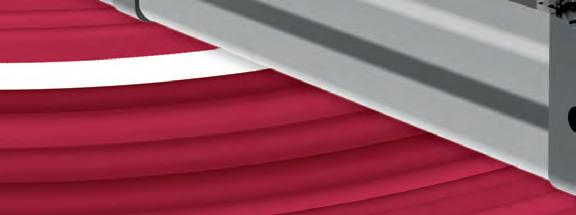

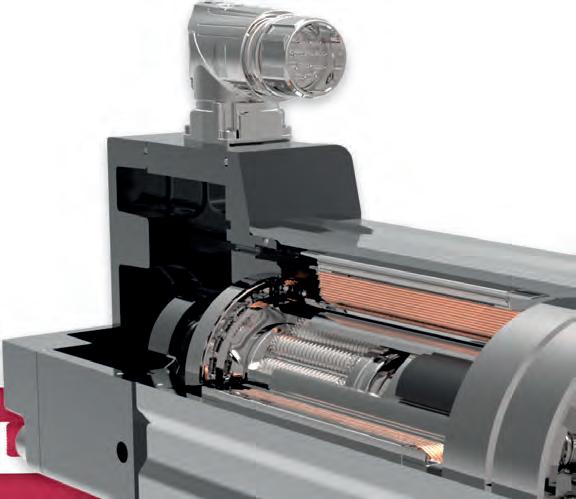

















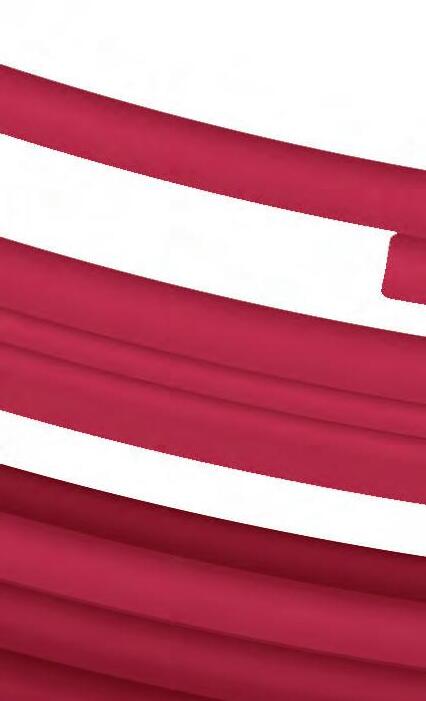





 Efficienti
Alta forza
Compatti
Efficienti
Alta forza
Compatti


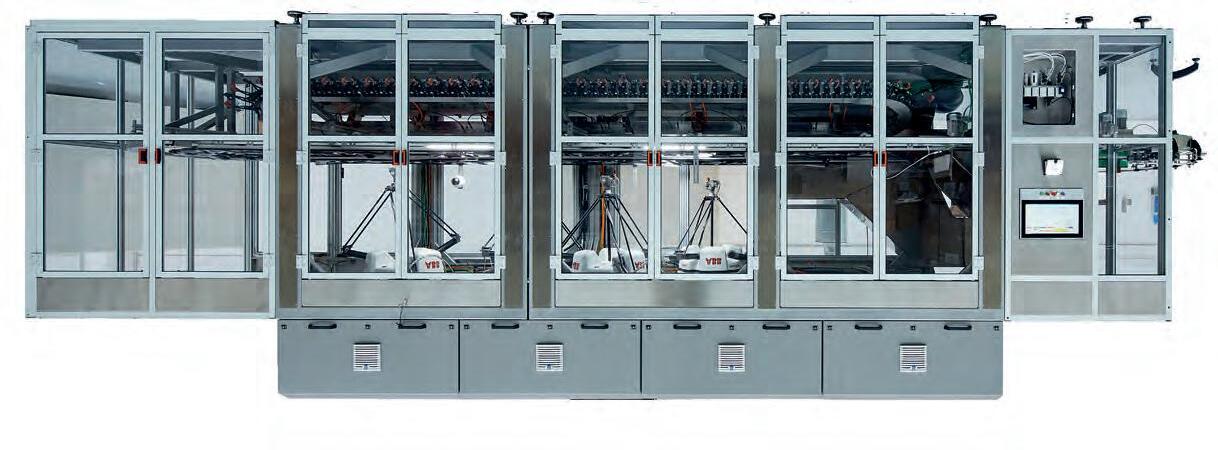





 lodando.
Stefano Lavorini
lodando.
Stefano Lavorini












































































































































































